
BABY SEASON AT THE WILDLIFE CENTRE
AN OBSESSION WITH TREES
THE BLUES AND JAZZ FESTIVAL TURNS 20
THE RETURN OF ANALOG









BABY SEASON AT THE WILDLIFE CENTRE
AN OBSESSION WITH TREES
THE BLUES AND JAZZ FESTIVAL TURNS 20
THE RETURN OF ANALOG


























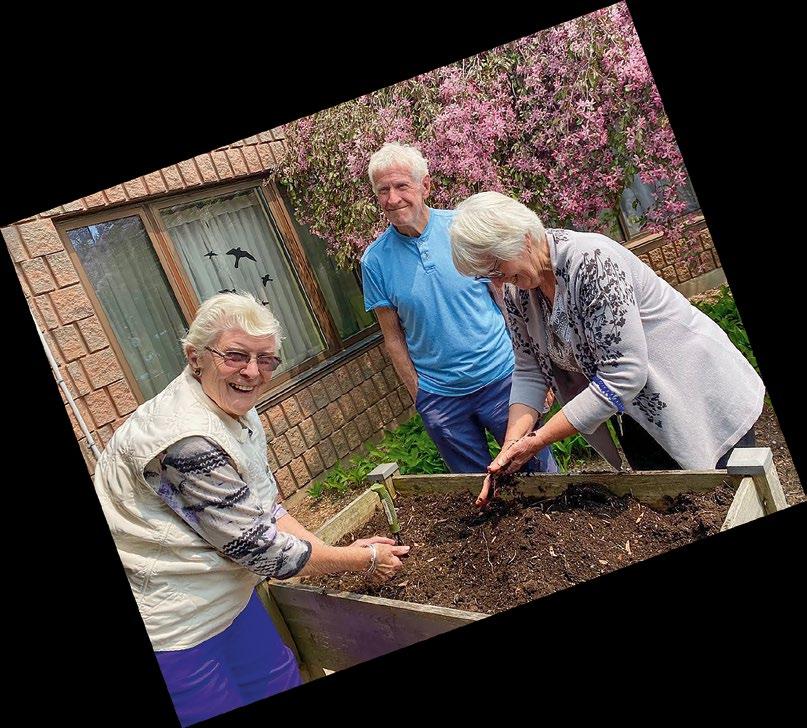













Tree Removal & Pruning
Lot Clearing
Stump Grinding
Forestry Bucket Truck Service
Utility Line Cleaning

Design / Build / Install
Interlock & Natural Stone Water Features
Grading & Excavations
Insulated Concrete Pools
Garages, Shops & Storage
Pole Barns
Helical (Screw) Piles
Insulated Concrete Foundations
Decks & Fences






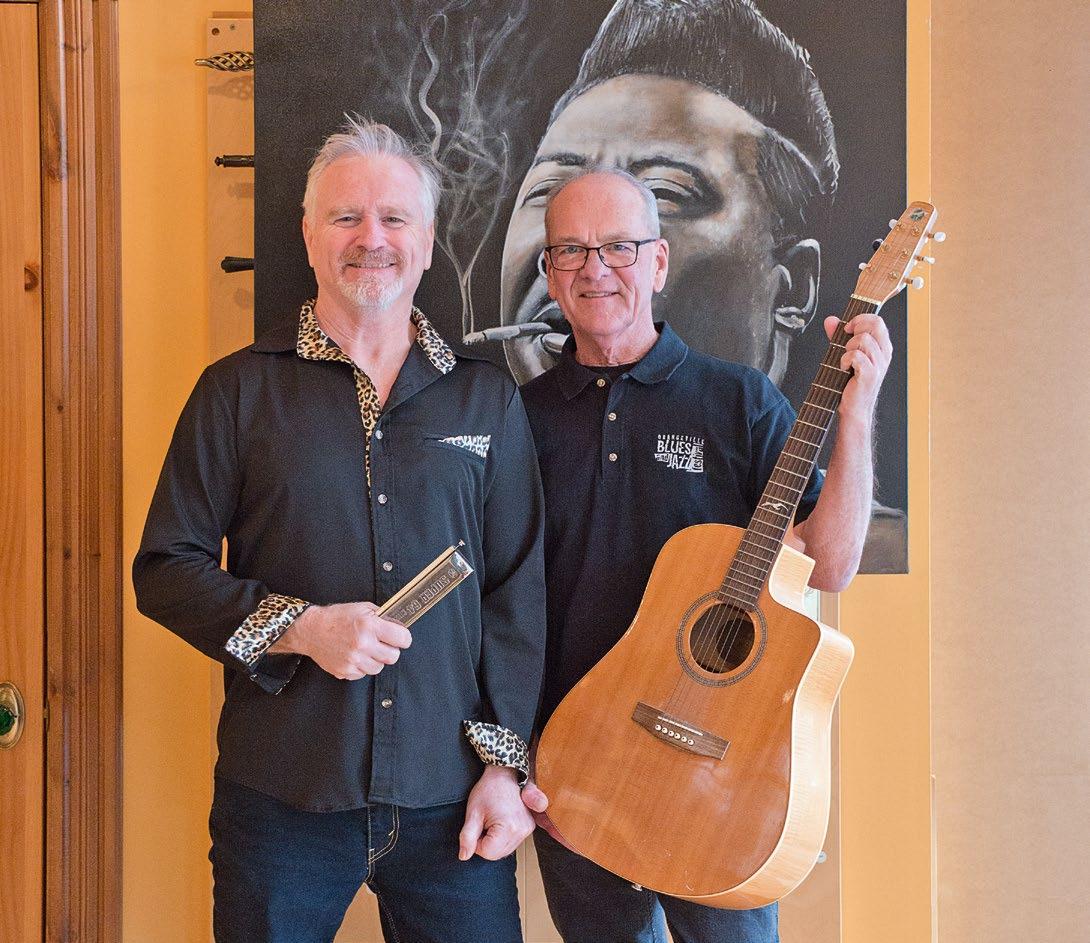
30 A MAGNIFICENT OBSESSION
Collecting and nurturing remarkable trees has been a 30-year passion for Caledon’s Gary Haslett
BY DON SCALLEN38 LET THE GOOD TIMES ROLL
The Orangeville Blues and Jazz Festival celebrates 20 fabulous years of filling a small town with big sounds
BY TONY REYNOLDS48 IT’S BABY SEASON AT THE WILDLIFE CENTRE
The spring rush of young, orphaned or injured animals marks the start of another busy year at Procyon Wildlife and Rehabilitation Centre
BY DON SCALLEN56 A GUIDE FOR LOOPY HIKERS
An excerpt from a new book by Nicola Ross in which she offers 40 loop hikes for Bruce Trail end-to-enders
62 ALISON AND JIM
Her life is separated from artist J.E.H. MacDonald by nearly a century, but Alison Douglas has come to know the painter with microscopic intimacy
BY ANTHONY JENKINS68 AN AFFINITY FOR ANALOG Steeped in digital culture, some millennials and gen-Zers are hungry for vinyl records, processed film, paper journals and real books
BY JANICE QUIRT79 WILLIAM ALGIE
Alton manufacturer, master storyteller and community builder
BY NANCY EARLY











20 LETTERS
Our readers write
23 ARTIST IN RESIDENCE
Painter Deb Menken
25 FIELD NOTES
Celebrate Caledon, volunteer on a farm and watch the life aquatic
BY JOHANNA BERNHARDT29 FENCE POSTS
The money pit
BY DAN NEEDLES74 FOOD AND DRINK
Try a sweet treat from Japan and scrumptious Sunday fare
BY EMILY DICKSON85 MEET THE MAKER
Andrea Trace makes an impression
BY JANICE QUIRT
87 MADE IN THE HILLS
Local handmade treasures
BY JANICE QUIRT89 COUNTRY LIVING 101
Trail cams: a watch on the wild side
BY ANTHONY JENKINS90 A DAY IN THE LIFE
Secondary school tech teacher
Andrea Phillips
BY JANICE QUIRT93 TAKE A HIKE
Dufferin County Forest Little Tract
BY NICOLA ROSSFAMILY OWNED AND LOCALLY
94 HEADWATERS NEST
The long goodbye BY BETHANY LEE
96 OVER THE NEXT HILL
Riding the medical merry-go-round BY GAIL GRANT
98 AT HOME IN THE HILLS
Elaine Woodward’s bright idea BY GAIL GRANT
116 WHAT’S ON A calendar of spring happenings
126 FIND AN ADVERTISER
130 BACK STORY
A Caledon farm was a touchstone for director Norman Jewison BY DYANNE
RIVERS
FOR
YEARS!

I
PUBLISHER & EDITOR
Signe Ball
DEPUTY EDITOR
Tralee Pearce
ASSOCIATE EDITOR
Dyanne Rivers
ART DIRECTOR
Kim van Oosterom Wallflower Design
PHOTOGRAPHERS
Erin Fitzgibbon
Rosemary Hasner
Pete Paterson
Gillian Stead
ILLUSTRATORS
Shelagh Armstrong
Ruth Ann Pearce
Jim Stewart
WRITERS
Johanna Bernhardt
Emily Dickson
Nancy Early
Gail Grant
Anthony Jenkins
Bethany Lee
Dan Needles
Janice Quirt
Tony Reynolds
Nicola Ross
Don Scallen

ON OUR COVER A baby porcupine at Procyon Wildlife and Rehabilitation Centre, by Rosemary Hasner
In The Hills is published quarterly by MonoLog Communications Inc. It is distributed through controlled circulation to households in the towns of Caledon, Erin, Orangeville, Shelburne, Creemore, and Dufferin County.
Annual subscriptions outside the distribution area are $29.95 for 1 year and $53.95 for 2 years (including HST).
© 2024 MonoLog Communications Inc. All rights reserved. No reproduction by any means or in any form may be made without prior written consent by the publisher.
For information regarding editorial content or letters to the editor: 519-942-8401 or sball@inthehills.ca.
Find us online at www.inthehills.ca Like us facebook.com/InTheHills Follow us twitter.com/inthehillsmag and instagram.com/inthehillsmag
REGIONAL SALES MANAGERS
Roberta Fracassi
Erin Woodley OPERATIONS MANAGER
Cindy Caines Dillman
Marion Hodgson
Type & Images EVENTS & COPY EDITOR
Janet Kerr
DIGITAL EDITORS
Emily Dickson
Janice Quirt
For advertising, contact one of our regional sales managers:
Roberta Fracassi
519-943-6822, roberta@inthehills.ca (Orangeville, Shelburne, Creemore and areas N of Hwy 9)
Erin Woodley
519-216-3795, erin@inthehills.ca (Caledon, Bolton, Erin and areas S of Hwy 9)
The ad booking deadline for the summer (June) issue is Friday, May 10, 2024.
Canada Post Agreement Number 40015856
We acknowledge the support of the Government of Canada.












I recently read a story in The Atlantic titled “Gen Z Never Learned to Read Cursive.” The author, former Harvard president Drew Gilpin Faust, relates her discovery that about two-thirds of the students in an undergraduate seminar she had been teaching couldn’t read the handwritten Civil War manuscripts they had been assigned to review.
Her shock was similar to my own when I discovered my teenage granddaughter, Kate, needed a translator to read the birthday note I gave her. Kate is the cohort of one by which I measure all changing norms.
Many of those changes are little things that bear on not much. On a trip to an antique market, Kate was intrigued by an old camera with an accordion lens. Holding it at arm’s length, she puzzled, “How do you see what you’re trying to photograph?” On a ride in a vintage car, she was asked to roll down the window. She fumbled at the door, then asked. “Where’s the button?” And she has only a passing acquaintance with compass points – her phone does the navigating. Once as I recounted getting lost while driving through the industrial wasteland near the airport, I mentioned I had kept the setting sun on my left knowing I was heading north and would find a familiar road soon enough. Kate was as awed by the strategy as if I’d been following day-old wolf tracks.
Gilpin Faust notes that in the arc of history, the widespread ability to write is itself is a relatively recent development. Once mostly exclusive to the privileged, it wasn’t until the mid-19th century that “more than 90 per cent of the white population in America could both read and write.” She concludes that for better or worse, cursive writing will inevitably be lost. In the future, she speculates, we will “become reliant on a small group of trained translators and experts to report what history – including the documents and papers of our own families – was about.”
Or maybe not. As Janice Quirt reports in this issue, the digital native generation are discovering for themselves the tactile and soul-soothing pleasures of engaging with the analog world – vinyl records, film cameras, real books and, yes, handwriting. Hard to say if it’s just a fad, or whether millennials and gen-Zers really are finding their own healthy balance between the undeniable efficiencies of technology and what 16-year-old Flora Dickison describes as the “old school” ways that are “more creative, flexible to our own personalities, and a perfect way to escape.”
As for Kate, now 19 (and able to accurately two-thumb type on her phone without looking at the keyboard – a feat of astonishing dexterity to me), she taught herself cursive writing and takes her university lecture notes by hand, because, she says, “it’s the only way I can remember them.”






Janice Quirt
Janice is a writer and communications professional who lives in Orangeville with her partner John, son Josh and daughter Daisy. Janice loves walking to downtown Orangeville, constantly balancing her desire to collect vinyl records and thrift mid-century modern ceramics with her minimalist streak – the solution comprises window shopping and library books.
In this issue Janice penned two contrasting pieces: “A Day in the Life” with technology design secondary school teacher Andrea Phillips; and a feature on younger generations embracing analog passions, with her daughter as one of the subjects.
“I can love the tactile nature of analog records, books, photos, and paper and pen while still being transfixed by the creative pathways opened by digital technology, and I think it’s healthy to dabble in both worlds.”

Don Scallen
Don Scallen loves nature. He is fascinated by the natural history of plants and animals and their interactions with the environment. His heroes include Charles Darwin, Jane Goodall and the venerable David Attenborough. Here’s an Attenborough quote that resonates with Don: “It seems to me that the natural world is the greatest source of excitement; the greatest source of visual beauty; the greatest source of intellectual interest. It is the greatest source of so much in life that makes life worth living.”
Don writes frequently about nature for In The Hills and, in 2020, published his first book, Nature Where We Live: Activities to Engage Your Inner Scientist from Pond Dipping to Animal Tracking. He enjoys speaking to naturalist clubs, horticultural societies and environmental groups about diverse nature-oriented topics.







Cindy Caines Dillman
“Once In The Hills hooks you, you're hooked for life,” says the magazine’s beloved operations manager, Cindy Caines Dillman, who has worked here since 2013 and considers it “my magazine” in many ways.
On the home front Cindy has been busy. She married her longtime partner, Ken, in June of 2023. Their blended family consists of three grown children, one teenager and one grandchild (born in June 2022) with two more on the way. “My heart is overflowing!” she says.
In addition to other passions – reading, crocheting, camping and cruising – Cindy maintains a consistent fear of spiders – stemming, she says, from her mother’s arachnophobia. “She actually threw a shoe at me – to save my life, I’m sure – when I was about eight because I had one in my hair!” Born in Newfoundland, Cindy considers herself a small-town girl at heart. “Spiders are everywhere, so I may as well live somewhere I love.”










































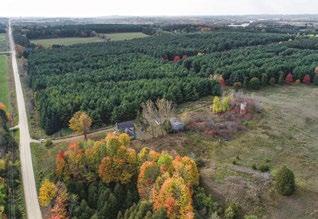
Like Dan Needles, I too miss the local news. I once had business that took me halfway around the world repeatedly, but no longer. “Retired” on my isolated farm, my world grows smaller, and I want news closer to home. By-laws are more important than e-laws.
As one person in 40 million, there is little I can do as my influence is minute. I’m more interested in local political decisions because they occur faster and affect me directly. My opinion is about 100,000 times more significant in a smaller population, so I need to know what happens about water, store prices and the weather today.
There is only one printed newspaper now, and I visit town about twice a month for a paper that is no longer delivered. Hog and corn prices that were once radioed daily are no longer mentioned. City crimes may be important to GTA readers, but they are not important to me.
— Charles Hooker, East Garafraxa
Regarding your “In Retrospect” pages in the recent winter issue: My paternal grandmother was a life member of the Mono Road Women’s Institute (Caledon), serving for years as their secretary. I have her pin and know what the friendship found in those gatherings of rural women meant to her as a WWI war bride. The reflection on the William Perkins Bull convalescent hospital in London brought back fond memories of researching and curating an exhibition on that hospital at the Peel Archives many years ago, and sharing story ideas with [In The Hills’ “Historic Hills” columnist] Ken Weber. Then there was the photo in “The Day the Arrow Died” featuring my dad and his two brothers. Wow! Not often one sees so much of one’s life and connections reflected in a magazine spread. I am so proud to have made some small contributions to In The Hills over the years. It is eagerly awaited and kept for years. Best of luck for the next 30 years!
— DianeAllengame, retired archivist, Peel Archives, Mulmur
Kindness
& U.B., CALEDON
Re: Editor’s Desk “The Case for Kindness” [winter ’23]: The beginning and the ending lines of the quoted Women’s Institute poem were enough to bring tears to my eyes and a shiver to my body. Pettiness replacing kindness indeed – what has happened to “doing unto others as you would have them do unto you”? Thank you for reminding us all that we can be kind. Every single day. —
Sheilagh Crandall, CaledonWe welcome your comments! For more reader commentary, or to add your own thoughts on any of the stories appearing in this issue, please visit inthehills.ca. You can also send your letters by email to sball@inthehills.ca. Include your name, address and contact information. In The Hills reserves the right to edit letters for publication.










Whether she’s painting colour-drenched florals, rugged landscapes or, more recently, energetic windswept-looking abstracts, Mono artist Deb Menken is chasing a singular visceral response in viewers. “My main goal is joy,” says Deb, a member of Headwaters Arts and a recipient of the Dufferin Arts Council’s Reed T. Cooper bursary in 2023. She recently held her first solo show at the Alton Mill Arts Centre. Her upbeat canvases burst with cheerful blues, soft greens and multiple shades of white – punctuated by shadows, line drawings and curious details. An intuitive painter, Deb eschews colours straight from the tube, instead mixing her acrylic shades on the go. She doesn’t fuss about finding the perfect match when she runs out, either. “That’s the beauty of it, all the variation. It all works together.” www.debmenken.com

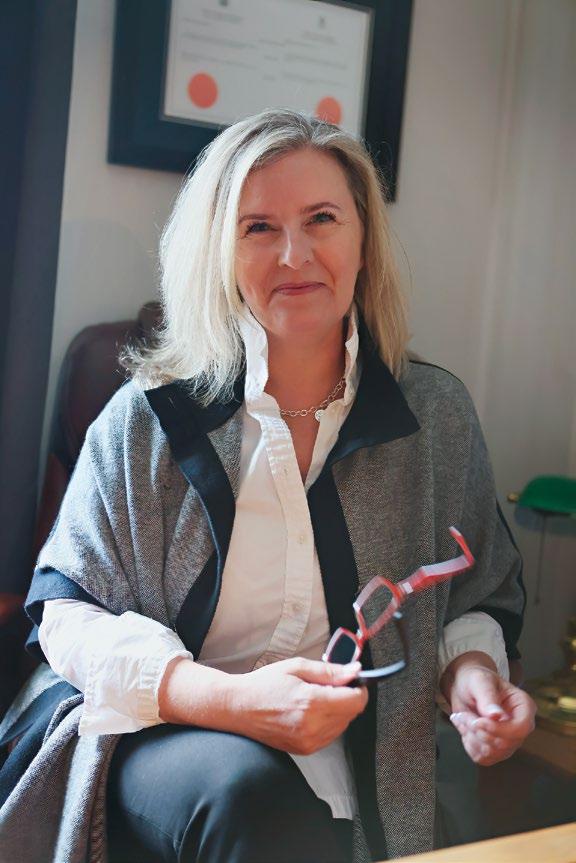





Look out Fireplace Channel! Local brook trout star in two videos that are just as soothing. The Coalition for the West Credit River operates a live video feed of one of Southern Ontario’s few remaining self-sustaining native brook trout populations. After a winter hiatus it will be back online in May and run until mid-November – and you can watch the fish swimming freely and going about their business.
The coalition aims to raise awareness of the risk to the species posed by the proposed Town of Erin wastewater treatment plant. Coalition member John Monczka of Toronto says the group has connected with schools in Erin and Belfountain to share the project. Beyond “the cool factor” of the live feed, he says, “there’s the potential for some citizen science as well. These kids are the future, and the more you get them engaged with this place, the more likely they are to keep it protected.” The coalition’s site features a video made with a Belfountain class who were invited on a field trip in November to remove the cameras for the winter. And another brook trout aquatic closeup, Living on Borrowed Credit, is a mustwatch short video from Steve Noakes and the Mississauga-based Izaak Walton Fly Fishing Club, whose members fish in the Credit and Grand rivers in Headwaters. The club hopes to inspire the community to volunteer and donate to help protect this vulnerable species and waterscape.
The videos are available on YouTube or visit this story at www.inthehills.ca
On June 15, Caledon Day marks the town’s 50th birthday. Starting at 2 p.m. and stretching into the evening, expect family activities, a local beer and cider zone, performances, including the Sam Roberts Band, and fireworks. This free event takes place at the Caledon East Community Complex and is one of the few days of the year you can see fireworks in Caledon.

On May 5, join registered forest therapy guide Janette Cridland to experience the evidence-based healing of being among the trees during her Spring Guided Forest Therapy Walk at Albion Hills Conservation Park. Janette explains, “It’s not an interpretative walk or exercise. It’s an embodied experience of engaging with all of your senses.” This event takes place at 1 p.m. and requires registration.









Explore the ways transportation impacted Dufferin County at the Museum of Dufferin’s latest exhibit, Rumble, Honk, Choo-Choo! Dufferin County on the Move Check out artifacts and images of trains, early cars and agricultural vehicles. Vote for your favourite method of transportation at the voting station or leave a note on the Travel Memories Wall about your favourite travel memory.
The exhibit runs from March 9 to May 25 in the Silo Gallery.
Celebrate Sikh Heritage Month this April at the Peel Art Gallery, Museum and Archives which is featuring an exhibition on social justice, workshops and panel discussions, and children’s activities all through the month. The Sikh Heritage Month Foundation sponsors free admission for all.
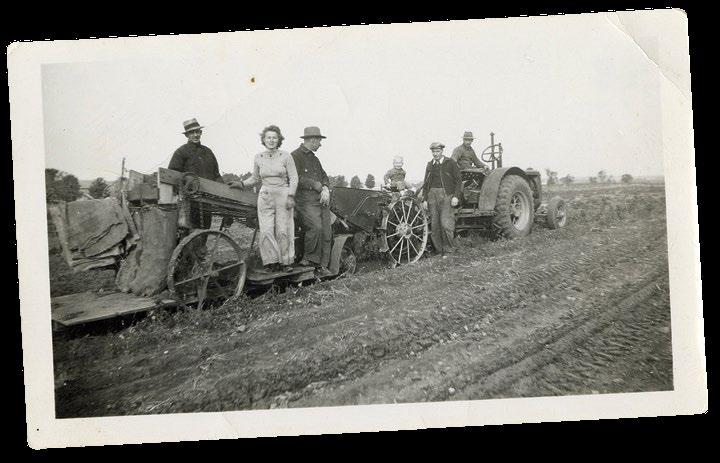
Shake off the winter blues with one of many local live music outings.
The Busholme Restaurant and Bar in Erin makes it easy to linger over dinner with a spring lineup that includes blues legend Jack de Keyzer on April 6 and Sandra Bouza performing Alanis Morissette’s hits on May 11. These events are ticketed. Check the Busholme website for start times.
If it’s classical you’re after, Caledon Chamber Concerts presents the Venuti String Quartet on April 13 at St. James Anglican Church in Caledon East. In Orangeville, Westminster United Church hosts Brightest and Best on Broadway. See jazz saxophonist Ryan Grist, soprano Elisabeth Dubois, and others on April 13, in support of The Kitchen Table project, which provides food and necessities to local people in need. Also at Westminster is the 25th annual Orangeville & District Music Festival from April 29 to May 1. This noncompetitive event provides performance opportunities for musicians of all abilities and disciplines.
From April 25 to May 12, Theatre Orangeville explores the early days of vaudeville with the musical The Darktown Strutters’ Ball. The production is based on and named for Canadian-born American songwriter Shelton Brooks’ famous song, which, in 1917, was the first jazz recording ever made.
Make your own music Wednesdays from 3–4:30 p.m. at the Jam Space at Dufferin Child & Family Services in Orangeville. This fun, therapeutic program is designed to help kids try a variety of instruments under the guidance of a trained music therapist.
Outdoor farmers’ markets are back! Start your weekend on the right foot by picking up delicious local foods and specialty goods at a market near you in Grand Valley, Erin, Creemore or Orangeville.
In Creemore, visit the Indigenous Market hosted by Indigenous Tourism Ontario and the village on June 16. The event will highlight Indigenous makers, chefs, artisans and performers. The ITO hopes to make this an annual event to support Indigenous product development and experiences that encourage the growth of Indigenous tourism in Ontario.
The Caledon Dufferin Women’s Show will be offering a sip-and-shop Mommy Market on May 3 at Monora Park Pavilion in Mono.
Volunteer at Everdale Farm’s weekly Harvest Day on any Wednesday afternoon from June to August to help dig carrots or pick beans. The work is suitable for all ages and abilities; high school kids are encouraged to apply.

Everything you harvest will be donated to local community members who can’t afford fresh food — the program has already donated over 100,000 pounds.








WHEN MY WIFE AND I MOVED HERE TO LIVE full-time on our country property, my neighbour Hughie McKee, the farmer next door, came over to inspect the foundation that the backhoe had just dug to prepare for an addition to our century farmhouse, a rickety old frame building I first started patching up ten years earlier, in 1978.
“That’s a big hole, Danny,” he said. “A beautiful hole. Why don’t you fill half of it in?”
It was good advice, but I was young, I was on a farm, and we hadn’t begun to talk about our ecological footprint in those days. Hughie already understood that concept very well because he was born in these windy hills and had spent many winters here. He looked skeptically at the old house.
“I should have burned this place down when I had the chance. I didn’t know it was you that was going to buy it. Now you’re stuck with it.”
Shortly after the addition was finished, I won a $10,000 writing prize and the local paper called to ask what I planned to do with the money. I didn’t want to sound like a flake, so I said I would put it away for the children’s education. That night, a storm whipped in off the lake and blew the furnace chimney off the roof of the old part of the house. The fuel company came out the next day and reported the chimney was rotted out all the way down to the furnace and it needed to be replaced. Then they discovered holes in the fire pot and decided I needed a new furnace. While the guys were installing that, there was a flash in the panel and they asked me, “Did you have a heat pump?”
By the end of the week, my cash prize was gone, except for a few hundred dollars that I spent on tickets to the award dinner for friends and family.
The house has cleaned me out regularly since then. Recently, I replaced the washer and dryer, water heater, water pump and pressure tank, water softener, iron filter, dishwasher, freezers, brick chimney and several light fixtures – everything had happened to hit the 25-year mark all at once
Hughie looked skeptically at the old house. “I should have burned this place down when I had the chance. I didn’t know it was you that was going to buy it. Now you’re stuck with it.”
and went to the scrapyard. Then a real estate friend came by for a visit and casually described my house as “a teardown.” It came as a shock because a lot of it seems pretty new to me. However, the law of entropy dictates that everything in the universe is cooling off, slowing down and wearing out, especially houses. They deteriorate just as fast as a car or any other appliance. At the most, a house serves for a generation before it suddenly develops wrinkles and requires a makeover or worse.
My great-grandmother built one of the largest
houses in the city of Toronto in the 1920s, with 120 rooms, a library, a swimming pool, a theatre, a gymnasium and a great hall. She lived in it for about five years until she found it was just too much to look after. Then she did the sensible thing and gave it away to Crescent School for Boys. She moved into the Selby Hotel on Sherbourne Street for her final years, and the house itself was knocked down in 1970 when the school moved to make room for five condo towers.
The only visible feature in my house that dates from first construction is the old pine floor in the kitchen, installed by Peter Currie when he moved his wife out of the drafty old log cabin in the orchard and built her a new house in 1890. The floor was still in reasonably good shape when I first arrived, even though the house had been abandoned for decades at that point and the roof leaked. But since then, children, dogs, orphan lambs and goats, and a thousand visitors have pummelled the pine floor without mercy. My wife and I know it should be replaced but we can’t agree what comes next, and neither of us wants to give up the history and the hoofprints that record our life here. So it stays put while we keep mopping, hammering square nails back down and picking splinters out of each other’s feet.
I find it comforting to know that at least one little piece of this house has stubbornly resisted the laws of entropy. The floor may not last forever, but there’s a small chance it will last longer than I will.
Author, playwright and farmer Dan Needles spent much of his youth in Mono and now lives in Nottawa.


On a windswept hill just south of Orangeville stands an 1850s-era house, embraced by trees from Europe, Asia and the Appalachians. The trees sink roots into a shallow layer of organic soil, and below that, into stony glacial till.
This is the arboretum of Gary and Mary Haslett, retired Peel educators. Over the course of about 30 years, the Hasletts have brought an eclectic assemblage of woody plants to their 3.5-acre Caledon property. Their odyssey has been a labour of love that has yielded impressive – if improbable – results.
The Hasletts have planted Japanese maples from Asia, silverbell trees from Appalachia, and sassafras and tupelo from the Carolinian zone of southwestern Ontario. There are pine and spruce trees from western North America, and rhododendrons from Asia and Europe.
But Gary is especially captivated by his European beech trees. Gary’s love for these trees predates the arboretum. A transplant from Oregon, where conifers dominate, Gary was wowed by the deciduous trees that flourish in southern Ontario. Shortly after he arrived here in his early 20s, he had a flashbulb moment with a
European beech tree in Etobicoke. This magnificent specimen became the spark that ignited his decades-long obsession with beech trees.
After Gary and Mary married, they bought a house in Mississauga with a yard bereft of trees. Opportunity! A drive through Niagara was propitious. Gary spotted a pair of tri-coloured European beech trees growing in a front yard. He was besotted. Mary watched as he approached the residence, knocked on the door, and asked the homeowners whether they would sell the trees. To Gary’s delight, the homeowners assented to his audacious request, and soon afterward a truck with a tree spade delivered one of those trees to the Hasletts’ Mississauga yard. The other beech was given to the truck operator for his trouble.
Gary now grows 51 named varieties and cultivars of European beech, a total that could make the Haslett arboretum the single greatest repository of these trees in North America. The University of Guelph has approached him, floating the idea of taking scions – branches used for propagation – to boost its beech tree inventory.
For reasons unknown, European beech trees – as opposed to our
native American beech – are prone to producing prolific genetic mutations known as “sports.” A sport may be a branch that diverges from the norm or an entire tree that exhibits distinctive qualities. These sports, if deemed worthy, are given cultivar names and made commercially available. They include trees with purple or copper-coloured leaves, trees with golden leaves in the spring, trees with variegated foliage, columnar (narrow) trees, trees with weeping or pendulous forms, dwarf trees, spreading trees, trees shaped like umbrellas and trees with a combination of these traits.
Most of these cultivars have simply appeared naturally through the centuries. Very few grow true from seed, meaning their unique qualities can be passed down only through vegetative propagation: cuttings and grafts that yield clones of the parent. They are utterly dependent on us for survival. The beech nuts they produce simply grow into the original species. Why European beech trees produce so many aberrant forms that, without human help, have no future is a puzzle. I wonder what Charles Darwin’s take would be.
Regardless, courtesy of the nursery trade and gardeners like Gary who nurture them, these fascinating and
CONTINUED ON NEXT PAGE
This mature species beech, Fagus sylvatica, has smooth grey bark and impressively muscular branches.

CENTRE: Gary Haslett and his dogs, Isla and Rebel, in front of his favourite beech, a 20 yearold Fagus sylvatica ‘Pendula.’


CONTINUED
beautiful genetic aberrations live on. Many named cultivars have thrived in this manner for decades or even centuries.
These unique beech trees are organic works of art, possessed of singular beauty. They are sought after by plant enthusiasts to fill their gardens, just as collectors decorate their walls with select pieces of fine art. Of course, those who collect living works of art enjoy the added pleasure of watching them grow more beautiful over
time. Gary is one of these natural art lovers, and like people who seek rare paintings from around the world, he has, through a horticulturist friend, acquired cultivars from places as disparate as Kew Gardens in London, Scotland’s Dawyck Botanic Garden, and Verzy in France, where hundreds of dwarf beech trees grow.
Gary’s dwarf Verzy beech is steeped in ancient arboreal history. It comes from a fascinating lineage that reaches back at least half a millennium. Verzy’s dwarf beech trees are cultural icons. Sublimely lovely, their origins are obscure. One story suggests they were planted five centuries ago by monks who found them on their travels
through Europe. More prosaically, they may have simply originated on site. Regardless, these dwarf beeches are a major tourist draw in the part of northeastern France where they grow. And strikingly, a small percentage of their seeds germinate into trees that exhibit the dwarf characteristics of their parents, unlike most beech cultivars. An intriguing tale, perhaps apocryphal, represents the many myths and legends that surround these mysterious dwarf beech trees of Verzy. In Joan of Arc’s childhood, a particularly beautiful dwarf beech tree grew in her village of Domrémyla-Pucelle. This tree, known by various names, including l’arbre des
dames and l’arbre des fées (“the tree of ladies” or “the tree of fairies”) was venerated by the townspeople and became a pilgrimage destination. On Joan’s travels, she reputedly stopped at Verzy and climbed into one of the dwarf beech trees, perhaps because it reminded her of the sacred tree of her youth.
The mystique of Verzy’s dwarf European beeches stirs the imagination, as do other forms of European beech. Gary loves big specimens because their large, muscular branches and often contorted shapes summon the delicious spookiness of “The Legend of Sleepy Hollow,” with the Headless Horseman thundering after Ichabod



Crane against a backdrop of eerie trees. For Gary, beech trees also evoke the Ents, the animated walking trees of the Lord of the Rings trilogy. Gary fantasizes that these trees, distinctive and powerful, with smooth skin-like bark seemingly draped over arboreal muscle, might get up and walk.
But Gary’s cherished beeches aren’t the only trees in his arboretum. He has pretty much tapped out the available cultivars and varieties of beech trees, allowing him to turn to conifers that are also available in numerous named cultivars. Among the firs, spruce and pines he’s planted are weeping forms,
rounded forms and spreading forms, as well as others with variegated or golden foliage. One pine cultivar, squat and bristling with long needles, reminds Gary of a hedgehog. Oak trees also tempt his arboreal passions. He has turkey oak, which is a red oak cultivar from Asia with variegated leaves, and various English oak cultivars.
Many of these trees are not supposed to grow, let alone thrive, in the Haslett’s zone 4 (zone 5 with climate warming?) garden. Gary and Mary are frequently asked to explain their success.
They give some of the credit to what the glaciers left behind – the “potato gravel,” as Mary calls it, that lies below the surface. This gravel,




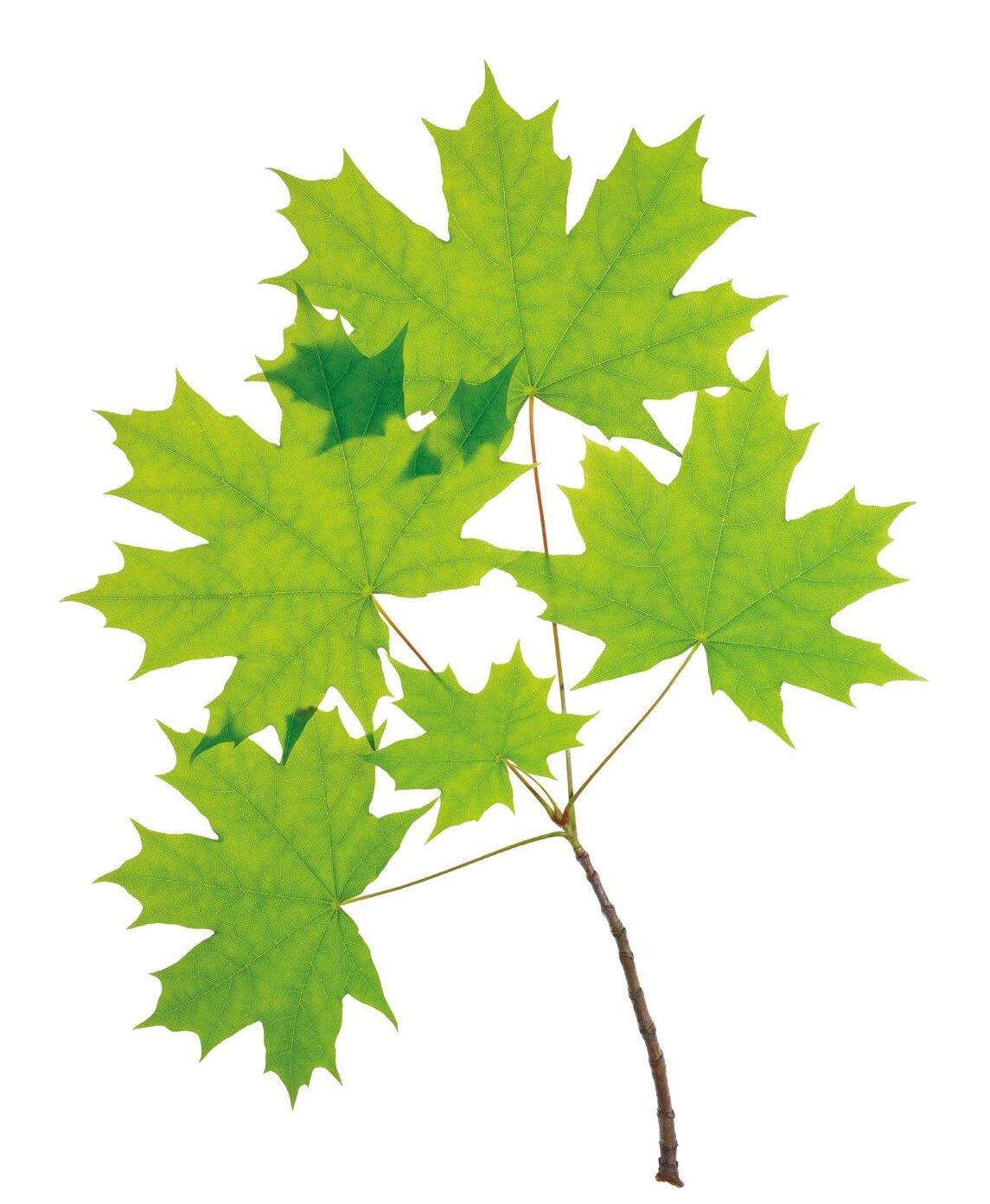









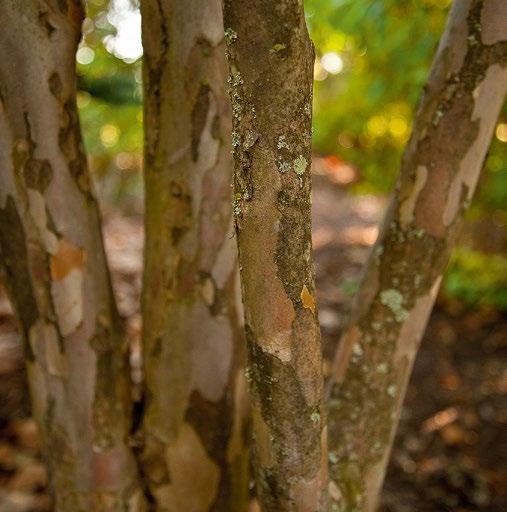
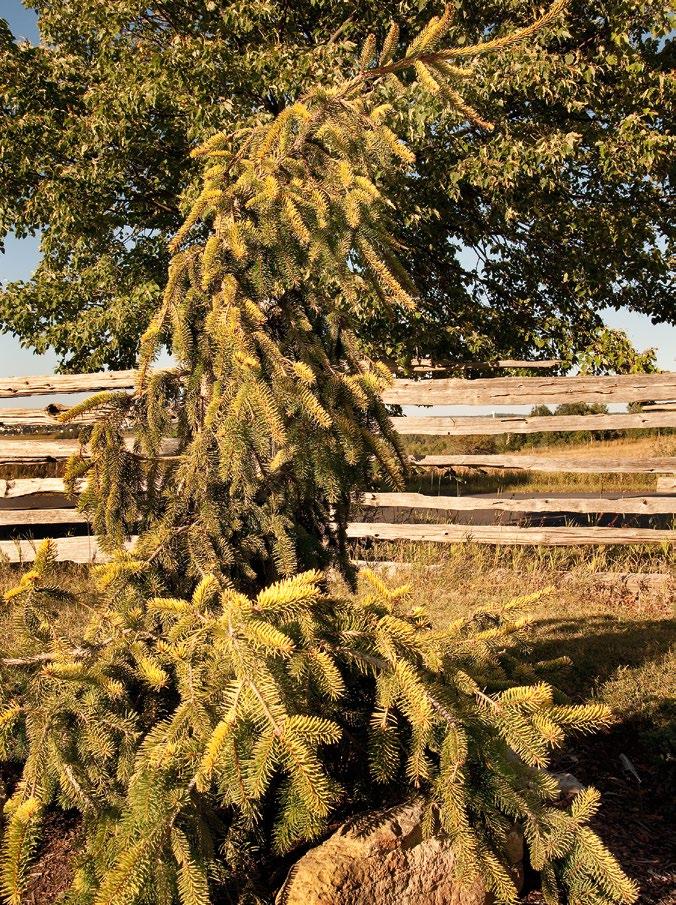
CONTINUED FROM PAGE 33
full of potato-sized stones, means drainage is not an issue. Most woody plants don’t appreciate wet feet. The organic layer atop the gravel, presumably accumulated millimetre by millimetre over the thousands of years that forests cloaked the land, provides some crucial nutrients.
But the success of the arboretum trees goes far beyond the existing subsurface character. It has much to do with placement, soil preparation and continuing care. The need for thoughtful placement is illustrated by Mary’s pride and joy – the rhododendrons. Some of these showy plants, with their broadleaved evergreen foliage, are now pushing 2.4 metres (8 feet) in height. They are wisely situated under a double row of mature Norway spruce, bathed by early morning
sunlight but protected by the spruce boughs from the harsh midday sun.
The spruce trees also tame the drying winds of winter, and their needles, dropped on the ground, augment the soil acidity the rhodos require. I admit to a little gardening envy. I know from unhappy experience that planting a rhododendron in my clay soil – even though I’m one climatic zone south of Gary and Mary – is an expensive effort in futility. I plant one, walk away and check it the next day to find a desiccated skeleton in its place. (I admit to a little hyperbole, but not much.)
If placement is important, so is soil amendment. Gary takes this task very seriously. “I do a lot of work preparing the soil. Key ingredients are composted pine bark to keep the soil loose, and chunky peat for the acid lovers. Beyond this, I add other
organics like composted leaves to nourish the new plants.”
Decades of gardening have also taught Gary that his newly established plants need to be doted on for about three years before they adapt to their new sites. This might involve the addition of more organic material, watering during dry spells and protection from wild winter winds. He has also learned the hard lesson that small woody plants also need to be protected from gnawing teeth. A single bite from a rabbit’s impressive incisors is enough to destroy a small precious tree. Voles tunnel under snow to girdle the tender bark of young shrubs and trees. So, to avoid springtime regret, Gary shields his new, small plantings from hungry mammals over the winter.
Thirty years on, the Haslett arboretum admirably complements their 19th-century house. Though built in the Victorian era, the architectural






















CONTINUED FROM PREVIOUS PAGE
style is Georgian, and the couple has painstakingly maintained that character.


The hilltop setting of the house aligns with Georgian sensibilities. Like the Haslett home, Georgian houses in Britain were often placed on hills, overlooking the surrounding countryside. British landowners of means desired a pastoral setting, with deer browsing and perhaps a stream wending through the lowlands. Integral to this vision were big trees – carefully placed oaks, cedars of Lebanon and, unsurprisingly, European beech trees. Also treasured were the horticultural exotica arriving at the time from distant lands, courtesy of British plant explorers. Emulating Georgian plant enthusiasts, Gary also seeks the rare and the unique from throughout the temperate world. He’s guided by a Georgian muse.
The uniqueness of the Georgianinspired landscape they’ve created has prompted Gary and Mary to approach the Town of Caledon with a proposal to consider including the arboretum in the heritage designation already granted to their home. A town official – a gardener who was sympathetic to their proposal – has visited but no decision has yet been rendered.

The diversity of the Haslett arboretum makes me smile. Like Gary, I love the exquisite creativity of nature. Birds, butterflies and plants fascinate me, and the more diversity, the better. I’ve long despaired at how stultifying our residential properties often are. Many of us, privileged with yards, are satisfied with foundation plantings of predictable yews or junipers and perhaps a sole specimen tree planted out front. We miss opportunities to enhance our landscapes with diversity, with beauty and with wonder.

The Hasletts know the value of embracing diversity. One of Gary’s favourite quotes comes from the character of Azeem, played by Morgan Freeman in the movie Robin Hood: Prince of Thieves. A little girl approaches Azeem, fascinated by his dark complexion. She asks, “Did God paint you?” Azeem responds,
“For certain.” The girl asks why, and Azeem replies, “Because … Allah loves wondrous variety.”
Mary is boosting that diversity by nudging Gary toward planting more perennials. She knows the arboretum will be enhanced by creating an understorey of herbaceous and flowering plants. “Mary understands the fundamentals of photography –of balance and proportion,” says Gary. To this end, Mary is integral to arboretum planning. She may not share Gary’s beech tree obsession, but she loves plants and has an eye for their placement.
Mary also celebrates the physical and psychological benefits of participating in the arboretum project. “Gardening is great for retirees,” she says. “It offers plenty of fresh air and gentle physical activity, and it keeps you mentally active too – learning about the plants and their particular needs.”
Gary is profoundly committed to the arboretum and the trees he’s planted. He becomes emotional as he explains the philosophy governing his relationship with living things. “My dogs, my horses and my plants connect me to the living world and to other human beings who share my passions. You nurture the things you love. They respond to that care by flourishing and giving back to you – symbiotic relationships. Putting my hands in the soil, preparing the planting sites and taking care of my trees is deeply satisfying. In turn, they give back to me with their beauty, their habits, their growth. They bring me happiness and fulfillment.”
You don’t have to be a gardener to understand that care and nurturing –love, if you will – build strong relationships. Gary’s philosophy provides guidance, not only for tree lovers, but also for anyone seeking to build enduring, satisfying relationships with the world at large.
See more photos of Gary Haslett’s trees with this story at inthehills.ca
Read more of Don Scallen’s observations on local flora and fauna in “Notes from the Wild” at inthehills.ca. He will present a talk called “A Celebration of Trees” at the Mono Pollinator Garden Festival on June 15. See townofmono.com in May for details.
















AS ORGANIZERS, MUSICIANS AND FANS GEAR UP FOR THE 20TH ORANGEVILLE BLUES AND JAZZ FESTIVAL ON THE FIRST WEEKEND OF JUNE, THEY REFLECT ON THE PROFOUND POWER OF FILLING A SMALL TOWN WITH BIG SOUNDS
BY TONY REYNOLDSFor 19 of the past 20 years, June’s first weekend has brought live music to downtown Orangeville. But this year’s Orangeville Blues and Jazz Festival promises to be the grandest yet, echoing New Orleans on Fat Tuesday. Indeed, the Ghost Town Blues Band, hailing from Memphis, Tennessee, will lead a New Orleans-style march through the downtown to kick off a Saturday packed with tunes.
The festival started modestly – on one Saturday in June 2003. On that day, a free concert in Alexandra Park behind Orangeville’s town hall was headlined by Jack de Keyzer, the British-born Canadian blues guitarist, vocalist and songwriter, who had just won his first Juno Award. Seven other artists included Orangeville-based saxophonist Ryan Grist, fresh out of college, with his quartet. He has played at every Orangeville Blues and Jazz Festival since. In fact, check out Jim Menken’s wood carving at the corner of Alexandra Park and Second Street. That’s Ryan on the sax. The other is festival founder and musician Larry Kurtz playing his harmonica.
Ryan remembers those early days. “It’s hard to overstate how important that is to a young performer. I am deeply grateful to have had Larry’s trust
CONTINUED ON NEXT PAGE
TOP: The 2023 Orangeville Blues and Jazz Festival parade featured Toronto jazz/funk group The Shuffle Demons. BOTTOM: Performers in 2023 included the jubilant Toronto Mass Choir (left) and Nashville bluesman Dave Barnes.CONTINUED FROM PREVIOUS PAGE
and friendship over these past 20 years, and I am proud to have been a small part of something that has become truly great.”
The event grew from Larry’s love of blues, that deep down, soulful musical genre. Larry owns and operates Kurtz Millworks in Orangeville, but for more than 25 years his passion for blues has seen him sing and play his harmonica, or harp, at festivals and clubs around Ontario and beyond. He has favourite harp players – Little Walter, Charlie Musselwhite, and Kim Wilson among them – but he adds, “I like to play my own tunes such as ‘Millie’s Blues,’ written for my mom; ‘I’m a Carpenter’; and ‘You’re God’s Gift’ for my wife, Norma.”
For that inaugural event in June 2003, Larry the player took a backseat to Larry the organizer – and stagehand. “That first year, the stage arrived at 6 a.m. on Saturday,” he says. “We had just played Friday night, and when I got the call at 5:30 a.m., I thought I was hallucinating.” In the early light and pouring rain, Larry worked with the hired stage crew, their number bolstered by about five volunteers – family members and friends – to get the stage set up behind the town hall. The rest of the day was devoted to a rousing celebration of blues music to the delight of an audience of about 2,000.
The next year, the number of volunteers swelled to about 50, people who had seen the first show and wanted to get involved. “That’s when I knew it was going to work; it was going to be big,” says Larry, “but I had no idea about how involved it was going to be with the cars and motorcycles and such.”
Fast forward to today
Since then, the festival has grown every year – except for 2020 when Covid put paid to that year’s event. The audience has swelled to about

40,000 and the festival now spans three days, from Friday afternoon to Sunday. And for the 10th time since 2003, Festivals & Events Ontario has named it one of the top-100 festival events in the province.
This year’s festival takes place from May 31 to June 2, and Norm DiPietro and his wife wouldn’t miss it. The DiPietros live in Wasaga Beach, and he owns Blue Mountain Design Centre in Collingwood. “My wife, Dawn, and I come down every year and stay for the weekend,” says Norm. “We’ve already got our Airbnb booked for this year. That’s our first festival and we go to lots more during the summer. Orangeville is my hometown, so it’s like a high school reunion.”
He adds that the two love the music. “It gets into the heart. It’s into the soul. It’s like I can feel it. It’s raw. It’s truthful. It reflects certain things that
happen in life. It’s food for the soul. Larry and all his crew just put on an amazing show, an amazing event.”
Musicians from in and around Orangeville, Toronto and other centres, as well as the United States and beyond take over the downtown core. Last year they numbered about 180. They played on street corners, in restaurants and pubs, on the main stage in Alexandra Park, in the opera house and on a stage set up on Broadway. A few are still earning their chops but many are nominees for and winners of Juno Awards, Maple Blues Awards, and other honours from the blues and jazz scene. The festival also organizes workshops so anyone with blues in their soul can learn how it’s done from the artists doing it.
Jack de Keyzer credits Larry with introducing blues to this community. “Right? Like your average person, they
don’t really know what the blues is. It doesn’t get a lot of play on commercial radio. The Orangeville festival has brought blues knowledge, and now thousands of people know what the blues is. They’ve heard some great blues bands. They’ve seen the top people in Canada, and they’ve had a great time.”
That hometown crowd then becomes deeply loyal, an essential ingredient in the success of the festival, which relies on – and reflects – strong community support. “People come back every year,” says New Tecumseth singer-songwriter Erin McCallum, who has often brought her “big voice, big sound” to the festival. “And I think that speaks to that homegrown support the festival has. Yes, there are people that come from other communities, from all over, but there’s still that community support. And that’s something that’s palpable. I notice it every time we play. I feel
Festival founder Larry Kurtz and festival president Josh Leitch at Larry’s home in Orangeville. Behind them is Larry’s painting of Juno Awardwinning Canadian jazz artist Emilie Claire Barlow. On Contents, page 11: The pair with Larry’s portrait of Muddy Waters.
like Orangeville is very communityinvolved, and I think that adds to the spirit of the festival.”
Orangeville blues singer Heather Katz, who co-owns the music store Broadway Music, agrees. “I’ve been here since 1988,” she says. “So there are people from all the different times in my life here … all of these people come out to hear me, and it’s like a cross between playing in your living room and playing on one of the greatest stages of any festival … you get a chance to connect with people who are already in your heart and people who can feel your heart anew from the stage.”
For a couple of years, festival organizers set up a stage in the parking lot on Broadway across from the town hall. That was my personal favourite, since I live in an apartment above a shop on the south side of Broadway. I could sit out on my back deck and
enjoy the music.
It rained one year, but I was under the gazebo in a comfortable chair, with two fingers of whiskey in a short glass, listening to the Downchild Blues Band live on stage. I also remember one Friday when the classic cars wouldn’t come out in the rain. Larry has talked to people who think it rains every year, but he maintains it doesn’t. “We’ve had rain now and then – once three years in a row – but we’ve only had to cancel one performance in 19 years,” he says.
The musicians aren’t the only ones who attract the crowds. There are vendors of delicacies such as spiralled potatoes, sugar cane juice, beaver tails, blooming onions and more, as well as people selling things such as meditation mala beads, alpaca sweaters, organic cotton clothing and souvenirs. On Friday afternoon and evening, some 250 classic and antique








The Orangeville Blues and Jazz Festival begins Friday afternoon when the downtown is closed to traffic. As the parked cars leave Broadway, the classic cars start rolling in. When the automobiles have settled, the music begins.
“On the Friday night, we’re looking at Downchild Blues Band. You know, the longest-running, most famous, medium blues band,” says festival founder Larry Kurtz. “This is actually their 55th anniversary of being a band. There’s one original member, Don Walsh, and some of the others have been in the band for 25 or 30 years.”
Jack de Keyzer is on Friday night as well. “He was our headliner the first year. I want to make some kind of a big deal that he won the Juno in 2003. Bob Dylan once said, ‘If Jack de Keyzer was from New York, Chicago or LA, he’d be famous.’
“We have a Friday concert in the opera house with Laila Biali, one of the top jazz performers in Canada,” says Larry. “She has a national radio show on CBC and is a worldwide touring artist.” She’ll also be a main stage headliner on Saturday. And watch for Chicago’s Nick Moss Band, featuring one of Larry’s favourite harmonica players, Dennis Gruenling, from Los Angeles.
SATURDAY, JUNE 1
From 8 a.m. to 1 p.m. Saturday morning, the Farmers’ Market will stretch out along Broadway, then the Ghost Town Blues Band will lead a Fat Tuesday–New Orleans-style march through the downtown. “The Ghost Town Blues Band is really popular in Canada,” says Larry, but this will be the band’s first appearance at the Orangeville festival.


SheWolves of London have also been confirmed. This popular Ontario all-women blues group has toured with Randy Bachman.
SUNDAY, JUNE 2
Then we come to Larry’s true passion. “On Sunday I have a special harmonica show called Harps of Gold with Steve Marriner, Paul Reddick – both Juno winners –myself, and one other player I’m trying to get: Jerome Godboo, if he’ll call ever me back,” he laughs.
Sunday is also when the motorcycles arrive. The festival is expecting as many as 1,000 bikes to be parked along Broadway and down Mill Street.
As musicians are confirmed, the Orangeville Blues and Jazz Festival will distribute a schedule several weeks before the event. “I book about 40 to 45 bands,” says Larry, “and then if you include music in the clubs and so on, it brings it up to close to 80 bands, depending on how many clubs sign up.”
Check orangevillebluesandjazz.ca for updates.
FACING BOTTOM:
CONTINUED FROM PREVIOUS PAGE
cars park along Broadway and down Mill Street for the Blues Cruise. David Murphy of MacMaster Buick GMC organizes the gathering. “We’ve got rat rods. We’ve got hot rods. We’ve got muscle cars. We’ve got all the upcoming classics,” he says.
I like to see the cars we drove in the 1950s and ’60s … like the Ford Fairlane I drove when taking lessons. With a hood like an aircraft carrier, it had three-on-the-tree and no power steering. I had to really work to get it into a parking space.
I’m far from the only one who enjoys seeing the old cars. In fact, at last year’s event, there were so many people up and down Broadway that organizers had safety concerns, so this year they’re extending the Blues Cruise eastward. Cars will be parked
ABOVE: An aerial view of the festival’s Friday Blues Cruise in 2023. At the annual event, Broadway is taken over by vintage cars and festivalgoers. FACING TOP: A sunset concert last year featured Toronto performer Danny Marks near the Opera House.

right down the hill to Broadway and Fourth Street. And on Sunday the bikes rumble in: choppers and bobbers, rat bikes and baggers, 1,000 or so motorcycles of all kinds bring their swagger to Broadway and down Mill Street.
Strolling the pedestrian-only streets with throngs of families and music fans is all part of the fun. Orangeville mayor Lisa Post was awed by the crowds last year. “I love the energy of the Friday night … just walking about,” she says. “It took me two and a half hours just to walk along Broadway from Second to First, talking to people, and seeing faces I hadn’t seen for a while.”
She also recognizes the benefit the festival brings to the town. “Beyond the financial and tourist benefits of the festival, which are easy to measure, it’s the way it brings the town together and anchors Orangeville as an arts community. When I’m at conferences,

I often hear people talk about our town as an arts community. They talk about our utility boxes, tree carvings, restaurants and the Blues and Jazz Festival.
“At a conference in Toronto, I was talking to a councillor from a town in New Brunswick – he was a musician – and when he heard I was from Orangeville, he started talking about the great Blues and Jazz Festival, and how it’s the place for blues musicians to go and get known.”
When the financial benefit of the festival is measured, it adds up to a substantial amount. Peter Ross, the festival’s director of development and marketing, says they use the Ontario Ministry of Tourism model to measure festivals and their economic impact.
“We’re running about $2.4 million in economic impact,” he says.




www.waynebaguley.com
CONTINUED FROM PREVIOUS PAGE
“It’s not a bunch of concerts taking place on a soccer field outside town. It’s right in the downtown area,” says festival president Josh Leitch. “So the engagement that happens with the local merchants – that’s one of the things that stands out in our market research, that sense of community they get, the welcome they get from the volunteers, meeting the people in the town. It’s just a warmth and dynamics that really set us apart.”
The festival is a not-for-profit organization, and as anyone who has ever attended soon discovers, most of the entertainment is free. You can stop and listen to all kinds of entertainers along Broadway and down Mill Street free of charge. But the cost of running the event is about $300,000, and much of that is spent long before the first act hits the stage.
Ticket sales to performances on the main stage and in the opera house, along with beverage sales in the beer tent, contribute roughly 30 per cent to the coffers, but the balance comes from grants and sponsorships. The town of Orangeville, the BIA and a host of local sponsoring businesses provide substantial contributions, as do the federal and Ontario governments.
“Unfortunately, the grants are down,” explains Josh. Last year Canadian Heritage dropped their grant by 30 per cent and another couple of points this year. They started at almost $39,000, but are now down to $26,000. “But that’s not a reflection of the festival,” he says.
The challenge is that available government funds are being reduced and the number of applicants is rising. “It’s harder to obtain the government’s funding now,” he says. “So we need that ticket revenue to help keep the festival going. Part of why we raise money is to help fund the type of quality productions we’re trying to do – with professional staging companies and stuff.”
One last essential element of the success of the festival – and a sure sign of its widespread community support –is its cadre of volunteers. Last year,
some 190 volunteers performed yeoman’s service, and this year organizers are looking for 220 or 230 to wear the orange T-shirts and carry out a host of different chores.
Norm Trudeau, owner of Orangeville’s Q-Net Services, is the festival’s volunteer co-ordinator. He pulls together a variety of teams with experienced leaders. “The biggest team is the roustabouts – we call them rats – the young men and women who handle all of the setup and teardown, and various activities throughout the weekend.”
There’s a fundraising team that carries large buckets and collects donations from people in the crowd, a survey team that collects comments and kudos, and a green team that works with Dufferin Waste to help keep the area clean. A merchandise team sells T-shirts, hats and other memorabilia, and another team handles the job of guiding visitors to parking and through the various areas of the festival. Gary Skinn, the festival director of operations, explains that a computer program keeps track of all the volunteers, what they’re doing and where they’re needed.
“Volunteer orientation meetings through April and May will organize teams and let everyone know what’s expected,” says Norm. And when the festival begins, they’ll be ready for anything, such as picking up a tent, poles and all, on Mill Street and carrying it down Broadway to the TD parking lot. “They’re just great people,” he adds. “They’re enthusiastic and they’re doing what they need to do to make the festival a success.”
One of the most visible, and perhaps demanding, accomplishments of the volunteer teams becomes clear on the morning after. On Monday morning, once 40,000 people, 250 classic cars, 1,000 motorcycles, and about 200 musicians have all left downtown, any trace of them has disappeared. “We’re proud of that,” says Larry. “You wouldn’t know we were there.” The volunteers have picked up every bit, every scrap … both Broadway and Alexandra Park look as if nothing has happened. But it surely has!
Tony Reynolds is a freelance writer who lives happily above Broadway in Orangeville.






























Come spring, the poet wrote, a young man’s fancy turns to love. As does the fancy of all the wild creatures of forest and field. And for the staff and volunteers at Procyon Wildlife Rehabilitation and Education Centre in Beeton, this means one thing: all hands on deck for the busy “baby season.” With warming winters, this time of year is coming earlier and earlier.
The arrival of all those hungry young mouths was still ahead when I visited Procyon in January. However, I did meet sleepy bats hibernating in a fridge, a feisty raven named Edgar, and a mink on the lam from a fur farm.
“Procyon” (pronounced PRO-see-on) is the genus name for raccoon. But this rehabilitation facility, just east of Headwaters, has been caring for all manner of injured and orphaned animals – now an astonishing 1,500plus annually – since it was established
in 2009. Mammals make up the bulk of admissions. In 2023, 329 squirrels topped the list, consisting of two species: red and grey. But cottontail rabbits and raccoons weren’t far behind, with 319 and 307 admissions respectively.
The bipedal primates who keep all these animals fed, watered and healthy include Debra Spilar, who has been a driving force behind Procyon since the beginning; Crystal Faye, primary animal care/triage co-ordinator and director, and the only full-time staff member; and Kylee Hinde, who works part-time as the assistant animal care/ triage co-ordinator.
Backing up these core staff members are scores of essential volunteers, critical to the functioning of Procyon, especially during baby season. Last year’s unusually warm January and February saw animals emerge from hibernation, mate and produce off-
spring much sooner than usual. At one point early last spring, Procyon had more than a hundred baby raccoons on a round-the-clock feeding schedule. All that bottle feeding requires lots of human hands. When it looked like this winter would be another warm one, Debra brought forward the onset of the official baby season and its requisite volunteer planning by a month, to March 1 from April 1.
I was struck by the positive energy exuded by everyone at Procyon. Though the work is demanding and can be emotionally draining, it was clear their passion for helping their fellow animals provides ample reward.
Debra formerly ran a marketing business, experience that translates well into running Procyon. Her petfilled house also prepared her for an essential Procyon job – cleaning up animal poop. Her rather complicated title reflects the many hats she wears

at Procyon: custodian, inventory controller, education programmer and administrator, and director. Handling the education programs is one of her favourite roles. Procyon teaches school groups, among others, about all things animal.
Crystal earned a diploma as a veterinary assistant, then became a stay-at-home mom, and when time allowed she began volunteering at Procyon and was eventually hired to co-ordinate primary care and triage. She was the one who showed me the bats in the fridge. “We have five big browns in there right now,” she said. “Every two weeks we wake them up, feed them mealworms and put them back.” In spring, when flying insects are available outdoors, the bats will be released.
Kylee, who assists Crystal, has an undergrad degree in music as well as a degree in social work and, for a time, worked with adults with disabilities. Like Debra and Crystal, she’s crazy about animals. Asked about the most difficult animals to work with, I expected her to mention coyotes or raccoons. She didn’t hesitate.
“Chipmunks!” Apparently these tiny, cherubic-looking rodents can be absolute beasts. Who knew?
Along with raccoons, squirrels and rabbits, Procyon cares for foxes, coyotes, voles, deer, bats, groundhogs, opossums, weasels, mice and skunks. A fisher and a salamander have been among their more unusual patients. Birds are sometimes admitted but most are sent to Shades of Hope Wildlife Refuge in Pefferlaw, which specializes in their treatment. In turn, Shades of Hope reciprocates by sending mammals to Procyon, including 60 skunks last year. In all, Procyon rehabbed 90 of those aromatic mammals in 2023.
Among last spring’s more beguiling admissions were two tiny porcupines, affectionately called “porcupets” by the staff. The first – the size of an apple – was found by a landowner in Creemore. It was newly born, with its umbilical cord still attached. Kylee laughs as she remembers talking to the rescuer on the phone. “I think I’ve found a hedgehog!” the caller said.
As if preordained, only two days after this diminutive pin cushion was admitted, a call came in from Thunder
Bay offering another baby porcupine. Ever resourceful, Debra arranged for a dog rescue service to relay the porcupine to Procyon. The centre doesn’t take in many porcupines, so to have two arrive within days of each other was a stroke of luck. Whenever possible, Procyon tries to house animals with members of their own species so they can socialize with their own kind and learn from each other, improving their chances of survival when released.
This strategy worked for the porcupets, which didn’t imprint on the centre’s staff or volunteers. Though they would come readily for food –apples were a favourite – they did not hesitate to raise their quills if upset. And when angry with their human handlers, they’d throw little temper tantrums, running in circles, spinning and screaming.
Animals arrive at the centre for a variety of reasons. Some suffer from mange, a debilitating condition that results in fur loss and is caused by an infestation of mites. Many arrive injured after run-ins with cars. Fractures and head injuries are
CONTINUED ON NEXT PAGE
This baby raccoon, grey squirrel, fawn and fox kit were among the 1500 plus animals, young and mature, cared for at Procyon Wildlife Centre in 2023.MADE IN CANADA MOUNTAIN BIKES STARTING AT $1500!



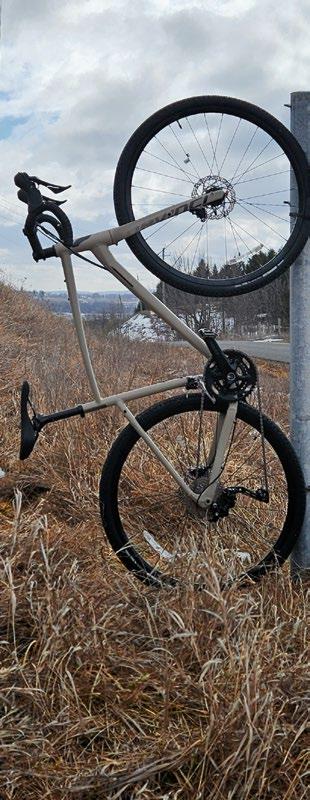
CONTINUED FROM www.animalsinmotionrehab.com

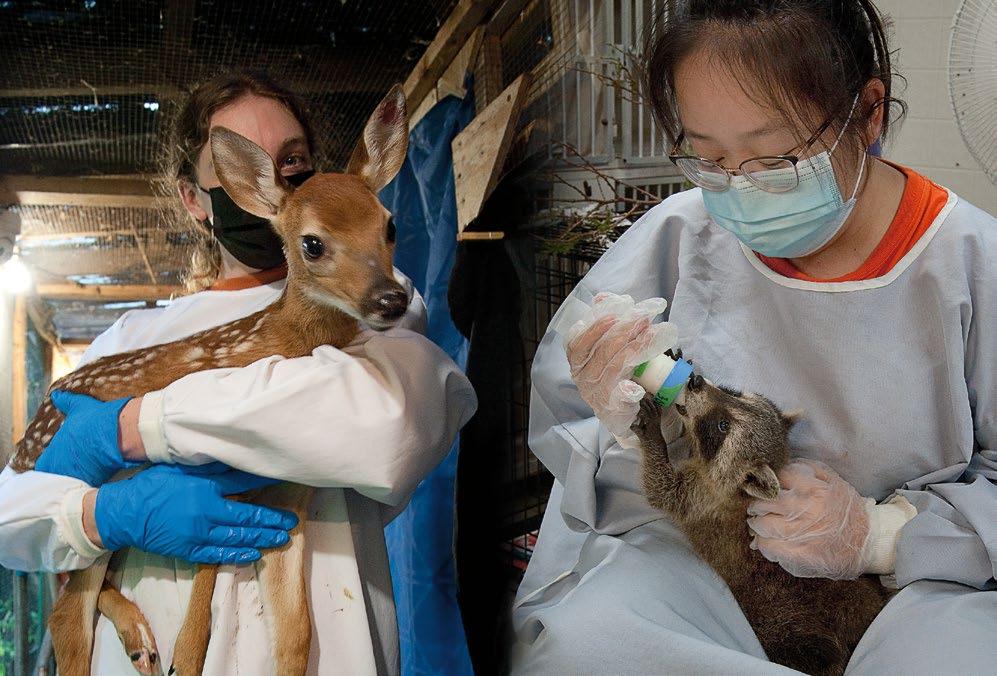
PREVIOUS PAGE
common. Debra advises people who find an injured animal to move it as little as possible and to bring it to the centre quickly. Head injuries in particular need prompt treatment. Many animals with head trauma can recover if they receive timely care.
Leg injuries sometimes require amputations, and in testament to the remarkable resilience of animals such as foxes and raccoons, having three legs does not necessarily preclude a return to the wild. Procyon calls on a variety of local veterinarians to examine animals and perform surgery if necessary. Assistance often comes from the National Wildlife Centre in Caledon East and its qualified wildlife veterinarians, including Dr. Sherri Cox, NWC’s co-founder and medical director.
Other injuries are caused by domestic dogs and by house cats.
House cat depredation of wild animals in North America is welldocumented and responsible for the deaths of tens of millions of birds, small mammals and reptiles annually. Debra pleads, “If you insist on allowing your cat to roam free
outdoors, at least have it wear a bell. Know also that outdoors, it becomes part of the food chain. Coyotes can’t tell the difference between a wild animal and a domestic one.”
Some of the injuries inflicted underscore the dark side of human nature. In Barrie in 2017 a young raccoon was set on fire with lighter fluid. Burned over 40 per cent of its body, it was christened “Phoenix Rose” by Procyon in hopes that it might rise from the ashes and survive. It didn’t, soon succumbing to trauma-induced pneumonia.
Another sad testament to the depravity our species is capable of was a squirrel pinned to a tree by an arrow through its chest. He didn’t make it either. BB guns take a toll, and occasionally animals are found struggling in snares set illegally by poachers.
Procyon, with its abundant compassion, offers a life-affirming contrast to these acts of violence. The scores of Procyon volunteers, and the legions of people in our communities who care, greatly eclipse the bad actors. This is something worth remembering when stories of unspeakable cruelty arise.
Sometimes, however, caring and
goodwill can end up unintentionally hurting animals. Kind-hearted human beings react with understandable concern when they stumble upon an injured or baby animal in the wild. With injured animals, the way forward is clear: contact a rehab centre such as Procyon. But with babies, caution is necessary. Often the mother is nearby, watching anxiously. It’s best to wait a while and check back regularly. Whitetailed deer mothers, for example, leave their nearly odourless fawns in place for hours. This is in part because the mothers emit a scent that can attract predators. So, it’s best for them and their fawns to be separated for much of the day.
Speaking of fawns, one of the heartwarming stories I heard at Procyon was about “Willow,” a tiny white-tailed deer that had been hit by a car. Willow needed orthopedic surgery to repair an injured hip. The estimated cost was an eye-watering $6,800. Debra and her staff were unfazed. An animal was in need, and they would make it right, regardless of the cost.

24 hours, a social media campaign on behalf of the fawn brought in that amount and more.
Another story to tug the heartstrings features “Talitha,” a tiny fox kit, so young her eyes hadn’t opened, found cold and alone in a snow-covered field. Her parents and siblings had been killed by predators, likely coyotes. Unaccountably, she had been left unscathed.
Named for a little girl who was, according to a biblical account, brought back to life by Jesus, Talitha and her story generated more than 200,000 YouTube views. She thrived under Procyon’s care, exhibiting the curiosity and intelligence her species is known for.
Eventually another young fox came to Procyon and was introduced to Talitha. Early distrust soon yielded to curiosity and lots of rambunctious play. After growing up and demonstrating the ability to hunt,
both animals were released into the wild. As the two bounded off into a meadow, the Procyon staff basked in the glow of an ideal rehabilitation effort. “It’s what makes all the late nights and early mornings worthwhile,” said Kallie, a Procyon volunteer in a YouTube video. “This is our definition of a happy ending.”
Another happy ending was rather unexpected. A horse farmer had called to report an emaciated mange-ridden coyote desperately trying to keep warm by lying on mouldering manure. The coyote was easy to approach – resigned, it seemed, to his fate. “We picked him up almost like a baby,” says Debra. “He had no fight left in him at all.”
Procyon worked its magic. The coyote’s fur grew back, his health returned, and he was deemed ready for release. But where to? Surely the farmer didn’t want the coyote back. It turned out she did. “I want him here,” she said. “My horses aren’t afraid of coyotes, but they’re terrified of the mice the coyotes eat!”
Returning rehabilitated animals to their home turf is taken very seriously by Procyon. The Ontario Ministry of Natural Resources and Forestry mandates that animals be released near where they were found, a policy



Along with a section on what to do if you find an animal in distress, the Procyon website includes information on how to volunteer, a comprehensive list of other Ontario wildlife rehabbers, and how to tap into Procyon’s education programs. You can also follow them on Facebook. www.procyonwildlife.com 905-729-0033
Procyon tries not to turn away any animal in need, but if the centre is full, they may refer you to another rehab centre or arrange transport for certain animals to facilities that specialize in their care. Bears, for example, would be sent to Bear With Us Centre for Bears in Sprucedale, Ontario. www.bearwithus.org 705-571-4397
Procyon will occasionally take in raptors, but Shades of Hope in Pefferlaw specializes in avian recovery. www.shadesofhope.ca 705-437-4654
Likewise, the Ontario Turtle Conservation Centre in Selwyn, Ontario, specializes in caring for these shelled beasts. www.ontarioturtle.ca 705-741-5000
Volunteers are always welcome, especially right now, during “baby season.” And speaking of babies, check out YouTube for the story of Talitha, the cutest little baby fox.
The NWC has served the conservation and rehabilitation needs of wildlife since 2014, offering veterinary expertise to Procyon and other wildlife rehabilitation centres across Canada. Co-founder and wildlife veterinarian Dr. Sherri Cox has worked for a decade out of a mobile wildlife hospital. This will soon change. Construction on a state-of-the-art wildlife field hospital is now underway in Caledon and, barring delays, could be open in the fall or early winter. www.nationalwildlifecentre.ca 416-577-4372
CONTINUED FROM PREVIOUS PAGE
the centre embraces. Animals, like us, know their home territory – where to find food and where to find shelter. Another imperative governing this policy is the prevention of disease. Bats, for example, may carry the spores of white-nose syndrome, a fungus that has killed millions of these creatures in North America. It would be irresponsible and potentially damaging to release them beyond where they were found.
As you might expect, all the good work Procyon does, and the hundreds of animals it supports annually, requires large sums of money that largely flow from generous donations. Each mammal species, for example, needs its own bespoke formula mix. You can’t feed a herbivore like a porcupine the same formula required by an omnivore like a raccoon. These species-tailored formulas ship from the U.S. at $500 for a 20-pound pail.
Along with financial help, Procyon requires at least 150 volunteers during the spring birthing season. If you are tempted to join the Procyon team, be aware that though bottle feeding cute baby animals is heartwarming, there are plenty of less endearing chores that need doing: laundry, dishwashing, preparing formula, and the herculean task of cleaning all the cages. This is done every time the animals are fed. How often is that? Babies are fed
six times a day and adults morning, afternoon and evening.
Clearly though, volunteers think it’s worth it. Lorysa Cornish, an Orangeville resident seeking to shake the Covid blues in 2021, reached out to volunteer at Procyon. “Starting as a volunteer at Procyon was an amazing experience,” Lorysa remembers. Engaging in the meaningful work of caring for animals was just the tonic she needed to cope with the Covid doldrums.
Lorysa fell in love with “Gideon,” a fawn that was stressed and not eating well. On one of her evening shifts, Lorysa was determined to help. She gently encouraged Gideon by, she says, “acting like a mother deer would. I gently stroked his belly and tail area. He responded by bumping his nose into me, something they do with their mothers when wanting to nurse.”
So Lorysa repeatedly offered the bottle, but Gideon seemed confused. And then, at last, success! He latched on, “drained the entire bottle, had a good pee, and then settled down for a snooze.” Lorysa was so relieved that she almost cried. Gideon grew into a healthy adolescent deer and returned to the wild.
Lorysa’s story reinforced the impressions so amply conveyed by Debra, Crystal and Kylee. Procyon not only serves the critical needs of thousands of animals but is also balm for the spirits of their human caretakers.
Procyon director Debra Spilar and the whiteboards used to keep track of feeding and med schedules for scores of animals and to coordinate the dozens of volunteers who care for them.







As the soft winds of spring gently sweep through our charming small town, stirring the last vestiges of winter, a subtle transformation takes hold. The quaint streets come alive with the promise of a new season, where the awakening landscape offers a unique beauty all its own. Amidst the budding trees and fresh greenery, residents and visitors are beckoned to embrace the revitalizing spirit of spring.

Take a stroll through our inviting Main Street, where each storefront becomes a storyteller, weaving tales of renewal and the vibrant spirit of the season.

Start your day at one of our bakeries, where the aroma of freshly baked pastries mingles with the crisp morning air. Indulge in the elegance of high tea, where delicate flavors dance on your palate. For a taste of the countryside, venture to the various local farms, where the bounty of the season is proudly displayed.

Let the spirit of spring in our town captivate your senses, and explore the unique offerings of these businesses that bring the essence of the season to life.
Celebrate spring with us as we embrace the beauty of nature and the warmth of community in our idyllic corner of the world.

Ready for a Wonderland adventure?
Bring High Tea home or enjoy it in our Whimsical Tea Room. Extensive loose leaf tea choices, rich coffees, homemade scones, exquisite lunches and delectable desserts! Ask us about hosting private events. maddiehattererin.ca 519 833 0019


Start your adventure at Tailwinds! Use the Elora Cataract Trailway to cycle or hike to diverse community attractions. Return to your well-appointed room and recharge with a delicious breakfast. Come visit soon!


17 Station St. Hillsburgh 519.855.3242 tailwindsbb.ca

Season Opens
Saturday June 15
10,000 Lavender Plants
Wood Fired Pizza
Children’s Play Area
Flu y Cows & Farm Animals
Wagon Rides
Live Music Weekends
Retail Shoppe






Family owned and operated since 1946!

78 Main Street 519-833-2326
Wednesday to Saturday 8 to 6
Sunday 8 to 5
Closed Monday and Tuesday

























Hiking the Bruce Trail from end to end is on the bucket list of many a devoted hiker. But covering the main trail’s 900 kilometres from Niagara to Tobermory comes with difficult logistics –usually involving backtracking to your entry point each day, or hiking with a companion and dropping a car at either end of the day’s route.
Now Caledon writer and dedicated hiker
Nicola Ross has a solution to that problem –covering the entirety of the Bruce Trail in singleday loop hikes by taking advantage of the many side trails that branch along the main trail.
A longtime contributor to this magazine, Nicola is also the author of six Loops & Lattes regional hiking guides. The success of those guides inspired her to adapt the idea of loop hikes to the big canvas of the Bruce Trail.
The result is her new book, 40 Days & 40 Hikes: Loving the Bruce Trail One Loop at a Time. Filled with anecdotes and historical vignettes, the highly readable book is part hiking guide, part memoir and part cri de coeur for the preservation of the magnificent natural landscape all along Niagara Escarpment, recognized as a UNESCO World Biosphere Reserve.
On the following pages is an excerpt from Nicola’s chapter on her “home trail” through Belfountain and the Forks of the Credit.
 Nicola Ross and her dog, Frida, take in the view across Georgian Bay as they make their way up the Bruce Peninsula on the final leg of their journey from Niagara.
Nicola Ross and her dog, Frida, take in the view across Georgian Bay as they make their way up the Bruce Peninsula on the final leg of their journey from Niagara.
IN HER LATEST BOOK, NICOLA ROSS OFFERS ASPIRING BRUCE TRAIL END-TO-ENDERS 40 LOOP HIKES FROM NIAGARA TO TOBERMORY. HERE’S AN EXCERPT FROM DAY 16: FORKS OF THE CREDIT/BELFOUNTAIN PARK.
When I set out from Queenston 15 loop hikes ago, my ultimate destination was Tobermory. But my first goal was to get “home.” Today I arrived. I walked on paths embedded in my genes and alongside rivers that course my veins. If I have trouble falling asleep, rather than count sheep, I trace the route of the Credit River and the layout of the local Bruce Trail in my mind’s eye.
I parked at the dead end of Chinguacousy Road, not far from the Cheltenham Badlands, and took off on the main BT as it climbed to “the quarry” through a dense forest. There was scant sun beneath the thick canopy, and I had to watch my footing along the rocky trail. Bedrock surfaces through here, a fact taken advantage of by the owners of a flagstone quarry that has been around longer than the BT. When I was a kid, if the owners caught us riding our horses along the quarry road, they’d accuse us of trespassing and chase us away.
Following this childhood-memory-filled road, I passed by bayou-like swamps and between mosquito-rich ponds. The mud was seriously black, pungent and earthy; it would suck you under if you strayed too close. After passing the quarry entrance, the main BT climbed “the mountain” and entered Caledon’s “Equestrian Neighbourhood.” As I walked along the familiar dirt road, I could feel the rhythmic sway of sitting in a saddle. …
Turning right onto Creditview Road, the main BT takes advantage of the road allowance to get down to the Forks of the Credit. It’s amazing how much of the trail follows these remnants of public land, and it’s a good thing too. If the BT didn’t follow them, I’m not sure cash-strapped municipalities could resist selling these parcels of land to adjoining landowners who would erect the No Trespassing signs that motivated [BT co-founder Ray] Lowes. Without abandoned railway lines, utility rights-of-way and unopened road allowances, there wouldn’t be a BT.
I weaved through rocks as I approached what people refer to as the Devil’s Pulpit – a protuberance in the cliff face that gives rise to this moniker. I looked out over the Credit River valley, a green expanse that stretches as far as I could see … I began my descent via irregularly spaced stone steps that hug the wall of the escarpment. A handy rope that loops from metal rings drilled into the limestone acts as a makeshift railing. By providing a landing from
which the stairs descend diagonally down the cliff face, the Devil’s Pulpit was the BT’s final link.
Down I went over slippery rocks decorated with maidenhair spleenwort and through towering cedars. How many times have I walked this route? I wondered. I chuckled recalling a photo I took of my mum on this trail. She’s wearing a navy blue sweatshirt. Emblazoned in large white letters across her chest are the words “Sixty and Sexy.” I’m now older than she’d been when I took that shot. How was that possible? I was reassured when I spied a healthy cluster of walking ferns on the rock where I expected to see them. Cold air escaping from deep crevices made me shiver. I detoured down the tricky in-and-out side trail to the ruins of the Hoffman lime kiln. Long before the BT added this side trail, I came looking for the lime kiln Indiana Jones–style. When the ruins loomed before me, I thought I’d been transported into a Mayan jungle. I wasn’t prepared for their size, or how, over a century, the once domeshaped structure had become shrouded in cedars. Part of me was sad when the BT opened the side trail and exposed my secret.
It was a scramble back up to the main BT and then down over the railway tracks first operated by the Credit Valley Railway. Service between Toronto and Orangeville began in 1879. My mum used to flag the train from the station once located at the end of the long trestle bridge. Currently, the tracks are being pulled up as the railway line enters a new chapter as a hiking trail. Below the tracks, the path reaches Chisholm Street, as did [BT co-founder Philip] Gosling all those years ago. In 1967, as he bushwhacked the route, he would have passed by the one-room red-brick schoolhouse, SS#19, where my sister and brother attended class under the tutelage of Mrs. Longstreet. It closed in 1963 and students were transferred to the new Belfountain Public School. I followed the BT along the Forks of the Credit Road, picking up the Trimble Side Trail at Dominion Street. From there, I couldn’t just smell home, I could taste it.
The Trimble brothers, Roy and John, inherited their father’s blacksmith shop in Belfountain, turning it into a garage. From the building that now hosts a café, several stores and, for a time, a yoga studio, they sold gas and cared for locals’ cars, including my parents’. The brothers often told us stories about life back then. John’s wife, Berniece, captured the area’s history in a book entitled Belfountain: Caves, Castles and
Quarries in the Caledon Hills. Roy Trimble was a fine paddler who guided the Group of Seven members who painted in the Forks of the Credit. Belfountain was a popular spot even then, and the Trimbles knew the area better than most. When I hiked into the real Devil’s Pulpit, we found John Trimble’s name carved into the limestone.
The trail left the road beside a bridge where the West Credit tumbled over rocks and I entered the Willoughby property. Owned by Ontario Heritage Trust, it’s a 40-hectare parcel of land with wonderful views and evidence of quarrying that is now mostly hidden – unless you know where to look.
…
When I came to “my” trail, as I’m the BT captain (a.k.a. caretaker) for the kilometre-long Crow’s Nest Side Trail, I turned left and followed it in a counterclockwise direction. If I’d walked down the Devil’s Pulpit’s cliffs a hundred times, I’d walked this route a thousand. When I returned to the Trimble Side Trail, I retraced my way back to Dominion Street where I picked up the main BT. The “forks of the credit” converge just upstream from the Dominion Street bridge. A prized flyfishing stream, the Credit River meanders through villages, towns and cities that took advantage of its once powerful flow. It was also paddled by the Mississaugas of the Credit after they’d purchased supplies on credit from settlers – giving rise to its name. The Forks of the Credit was also the heart of quarry country in the 19th century, known for its large slabs of prized pink limestone. If you know Queen’s Park, Ontario’s legislative building in Toronto, you can visualize the beautiful stone blasted out of the hills that surrounded me.
I followed the main BT into the hamlet of Brimstone, once home to quarrymen so tough their penchant for fighting resulted in the village’s biblical name. The main BT follows yet another road allowance, this time one that once joined the Forks of the Credit to the village of Cataract through what is now the Forks of the Credit Provincial Park. Along the way, I passed the Dorothy Medhurst Side Trail, named for a keen hiker who once lived nearby. Her daughter was Abby Hoffman, not the American Yippie, but one of Canada’s most talented middle-distance runners. One day, when I was riding my horse near Medhurst’s home, I came across a lean, longlegged woman leading a goat. It was such an odd sight that I remembered it. Decades later, when I learned Medhurst’s daughter was the runner, I put two and two together.
CONTINUED FROM PREVIOUS PAGE
The road led into an open valley, the destination for many years for the Caledon Riding Club’s annual Brimstone Ride on Thanksgiving weekend. We’d ride in, tie up our horses and have lunch. My dad made onion soup and heated it over an open fire in a huge cauldron fashioned by the Trimbles. We had McIntosh apples that taught me the difference between the crisp, freshly picked ones and the mushy stored ones. Dad set up the soup by the river and we played in the tufted grass, rolling like wieners down the steep banks next to where today’s BT passes by an outdoor washroom before heading up the escarpment.
Of all the places I’ve hiked, the Forks of the Credit Park is my favourite. Countless times, I’ve walked next to the washroom, across the sandy cart track, past the wiener hill, alongside the poison ivy, through a soaring maple forest where white trilliums blanket the forest floor in spring, and up the long ascent to the ridgetop. Today, I turned left at the ridgetop and followed the Mill Pond Side Trail. It skirts the valley lip, so you walk almost level with some treetops, then drops down a long set of stairs to the ruins of an old power plant and waterfall, and crosses over where the dam used to be. The Elora Cataract Trailway and the soon-to-be Credit Valley Trail run parallel to the BT before converging in the village of Cataract. At the intersection of two railways (Credit Valley Railway and the Hamilton and North-Western Railway), Cataract was once home to various hotels and bars needed to service those arriving in this transportation hub. Its hills are rich with stories of rushes for gold never found, salt never extracted, Canada Dry water wells and exploding dams. I crossed over the main Credit River and climbed back up the escarpment, then I followed a section of the Trans Canada Trail to the Meadow Trail.
This is my favourite Forks of the Credit Park trail. It dissects what was once pastureland. This hummocky landscape is the western extreme of the Oak Ridges Moraine, for the Niagara Escarpment and the Oak Ridges Moraine collide in the Forks Park. Milkweed and goldenrod, old apple trees, bluebirds, Baltimore orioles, Eastern meadowlarks and other meadow-loving species find refuge in this vast open landscape partly thanks to a team including local naturalist Don Scallen. They keep the surrounding forest at bay. More recently, Ontario Parks took more drastic steps. It has razed the meadow to encourage growth of a rare tall-grass prairie. This effort is music to my meadow-loving ears. There’s a kettle lake where I’ve spied bufflehead ducks and enormous snapping turtles. White-tail deer abound. On this day, purple lilacs added colour to the vibrant green, early-season grasses that

START TIME : 7:20 a.m., Monday, May 30, 2022
TRAILHEAD WEATHER : overcast, warm, threatening rain, turned to sun
DISTANCE : 27.8 km
ELAPSED TIME : 8h 47m
BRUCE TRAIL (BT) SECTION : Caledon Hills
BT MAP : #14/15
MAIN BT WALKED : 2.8 km to 14.6 km
ASCENT : 1214 m / Descent: 1234 m
swayed in the warm breeze.
I paused at the intersection of the Meadow and Ruins trails, the spot where I dream of building a house. From this perch, the meadow stretched away, showing off under a deep blue sky. Farther down the trail, the orange belly of a Baltimore oriole caught my eye. I returned to the main BT as it returned to the ridgetop overlooking maples that reached to the heavens. Ancient horsetails blanketed the sides of the trail as I climbed over a sandy kame. On the far side, tufted mounds of sedge dotted the forest floor as the trail dropped down to course the ridge at mid-tree level. Then it was up again, reminding me that this was the Caledon Hills section. (This turned out to be my second hilliest hike along the entire trail.) Then down onto Puckering Lane where I’d met Hoffman and her goat that day long ago and where,
SIDE TRAILS : The Ring Kiln Side Trail, Trimble Side Trail, Crow’s Nest Side Trail (“my” side trail), Mill Pond Side Trail, Meadow Trail, McLaren Road Side Trail
FLORA/FAUNA OF NOTE : maidenhair spleenwort (Asplenium trichomanes), walking ferns (Asplenium rhizophyllum), shagbark hickory (Carya ovata), goldenrod (Solidago canadensis L.), common milkweed (Asclepias syriaca), lilacs (Syringa), Baltimore oriole (Icterus galbula), horsetails (Equisetum), Sprengel’s sedge (Carex sprengelii )
today, I did my best to ignore the plethora of No Trespassing signs that flank the road. I’m thankful that Ray Lowes was spared the warnings of video surveillance.
…
I love this landscape because of the images it conjures for me of youthful times, but also because I know it so well. I feel secure in Caledon. Being here is like snuggling in bed on a rainy morning. I know the trails, the hills, the trees, its smells and sounds. I fit into this landscape. It’s a connection that has taken decades to develop. My ties have evolved over time. I have neighbours who continue to live where their ancestors built the mills and farmed virgin land. I now realize their connections dwell deeper than mine. And what about the Mississaugas of the Credit who travelled
the river of my birthplace. To escape encroachments of the settlers and declining natural resources (things I could relate to), they moved to land adjacent to the Six Nations Reserve near Hamilton in the mid-1800s. In 2010, the Mississaugas of the Credit received $145 million as compensation. It saddens me to think they needed to break 10,000 years of their relationship to the land. What would it feel like to have Caledon that deeply ingrained in me? What would it feel like to be forced to leave?
With its 440 kilometres of side trails, the Bruce Trail offers something that most long distance routes do not: you can loop your way along it as Nicola did. Her loopy endto end offers hikers a way to enjoy the trail without a car or bicycle drop, trail angels or a taxi. Solo hikers can be selfsufficient, carrying only a daypack – albeit a wellstocked daypack for safety’s sake.
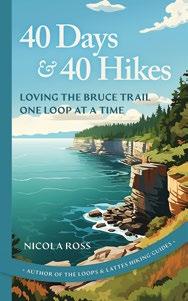
If the idea of completing similar or even the same loops as Nicola did appeals to you, you are in luck. Various Bruce Trail clubs are combining their energies with her to develop a loopy passport/ journal and a “Loving the Bruce Trail Loops” badge.
For each of Nicola’s 40 plus loops, the passport/ journal will include:

• a map
• step by step directions
• Nicola’s field notes
• space to record your own field notes (and sketches if you feel so inclined)
When accompanied by The Bruce Trail Reference Maps and Trail Guide and, advisedly, the Bruce Trail app, the passport/journal will help hikers record their loop hikes.
Complete all the loops in a participating Bruce Trail club section and you’ll receive the badge. (There are between three and seven loops ranging in length from 12 to 30 kilometres for each of the trail’s nine sections.)








presents




A world of adventure awaits your children this summer at camps in Caledon, Dufferin, Erin and nearby communities. And it’s never too early to start planning!
Our Kids Camps in the Hills page at inthehills.ca/kids-camps-in-headwaters is your go-to guide to camps and activities across the Headwaters region. Here’s a sampling of what’s already available – check in with us regularly for updates.
Kids swim in a lake, play forest games and prep for talent shows at the sprawling 30acre Kids Inc. in Erin. At TRCA’s Albion Hills Field Centre in Caledon, kids learn wilderness survival skills, meet animals, and explore art in nature. Caledon’s Teen Ranch offers day and overnight camps, with pony rides, indoor skating, rock climbing and swimming. Campers try woodworking, archery and nature education at Camp Mansfield in Mulmur. This year Mono’s Compass Camps offers weekly themes like Space Trek and Knights & Castles. Sign up early for the Town of Orangeville’s popular Camp Aliquam, as well as Island Lake ECO Camp for hiking, fishing and canoeing in Mono.
The Hill Academy in Caledon offers soccer, hockey and lacrosse, while the Field of

Dreams Baseball Camp will have them running for the bases. In Orangeville Twisters Gymnastics and Champion Cheer Academy get children tumbling. They’ll sink some putts at Lynbrook Family Golf Centre in Amaranth or the 18-hole Shelburne Golf & Country Club Mono’s Athlete Institute is known for volleyball, basketball and soccer camps. Tennis, squash and pickleball reign at the Headwaters Racquet Club in Amaranth, as does Muay Thai at Art of 8 in Orangeville.
Unleash your child’s creativity through visual arts and music at Streams Community Hub in Shelburne. Budding performers will feel right at home at Theatre Orangeville or Hit That Note Music Studio in Bolton. Channel kids’ inner artists at Orangeville’s Maggiolly Art,
Pottery Parties, Art with Jada and Ricky Schaede Art Studio. They’ll dance, sing and act at The Academy of Performing Arts, Citrus Dance and Studio 3. The Raise-an-Artist Project in Ballinafad offers painting, pottery, filmmaking, zine drawing and more. Peel Art Gallery Museum and Archives in Brampton offers a wide range of arts and crafts camps, too.
If your kids need less screen and more green, At Last Forest Schools at Monora Park has kids outdoors all day climbing trees and building forts. Fiddlehead Care Farm in Mono introduces kids with unique physical and psychosocial needs to farm life and gets their hands dirty. And there’s no such thing as bad weather at the massive 130-acre GO Adventure in Melancthon.



Though the themes change yearly, STEM Camp in Orangeville always incorporates coding with Minecraft, games, robotics and building models. The Museum of Dufferin in Mulmur has exciting themes like Archaeology Camp with handson digs, and CSI Camp where kids become crime-scene investigators.
Children pursue their love of horses at one of the many riding camps in horsey Headwaters, including Black Acres, Silver Fox Equine or Cantercall Riding School in Mono, the Rusty Jade Ranch and Caledon Equestrian School in Caledon, and Erin’s Greyden Equestrian Centre

AMARANTH
Headwaters Racquet Club
Lynbrook Family Golf Centre
BRAMPTON
Peel Art Gallery Museum and Archives
CALEDON
Albion Hills (Toronto and Region Conservation Authority)
Caledon Academy of the Arts
Caledon Equestrian School
Caledon Tennis Club
Credit Valley Conservation
Youth Corps
Field of Dreams Baseball Camp
The Hill Academy
Hit That Note Music Studio
Palgrave Sports Academy
Rusty Jade Ranch
Teen Ranch
Town of Caledon Recreation
YMCA Cedar Glen
Greyden Equestrian Centre
Kids Inc.
Raise-an-Artist Project
MELANCTHON
GO Adventure
MONO
Athlete Institute
At Last Forest Schools
Black Acres
Cantercall Riding School
Compass Camps
EcoCamp
Fiddlehead Care Farm
Island Lake Rowing Club
Orangeville Christian Assembly
Silver Fox Equine
MULMUR
Camp Mansfield
Museum of Dufferin
ORANGEVILLE
Academy of Performing Arts
Art of 8
Art With Jada
Champion Cheer Academy
Citrus Dance
Maggiolly Art
Orangeville Tennis Club
Pottery Parties Studio
Ricky Schaede Art Studios
STEM Camp
Studio 3
Theatre Orangeville
Town of Orangeville Recreation
Twisters Gymnastics
SHELBURNE
Shelburne Golf & Country Club
Streams Community Hub
Town of Shelburne Recreation
Do you run a camp in the area? Add it to the list: inthehills.ca/events/my-events/add
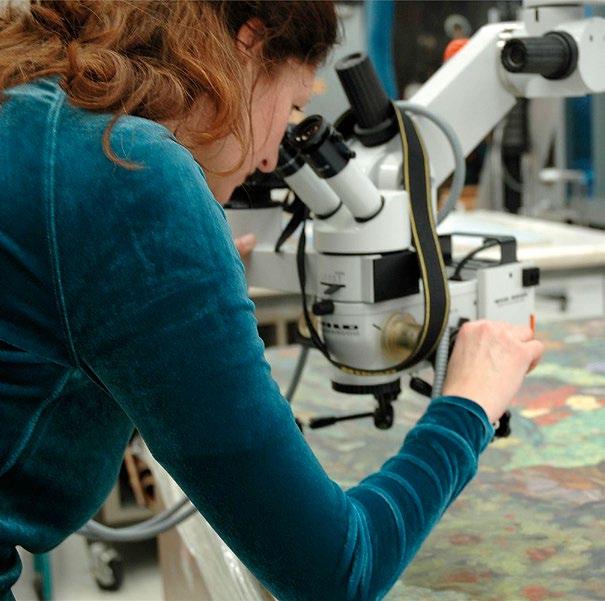

Orangeville resident A.J. Douglas is never called that. She is, happily, Alison.
On the other hand, Group of Seven co-founder, artist and educator J.E.H MacDonald is almost exclusively remembered as J.E.H, not by his given names, James Edward Hervey. But to Alison, conservator at the McMichael Canadian Art Collection in Kleinburg, holders of the largest trove of the Group’s works, he’s just “Jim.” This casual intimacy, nearly a century after MacDonald’s death in 1932, comes from Alison’s exhaustive
and decidedly un-casual examination of his works, methods, writings and travels, detailed in the recently published J.E.H. MacDonald, Up Close: The Artist’s Materials and Techniques, which Alison co-authored with conservation scientist Kate Helwig.
Alison may not use initials before her surname, but does have impressive ones after it: BFA (bachelor of fine arts) and M.A.C. (master of art conservation), both degrees from Queen’s University.
And prior to her more than two decades at the McMichael, Alison
interned or worked at renowned Canadian cultural institutions that are also commonly known by their initials: ROM, VAG and AGO. (Royal Ontario Museum, Vancouver Art Gallery and Art Gallery of Ontario respectively.)
Alison describes her career as an art conservator as “a weird niche –highly competitive.” She estimates there are fewer than 100 art conservators in Canada, all working at midsized to large institutions, such as the National Gallery of Canada which employs several.
ALISON DOUGLAS: KATE HELWIG
On most days, taking care of the 6,500 art pieces in the McMichael collection (of which less than 2 per cent might be on display at any one time) is Alison’s dream job.
A painter herself when she finds the time, seeing the work of artists she particularly admires, such as Emily Carr (“Her work feels alive to me”), up close is a treat and a privilege. “Being hands-on, looking through the microscope at them,” delighting in “the materiality of paintings, the physicality of them” are sustaining joys.
Although the job also has a prosaic
side: deadlines, workload and “the business of art” – generating gallery revenues in a competitive marketplace – Alison says, “When we unpack a show, pull out the work and look at it, it is like opening gifts at Christmas. Art books are great, but there is something about standing in front of an actual work and seeing how the colours are mixed, the brushstrokes, how they have gotten a particular effect…”
And she feels a special affinity with the Group of Seven and their associates.
“I love to camp. I love to canoe.
I’m an outdoor Canadian. That’s my connection to the Group of Seven. There is a Varley painting that I love –Stormy Weather. It’s in the National Gallery. It reminds me of a feeling I get when I’m out on Georgian Bay.”
J.E.H. MacDonald was familiar with Georgian Bay, and with Algoma, Algonquin, Lake Superior and many other scenic and, in his day, difficult-to-reach Ontario locales.
(While others in the Group of Seven, such as A.J. Casson and Franklin Carmichael, painted in the Headwaters region, there is no documentation of
MacDonald having done so.)
As the book relates, MacDonald made his painting journeys “by foot, [railway] handcar and canoe.” Alison’s journeys of conservation and exploration among his works and others in the McMichael collection are made, as she says, with her “eyes, experience and material science.”
Her work as a conservator is threefold: managing exhibitions, co-ordinating loans and acquisitions, and conservation of the artwork itself.
“We loan out our works. Institutes borrow from each other. Right now we




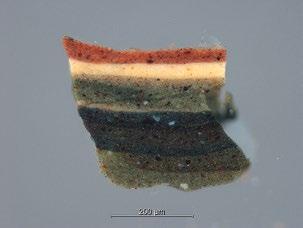

CONTINUED FROM PREVIOUS PAGE
have five different loans going in five different directions.”
Each loaned work includes a report, involving a physical examination and an assessment of its condition. To maintain that condition, the temperature, light, humidity and gallery security similar to the McMichael’s is demanded anywhere the art is destined.
“I assess to see instabilities – flaking, paint loss, cracking. We do physical treatments for travel and display. Every work has a condition report it travels with, so the conservator at the other end can look at it and see if there is any change.”
McMichael has an annual budget for the purchase of new works. Some other works come in on loan from other institutions or private collections. Sometimes wealthy patrons are approached and asked kindly if they will purchase something specific for the collection or an exhibition.
Among Alison’s conservation responsibilities are maintaining the soft illuminance and 50 per cent relative humidity in all gallery spaces at the McMichael. Asked if such a carefully maintained and gentle environment, designed for optimum art preservation, is also good for her personal preservation? Alison laughs and admits, “It’s good in the winter.”
With all the diligence and meticulous care involved in maintaining and displaying art on the walls of the McMichael, how personally does Alison take inadvertent damage or willful vandalism on her watch?
“I’d feel we failed in our duty. But stuff happens. We’re pros and can fix it. It is the balance between protecting the art and hanging it so that people can love it and react to it. We know that. We are doing our best.”
J.E.H MacDonald did his best, painting from Toronto’s High Park and wilderness locations across Canada to the beaches of Barbados from 1909 until his untimely death at age 59. Reserved and introverted, co-founder and oldest member of the Group of Seven, MacDonald produced 100 to 150 larger studio works in addition to 600 to 800 oil sketches. All in pursuit
ABOVE: A detail of The Tangled Garden showing cracking in the pure cadmium yellow, a pigment prone to powdering, crusting and cracking. Below that, two microscopic crosssections of The Tangled Garden show (left) red underpainting embedded in beaverboard, and a varnish layer of predominantly heated pine resin, with greenyellow fluorescence. RIGHT: Snow in High Park, by J.E.H. MacDonald, 1909, 12.6 x 17.6 cm, oil on paperboard. McMichael Canadian Art Collection. Two crosssections of Snow in High Park show multiple layers of variously coloured paint.of the Group’s vision of creating art that represented Canada’s iconic natural landscapes.
The sketches, small panels, completed in two to three hours (sometimes three or more a day), were the artist’s rough notes created en plein air – by a sylvan lake, atop a windswept cliff, in the snows beside a rushing river.
While lacking the finesse and polish of his studio works, MacDonald’s small oil panels are rich in vitality and immediacy. In his handwritten notes for an outdoor sketching class, appended to the book, he advises: “Don’t photograph the subject. Give only the characteristic details essential to the composition.” He adds, “Speed helps in sketching just as in sprinting. Try to grasp the idea of your subject quickly. Then put it down before you can form any doubts about it.”
In J.E.H. MacDonald, Up Close, Alison and co-author Kate Helwig, who works at the Canadian Conservation Institute in Ottawa, were privileged to intimately examine 32 works by MacDonald, both sketches and studio work, including his most famous, The Tangled Garden, a large and stunning depiction of the artist’s own Thornhill garden.
They felt honoured. “That was an amazing moment,” Alison says. “[The Tangled Garden] never comes off the wall at the National Gallery of Canada. It came off for us.”
Described as an “interface between art history and science,” the book details in words and photos ten years of the authors’ work in which, as Alison describes it, they took “a deep dive into MacDonald’s techniques and materials.” Their work included minute, sometimes microscopic and molecular examination of every physical facet of MacDonald’s art, from his brushstroke technique and the materials he painted on, to an exhaustive analysis of the pigments he favoured, along with a study of his diaries, letters and lectures. Of particular import were century-old sales catalogues of artists’ materials in use at the time.
For non-art nerds, the two conservators’ professionalism might seem taken to arcane extremes. As a random example, from page 168: “The first techniques applied to the paint ground
samples were FTIR spectroscopy, and SEM/EDX.”
(Translation: Fourier-transform infrared spectroscopy – a technique to measure how much light a sample absorbs at each wavelength; and scanning electron microscopy/energy dispersive X-ray spectrometry – used to determine the base elements and chemical components of a sample. But if you find that boggling, don’t worry, there’s an extensive glossary and appendix to help you along. )
The most important goals of all this forensic analysis are to understand an artist’s creative process, establish chronologies, and enhance conservation. Alison says, “It’s about looking at a piece and figuring out why it’s in terrible shape. Or a contemporary piece made with, say, silicon rubber. How this thing is going to age? How are we going to take care of it? There is a lot of that kind of sleuthing. I love that!”
In the introduction to the book, the authors note, “The data will also be valuable to scientists, curators, art historians and collectors when questions arise about authenticity.” Indeed questions about authenticity would arise in 2015 when the Vancouver Art Gallery announced the acquisition by donation of ten hitherto unknown J.E.H MacDonald sketches, one a preparatory study for The Tangled Garden itself.
Almost immediately some in the field questioned the paintings’ attribution. A planned show was postponed. An investigation began. Independently and coincidentally, Alison and Kate were already hard at work on their studies of MacDonald’s works and methods.
In a final chapter of the book titled “Applying the Research,” the authors note that authentication can be a complicated process, relying on provenance records, comparisons with an artist’s usual style, materials and methods, and science. Using the VAG sketches and other works as examples, the chapter liberally deploys such words as “inconsistent with,” “uncharacteristic” and “atypical” –but always with the caveat that human creativity is not necessarily linear or predictable. Still, in the case of the VAG sketches, it was science that ultimately allowed for a decisive “gotcha” moment.






We are a team of Traditional Chinese Medicine and Acupuncturists trained in China with many years of university teaching and clinical practising experiences for natural herbal formulas and acupuncture treatments We treat chronic rheumatoid arthritis, osteoarthritis, fibromyalgia, infertility, irritable bowel syndrome, sciatic pain, Bell’s palsy and other chronic health problems.. for pain reduction, symptoms release and control
We also provide preventive treatments for other health related problems

www.ontariopainclinic.com

CONTINUED FROM PREVIOUS PAGE
Citing a work titled Sketch after The Tangled Garden, the chapter concludes, “The use of multiple anachronistic pigments in various parts of the composition showed that J.E.H. MacDonald did not paint this sketch.” Specifically it notes, “Phthalocyanine green (Pigment Green 7) was discovered in 1935 and pigment production began in 1936, four years after MacDonald’s death.” Ultimately all 10 of the VAG sketches fell victim to what Kate calls “the smoking gun” of that green pigment.
“This is incredibly rare, this result,” says Alison. “A pigment found outside the artist’s lifetime. That is definitive. That was Kate and the CCI. They deal with authentication issues all the time. They have the facilities, very specific, very expensive, to do that deep scientific analysis.”
Alison had not seen the sketches until she attended the Vancouver show in February. There she had a chance to test another important but more subjective factor that goes into authentication: connoisseurship. It is the instinctive knowledge seeded through prolonged exposure to an artist’s style and techniques. Challenged to pick out the fake sketches intermingled on the walls among legitimate works by MacDonald, she pegged nine out of 10.
After 154 pages of diligence, professionalism and rigorous science, the book ends with delightful humility, verging on humour: “We feel compelled to point out that the spirit and the poetry of [MacDonald’s] art can never be captured through this type of analytical exercise.”
Bolton 7 Norton Blvd. 647-620-7889
Orangeville 44 First St. 519-942-9826
Mono 506206 Hwy 89 905-587-0008
Publication of Alison and Kate’s book was timed to coincide with an exhibition called J.E.H. MacDonald? A Tangled Garden, currently on at the Vancouver Art Gallery until May 12. Note the question mark in the show’s title. Duped, but not embarrassed, the VAG embraced transparency and included the faked sketches in the exhibition, detailing the process of the acquisition, investigation, and revelation of fraud.
In a phone interview, Alison adds wryly, “I think we both fundamentally know that the reason people love art is not for the type of board it is painted on.”
So a final serious question is posed to her: “Is passion incompatible with what you do?”
“It is a different kind of passion,” she responds. “A passion to protect the legacy of the art and the artist and have it there for many generations to come and be inspired by.”
Anthony Jenkins is a freelance writer and illustrator who lives in Brockville.








Steeped in digital culture, generation Z and millennials are hungry for vinyl records, processed film, paper journals and real books as the ultimate antidote to a screen-based world.
BY JANICE QUIRTWhile others rack up the streaming hits for their favourite artists on Apple Music and Spotify, 17-year-old Hanna Bulpit has a vinyl collection crossing the 200 mark. Sixteen-year-old Flora Dickison will defend her paper daybook and handwritten school notes against all Google calendars and cloud-based docs. And 14-year-old Daisy Gingerich has a bedroom wall plastered with 1970s-style Polaroid and printed photos, despite owning a new iPhone with a fabulous camera and storage to spare.
And why shouldn’t they? These representatives of generation Z (born 1997 to 2016, or 12 to 27 years of age)
enjoy the best of both worlds, and in the process might just set an example for the rest of us. Like flowers growing toward the light, they respond positively to a seemingly warmer sound emanating from vinyl, the memoryboosting benefits of old-fashioned pen and paper, and the tactile quality of printed photos.
These aren’t the Luddite railings against digital encroachment by some members of the baby boom or silent generation nostalgic for the radio, broadcast television or records of their youth. This younger, often digital-native cohort finds balance and respite in experimenting with
analog media, revelling in all its inherent clunky or cumbersome design – design that digital evangelists optimized into thin air. In the nouveau analog worldview, damageprone records, heavy notebooks and yellowing photographs represent an unhurried, fully conscious humanity. Youngsters who grew up with devices in their hands the way their parents once clutched baseball cards or Cabbage Patch Kids now select whichever modality works best for them in the moment. Need to send a quick message? Text, of course. Need to tap into a state of mindfulness?
Touch a physical photo that you can’t
manipulate, listen to a song that can’t be skipped, visit the library and pick up a book, or enjoy the kinesthetic appeal of pen marking paper.
Their tactile playground comes as a relief to experts in the field of connection and mental health, like Muskoka-raised Katherine Martinko, a digital-minimalism specialist and author of Childhood Unplugged: Practical Advice to Get Kids Off Screens and Find Balance. She writes, “As far as developing resilience and capability goes, screens become a crutch for children, a literal screen behind which they can hide. It enables them to avoid face-to-face conversation. Time spent on screens is time spent not doing other things...”
Shake it like a Polaroid
I must admit to being heartened by seeing my own daughter, Daisy, age 14, embrace the world of 1970s-style instant photography. Her chosen media are Polaroid and Instax film pictures, emerging with the telltale whirring noise from colourful cameras.
“My friends and I like taking instant photos,” Daisy says, as she flips through her photo collection housed in Instax-sized photo albums, or from a collection of prints strewn across her bed. “You get to see the print within seconds and it’s fun to decorate my room with the images – that never

happens with photos on my phone. Plus each one is slightly different, so it’s fun to pick and choose.” Daisy’s room screams teen girl from the hanging vines to the grid duvet cover, fluffy blankets and plants, and yet the photos are individual to her. Instax prints are vibrant captures of friends at the beach, birthday parties, families and sunsets, adding a punch of life to the minimalist grey walls.
I personally love the slightly vintage hues of her Polaroid snaps of our cottage and family gatherings. They remind me of my earliest childhood photos in the mid-’70s and into the ’80s. In my generation X circle, Polar-
Despite being a digital native, Orangeville student Daisy Gingerich is drawn to 1970sstyle Polaroid and printed photos.
oids evoke pleasing nostalgia at a time when memories of the past seem more comforting than the terrifying speed at which life now seems to travel.
I am not the only parent who has seen an interest in film photography in their children, according to Michael Strachan, who has owned F-Stop Foto & Frame in Orangeville since 2016. He says in the past three years his business in film, instant cameras and processing has more than doubled and the demographic has shifted much younger.
“There have always been customers who find a random roll of film at home and want it processed just to see what’s
on it,” he says. “But younger clients have found a camera belonging to their grandparents, or on eBay or at a hock shop, and they’re buying new rolls of film and wanting them developed.” Michael notes this is more than just a passing fancy. They might try film photography because their friends are doing it, but it quickly becomes a passion and a lesson in patience, rewarded by the fun of the reveal.
Perhaps the poster child for the analog movement, though, is the vinyl record. But this isn’t just your dad’s hobby or a trip down memory lane. Hanna was younger than most when she started collecting in Grade 6 – just an 11-yearold tween, but already with a definite feel for what she liked.
“As I got more into music, I heard about vinyl and bought a record player. I really liked how they sounded. I feel like when listening to vinyl the music feels more natural and you hear less of the digital part experienced when listening on your phone,” she says.
Like her fellow analog aficionados, she is also drawn to records as physical objects. “I love how every album cover is different and how some are incredibly detailed and unique. It’s also really fun how the vinyl itself can come in so many different patterns and colours.”




www.friendshipgardens.ca/plant-sale


CONTINUED FROM PREVIOUS PAGE
Hanna’s tastes are as diverse as the album art she appreciates. She likes rap and R&B but her favourites for vinyl listening are rock or blues: BB King, Jimi Hendrix, Billy Joel and Stevie Ray Vaughan. “With these older genres of music, I feel like you can really hear the instrumentals on the vinyl in more detail – they’re both smoother and livelier. It’s interesting being able to hear the difference in music production from a long time ago compared to how it is now.”
While Hanna appreciates older artists, her contemporaries are flocking to buy records from contemporary icons. Not only did Taylor Swift make headlines for including a vinyl release of her October 2023 album, 1989 (Taylor’s Version), she also sold more than a million copies in only a few months, making it the best-selling vinyl album of 2023 in America.
“Vinyl has always been popular, but in the last five years we’ve seen the highest sales figures ever,” says Perry Joseph, owner of Aardvark Music & Culture in Orangeville. “Records have captured or recaptured the hearts of people of all ages. I’ve been selling records for 14 years, starting with some of my own collection, and I have customers that range from 12 to 70 years of age,” says Perry.

dad’s hi-fi system, while decked out in miniature safety headphones.
Another trained musical ear, Sara May of local band Falcon Jane, is releasing her spring album on vinyl –the second time she’s done so.
“Choosing an album, and then putting it on your record player, is a purposeful action. It gives the listener autonomy, connects you to the artist and can spark conversation with your fellow listeners,” says the 32-year-old, who lives in Hockley Valley. “I work hard writing and producing, and it’s nice to see it in a physical form versus simply existing as a digital file somewhere on the internet. It’s a great feeling to hold one of my records and think, ‘I made that.’”

treeguylloyd@gmail.com

One of his customers is John Farrugia, a Mono sculptor who moonlights as a reggae DJ. John spins vinyl exclusively, placing him in the minority in this age of digital music when a DJ is more likely to be armed with a laptop than a turntable. For John the distinctive graphic designs of his records are part of his process. “The colour and artwork help me catalogue every song and how it will fit into a playlist. I wouldn’t get that via scrolling through my computer.”
John, a gen-Xer, is passing his love of analog music on to his son, Noah, who, at nearly two, adores flipping the switches and turning the knobs on his
For Grade 11 Orangeville student Flora, analog acts as a tether to the more natural world of real-life experiences. While she easily navigates digital productivity tools, she prefers to put her physical school planner to work at the family’s solid wood dining table, enjoying the glide of colourful gel pens onto paper.
“My paper daybook is very useful for planning ahead for school trips, concerts and events, and due dates.

And I love to dive into my extensive collection of washi paper tape to add labels, make stickers or further personalize an inexpensive planner by covering it completely in fun patterns.” Her tips for limiting the expense of analog are to search thrift stores and back-to-school sales.
Flora also knows about the researchbacked effectiveness of making paper study notes. The physical act of writing notes, events and ideas down on paper improves knowledge- and memory-processing, according to many studies, including one out of the University of Tokyo. There researchers found “writing on physical paper can lead to more brain activity when remembering the information an hour later.” The researchers added that “the unique, complex, spatial and tactile information associated with writing by hand on physical paper is likely what leads to improved memory.”
Digital planners and notes are handy when you’re on the go, but when time allows, “analog versions are always superior, in my opinion,” says Flora. Her Grade 9 notes were works of art in black ink with pastel highlights for key words. Now, with less time to spare, she favours a mechanical pencil for notes but still adds pops of marker for


emphasis. She has branched out into colour-coded flashcards for biology.
Sarah King of Inglewood is another fan of using analog media to process and retain information. She studied graphic communications management at Toronto Metropolitan University, thinking she would work in a digital field, but after she found herself interning for Fuji Film and marketing large format print presses sold to print magazines, she embarked on a 15-year career in print marketing and advertising. “Prospective employees would say that no one knew print like I did, and they wanted me to focus on that less crowded and often more effective space,” Sarah laughs.
Sarah and her husband, Kris, both millennials (the cohort born between 1981 to 1996, now ages 28 to 43), doubled down on their analog itch and opened Erin’s Rural Commons in 2022. (Kris maintains one foot in the digital world, working in digital TV and film.) The business houses retail shops, services and a serene coworking space. Real life has a strong ROI, it turns out. Customers visit their stationery shelves for paper wall calendars, planners, journals such as the beloved Leuchtturm1917, pens and stickers.












www.hikeforbethellhospice.ca


CONTINUED FROM PREVIOUS PAGE
“Moms are delighted to see the stickers and feel the peel-back pages of the retro-style sticker books. Even if their kids aren’t interested, they end up buying the items for themselves,” Sarah says. “It’s such a feel-good, nostalgic pull that is the perfect antidote to the digital drift we all experience.”
Sarah notes their paper greeting cards are a big hit too. I’m reminded of sending kitschy vintage Florida postcards home from a trip last winter. Their arrival in my stepdaughters’ university houses caused quite a stir – apparently none of her collection of housemates had ever seen a mailed postcard before and were quite taken by the experience, a moment of connection a text or email would have bypassed.
The pull of “old school”
Back in Flora’s preferred analog habitat, the teen pursues another slow pastime: the intentional act of reading a physical book. “I could never read an e-book,” she says. “Physical novels are much more enjoyable, as I can see my
progress, feel the pages at my fingertips and smell the scent of the slightly yellowed pages.”
Curled up on her comfortable couch, Flora enjoys diving into a dystopian fantasy novel as a break from the real world, which for her is increasingly and inevitably digital. Choosing to pause and experience the physical feedback of her paper notes, books or planners is a welcome haven. When the cyber world seems a bit too intense, returning to a simple time – especially one appreciated and fostered by gen-X parents who grew up mostly analog –is a rejuvenating and accessible retreat. So chalk one up for the wisdom of the silent generation and the boomers, after all.
“With technology ever-changing and growing, I know that many teens my age are starting to see how nice the ‘old school’ ways really are,” says Flora. “They’re more creative, flexible to our own personalities, and a perfect way to escape.”
Janice






How does pineapple BBQ chicken sound? Or maybe jerk beef and vegetable stir fry? Perhaps it’s time for pimento-and-nutmeg-spiced salmon, or penne alfredo with crumbled jerk sausage? Local chef Jex Paisley of Orangeville’s Transcend by Jex is ready to take your order.
Chef Jex Paisley of Orangeville’s Transcend by Jex juggles five of the Caribbeanflecked meals he offers for home delivery.
Jex trained in Jamaica and Canada, and has a long history in the industry, including at five-star resorts and on cruise ships. Now he has pulled together his takes on Caribbean and other cuisines into convenient meal packages. There are more than a dozen dishes to choose from at transcendmealprep.ca and deliveries are Tuesdays and Fridays. Not sure if you’re ready to commit? Try the 3-Meal Trial Pack first.
“We’re trying to provide convenience by delivering fresh, inspired dishes to your home, ready to go for busy working families,” says Jex, who calls Grand Valley home and runs the business in Orangeville’s west end. “I create all my dishes based on experiences I’ve had learning from some amazing chefs and other culinary discoveries during my travels. My goal is to enhance dishes with complementary ingredients and provide fresh flavours that my customers can enjoy any day.”
Put on your thinking caps and your best ’80s costume for the totally rad I Love the ’80s to Death Murder Mystery Dinner Night at Hockley Valley Resort on April 20. Figure out whodunnit during the three-course dinner with dishes like Soup to Die For, a Deadly Entrée and Rest in Peace Dessert, plus hits of the 1980s that’ll make you, like, totally freak out.
CHEF JEX PAISLEY: PETE PATERSONIf you’ve ventured through the yellow door into Hockley hotspot The GoodHawk, you know culinary creativity reigns here. The Smoke Stack is a signature bite – a plate of house-smoked whitefish salad, beet-cured steelhead (the beets give it a gorgeous pink hue), caviar, horseradish cream and house-made crackers. The menu can change every two weeks or so. Watch for rabbit on polenta with a black truffle vinaigrette, smoked duck and more.

Chef Frederic Chartier of Beyond the Gate in Shelburne has a very special menu for anyone feeling the pinch of inflation. On Wednesday nights you can enjoy his new F#%K Recession $30 prix fixe menu with entrées of seared salmon, roasted mushroom ravioli, or mustard and tarragon chicken stew. Frederic says he’ll offer this wallet-friendly dining experience indefinitely.














Though Grand Valley baker Maiko Hogan loves to bake traditional treats such as brownies, blondies, cakes and cookies, she also slips in flavours from her hometown in Kanagawa, Japan. Maiko is the baker behind Chotto Motto Sweets – the phrase chotto motto means “a little bit more” in Japanese – and her creations include matcha (green tea) tiramisu, black sesame macarons, and dorayaki, a dessert of sweet red bean paste mixed with whipped cream and sandwiched between two palm-sized matcha pancakes.
“Most Japanese confectionaries are not too sweet and rely on the flavour of the ingredients,” explains Maiko. “Matcha is made by crushing green tea leaves into a powder, and in addition to being used for the traditional tea ceremony drink, it’s also a very popular ingredient in many Japanese desserts. Matcha has a rich aroma and taste, and is especially useful for adding a Japanese flavour to Western sweets.”
Kids also love her super kawaii (cute) Pikachu cookies which are perfect for throwing a Pokemonthemed birthday party. You can order online through her Instagram account @chotto_motto_sweets.
For a clever date-night idea, don’t miss Lamplight: Maple Syrup After Dark (for ages 19 and up), hosted by Credit Valley Conservation on April 6 at Terra Cotta Conservation Area. Choose from two time slots for an evening sugarbush tour, maple treats by the campfire, and a signature maple-themed mocktail or cocktail in a souvenir glass.
At Elliott Tree Farm in Hillsburgh, tickets to the Maple Syrup Experience include entry to their Maple Syrup Museum of Ontario, a walk in their sugar bush, and breakfast inside the Horse Barn Canteen with all-you-caneat pancakes, plus a side of bacon and breakfast sausage, all topped with the farm’s liquid gold. Alabaster Acres in Caledon Village hosts Maple Makers Workshops on Saturdays and Sundays through to April 7. Make your own syrup and go home with a bottle.
For these and other maple syrup events see What’s On, page 116.
At Lamplight: Maple Syrup After Dark, visitors to Terra Cotta Conservation Area enjoy an evening sugarbush tour, tasty treats and a maplethemed cocktail or mocktail.

Bring some pizzazz back to your Sundays with either a bubbly brunch or a proper dinner out.
If you’re craving a quintessential brunch experience complete with mimosas (bottomless, in some cases!), Caesars and sangria, head to Orangeville’s Main Street Station which serves up favourites like avocado toast or Bacon Egg Gouda Benny, or to Bolton’s Wine Spot where the Sunday Brunch & Bubbles menu offers innovative items like Brandied French Toast hors d’oeuvres with honey maple syrup and triple-berry compote served in a shot glass.
Rustik in downtown Orangeville offers a chic take on classic smoked salmon and bagel crisps. Sample the warm baked brie board at historic Mrs. Mitchell’s in Mulmur, or hit The Globe in Rosemont for eggs, baked beans, smashed potato, sourdough toast and sausage, bacon or peameal.
In Erin, live music at The Busholme’s Sunday Matinée pairs well with drink specials and brunch bites such as a BLT flatbread or scrambled eggs on rye with avocado and bacon.
As the sun starts to set, hearty dinner options make it easier to accept the end of the weekend.
Tuck into a traditional prime rib meal at the Mono Cliffs Inn in Mono (unless you’ve had their weekend eggs benny earlier in the day, that is), served from 4 p.m. onward, with a side of Yorkshire pudding, mashed potatoes, veggies and half-priced bottles of wine. If you happen to be from the Rock and crave a true taste of the East Coast, The Upper Pub and Eatery in Grand Valley has introduced Jigg’s Dinner, a traditional Sunday Newfoundland meal featuring hearty helpings of turkey, salt meat and cabbage.






Our commitment is to provide an extraordinary real estate experience –while serving others in fulfilling their home ownership & investment dreams. We have the time, patience & expertise to understand our clients’ needs & enjoy helping them accomplish their goals.









In the late 19th century, mill owner and philanthropist William Algie (inset) hosted many a community gathering on the grounds of his imposing Italianate mansion perched on a rise overlooking Alton’s lower millpond.
If the walls of the red brick Italianate house perched so majestically over Alton’s lower millpond could talk, what stories they might tell of its original owner, philanthropist William Wallace Algie.
By trade, William was simply a mill owner. Yet a rummage through historical records reveals his generous contributions to village life, suggesting that he – and his wife, Phebe – should be remembered as prominent shapers of the early community. This renowned raconteur, international guest speaker and world traveller can also be linked to American author Mark Twain, the ill-fated Titanic, and one of the vilest murders in southern Ontario.
Born in Ayr, Ontario, in 1850, William was the eldest son of Matthew and Janet Algie’s seven children. His mere grade school education belied his tenacious personality, ever-curious mind and penchant for lifelong learning. At 16, he apprenticed as a spinner in a Dundas woollen mill until newer, faster machinery replaced the old hand-spinning techniques. Undaunted, William mastered the new machines and advanced to the position of superintendent.
After he married Phebe Ward, William and his father-in-law, Benjamin Ward, moved and leased Graham’s woollen mill in Riverdale (now Inglewood) for three years.
Though a disagreement dissolved their partnership, both men soon ended up in Alton, running separate woollen mills on Shaw’s Creek, a branch of the Credit River.
On two of the village’s nine mill privileges – sites where owners could build mills provided they didn’t violate the rights of other landowners –William built and operated Beaver Knitting Mills in the stone building that is today’s Alton Mill Arts Centre. The mill’s quality fleece-lined long underwear became renowned across Canada. He employed more than 60 workers, and business prospered despite Alton’s major 1889 flood and a devastating fire in 1908 that closed the business until the damaged machinery could be replaced.
William served as president of the Canadian Secular Union in Toronto. He proudly proclaimed himself a freethinker, like his father before him.
In Paisley, Scotland, their forebear James Algie was hanged on February 3, 1685, for refusing to accept the king’s supremacy in all civil and religious matters. A towering monument in the graveyard of what is now Martyrs’ Church in Paisley honours James’ memory.
William’s strong bias toward finding life’s answers in science rather than religion motivated him to build the Science Hall next to the mill. The 300-seat hall, now converted to private homes, flourished as the cultural hub of the village, featuring international guest speakers, rousing recitations and orchestra music. The drama club and brass bands rehearsed and performed there. The hall also housed the town’s drama club, organized by William’s brother Robert, who ran the highly successful Algie Bros. general store on Queen Street. Admission to the hall was free and open to all religious
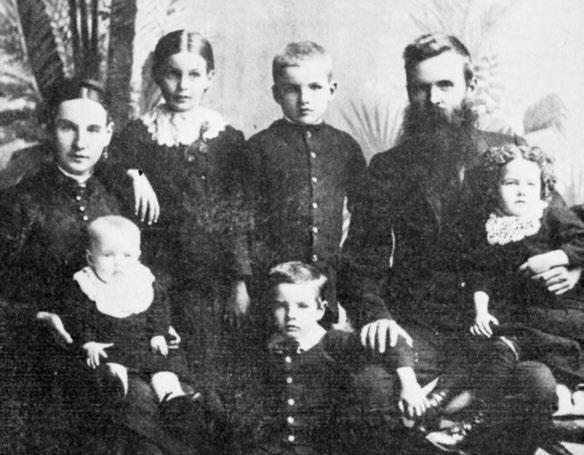


denominations.
If anything, William loved a good party. For more than two decades, his family hosted the area’s biggest blowout social event of the year: the Drummers’ Snack.
At the time, “drummers” were commercial salespeople who travelled the countryside to drum up business (hence the term drummers) – and William wanted to attract them to Alton. The Drummers’ Snack Club was designed not only to organize these notoriously independent operators into a professional association but also to boost the local economy.
With the help of Phebe, his brothers and villagers, William’s scheme paid off. On August 1, 1892, a headline in Toronto’s Globe newspaper read: “Drummers’ Snack: Picnicking Travellers fill Alton with Jollity.” The
Drummers’ Snack became an annual July fete as throngs of drummers were greeted at the Alton train station with great fanfare.
After the mayor’s welcome, the Alton Citizens’ Band, which William financed, escorted the visitors to the village hall for a welcome dinner. This was followed by a flamboyant masquerade parade to Beaver Hill, the Algie home. “The old and fantastic costumes outshone any carnival Venice ever saw,” reported The Globe.
Sprawling across the grounds of Beaver Hill, more than 400 villagers, farm families and day-trippers from 30 miles around joined the drummers for this unique fusion of garden party and trade fair. Carnival tents housed vendors’ tables laden with sales items that ranged from shoes and linens to candy and kitchenware.
The food tables were helmed by Phebe in her makeshift outdoor galley nicknamed the “Cyclone Cellar.” With help from the village women, hot and cold meals sated the hunger of the masses for the entire weekend.
The event roster was an exhaustive jumble of madcap games, races and competitions of every kind, for every age. Millpond swim races, burlesque baseball, a baby show and a broomball match for women were just a few.
In the days before movie theatres and television, the highly popular evening programs featured recitations, dramatic plays and orchestral music.
Every room in Alton’s five hotels was fully booked, with the overflow of drummers billeted with local families. The event was a spectacle! And a success! But as annual attendance grew, it fell victim to its own soaring

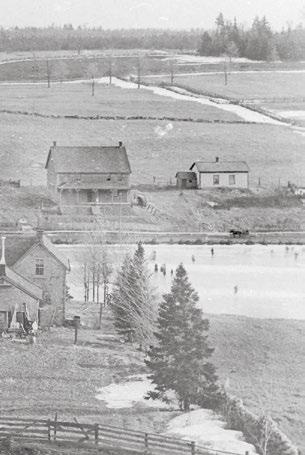
popularity. A staggering 3,000 people attended in 1904. Numbers like this eventually exceeded the Algies’ ability to handle the crowds, and the Drummers’ Snack moved to Erin in 1909. Later, communities such as Oakville, Georgetown and Elora competed for the privilege of hosting the event.
In 1882, William financed and built Alton’s first library, or Mechanics’ Institute, as libraries were called at the time – with Robert as the first secretary and librarian. The Alton Mechanics’ Institute housed nearly 3,000 volumes of technical books providing educational material for tradespeople and skilled labourers, many of them workers at the village’s many mills. By the turn of the 20th century, most Mechanics’ Institutes had been transformed into public
libraries. And so William’s small brick building on Queen Street served as the community library for over 100 years until 1990, when it was replaced by a newer, bigger library on Station Street.
Various archival notes describe William as a “prince of a storyteller,” a “stirring orator” and fittingly, given his role as a woollen manufacturer, someone who “loved to spin a good yarn.” In 1896, for example, he was the guest speaker at the unveiling of a memorial statue in Listowel, Ontario. Sadly, the occasion commemorated the death of 13-year-old Jessie Keith, victim of a brutal Jack-the-Ripperstyle murder.
William’s guest appearance was documented by John Goddard in his true crime book The Man with the Black Valise. The book, which follows detective John Wilson Murray as he tracks Jessie’s killer, inspired the creation of the fictional detective William Murdoch of the popular TV series Murdoch Mysteries
In 1901, William co-hosted the Duke and Duchess of York, later King George V and Queen Mary, when the royal couple visited the expansive Dale Estate greenhouses in Brampton, known as the “Flower Town of Canada.” William’s two sons had married two Dale sisters, and when the sisters’ father died, William became one of the trustees of the thriving business.
During this time, William travelled widely, taking part in trade missions and lecturing on economics. In 1912, while visiting Britain, he planned to travel home on the maiden voyage of the newly built coal-powered steamship Titanic. But a countrywide coalminers’ strike had put the fabled liner’s coal supply in doubt, and




Providing individual and group therapy/counselling, virtually, in-person in Guelph, or in nature.
Specializing in depression, anxiety, grief and loss, trauma, loss of meaning or purpose, and climate/eco anxiety and distress.
Natalie Thomas PhD
Registered Psychotherapist (Qualifying) info@ thomascounselling.com 226-979-5966
CONTINUED FROM PREVIOUS PAGE
fearing potential delays, he fortuitously purchased tickets for passage on an earlier boat.
Shortly after Mark Twain’s death in 1910, it was discovered that the American novelist, travel writer, lecturer, humorist and – evidently –hoarder had stashed away thousands of letters written to him by readers. In 2013, R. Kent Rasmussen curated 200 letters from Twain’s legions of fans –and foes. Dear Mark Twain includes correspondence from farmers, schoolteachers, children, preachers, a
former president of the United States, inmates of mental institutions, con artists … and one William Algie of Alton, Ontario. Not surprisingly, given William’s secular leanings, his letter praised an article in which Twain called the holier-than-thou rector of a New York church “a crawling, slimy, sanctimonious, self-righteous reptile.”
In 1914, William died suddenly at age 63 from an acute attack of indigestion. Belying his rather diminutive gravestone, his funeral was a huge event. Local businesses closed and throngs of people paid their respects. A special CPR train carried family, colleagues and friends to Alton from far and wide.
Robert spoke at his brother’s graveside: “He lived a useful, active, busy life. The world is better for his having lived, and in passing leaves behind the memory of an honest, brave, intrepid man who bowed alone to death. In conclusion, might I add that if everyone to whom he has done some kindly, generous act were to bring a blossom to this grave, he would sleep tonight beneath a wilderness of flowers.”
Nancy Early is a freelance writer who lives in Alton. Her latest book, Once Upon a Forest: Celebrating Orangeville’s Early Years, was published in fall 2023.
Integrative counselling tailored to each person using Internal Family Systems, EMDR, Compassion-Focused Therapy, CBT, Mindful Meditation and Ecotherapy.


William was not the only member of the Algie clan to make headlines in service to their community and country. His brother James graduated from Trinity Medical School at the remarkably young age of 20 and was licensed to practise in 1878. In 1881, James opened his Alton practice on Queen Street, next to the Algie Bros. general store.
As a young doctor in Alton, James found himself treating his older brother Matthew for “inflammation and obstruction of the bowels.” Tragically, the illness proved fatal. Matthew died in 1884, still in his 20s.


In that same year, James was named Caledon Township’s first medical officer. Perhaps his experience with Matthew – and others in the village – inspired him to delve into many of the township’s poor sanitation habits. He tested and proved that animal pens and outhouses built too close to the river and to drinking wells were contaminating water sources and causing serious illnesses. His efforts to change these practices had a profound effect on Caledon and helped end the spread of many deadly diseases.
James was also a writer. Under the pen name Wallace Lloyd, he wrote three well-received novels: Houses of Glass: A Romance, Bergen Worth and The Sword of Glenvohr. A review in Toronto’s Globe newspaper described his books as “bright, piquant, and interesting.”
Like his brothers, James loved and excelled in music, the arts and sports. He was a member of the Alton band and enthusiastically supported the Alton baseball team. Robert, who was a few years younger than William and James, played first base during the team’s glory years in the 1890s and managed the team.
Sadly, James’s only son, Lieutenant Wallace Lloyd Algie, was killed in action in 1918, exactly a month before the armistice was signed. Near Cambrai, France, German machine gunners in and near a neighbouring village had been raking the Canadian position with relentless fire. Lloyd, as he was known to family and friends, and nine soldiers under his command volunteered to clear the machine gun nests. Though the mission was successful and the Canadians captured the village, Lloyd was killed during the operation.
His efforts earned him the Victoria Cross, the highest British military award for valour
British honour because, at the time, Canadian forces were under the command of the British). The Royal Canadian Legion, Alton Branch 449 Lt Algie VC, is named in Lloyd’s honour. His citation says, “For most conspicuous bravery and self-sacrifice, on the 11th October, 1918 ... His valour and personal initiative in the face of intense fire saved many lives and enabled the position to be held.”
(a



















The telltale signs of spring — bulbs, leaf buds and every shade of green — are starting to appear. Let the 2024 gardening season begin!

Handmade in Headwaters
Meet the sculptors, artisans, weavers and other craftspeople who make their home and their wares in these hills.

Don’t miss Don Scallen’s monthly blog on all things flora and fauna in Headwaters. Screech owls, river chub and the songbirds are just a few of the season’s stars.

www.nak-cabinets.ca




Artist Andrea Trace picked up stamp making to add dimension to her mixed media artworks –but the stamps became art unto themselves.
BY JANICE QUIRTTHE EARTHY EXPOSED BRICK WALL OF Andrea Trace’s studio space in Orangeville’s Dragonfly Arts on Broadway is a rustic, aesthetic match for the hand-carved wooden stamps this artist makes and sells here.
Hanging on display are individual stamps – forming outlines of nature-inspired shapes such as a windswept tree or a playful fox – as well as card-making kits with all the ink, stamps and paper a budding stamp enthusiast might need.
Andrea views stamps as an accessible gateway to creativity, allowing beginners to explore their artistic inclinations without the stress of starting from scratch. “Rubber
stamps are confidence builders. You can make something beautiful without fear of failure. It’s a stress-free way to express yourself,” she says, adding that many customers use her stamps for journalling and crafting, so she soon plans to offer beginner journalling workshops. Her own journey into working with this kind of handheld printing press started with her studies at Emily Carr University of Art & Design in 1979. After working in the music industry and as a graphic designer, she sought out stamp carving for both work projects and her own painting. “I loved using words and graphic elements in collages and paintings, but I could never find the right rubber stamps for
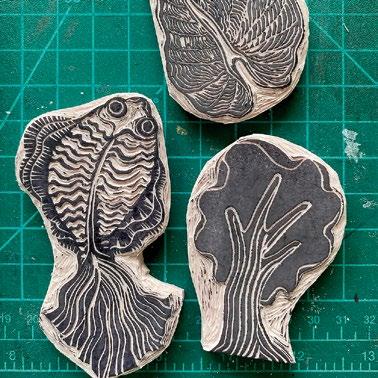
my mixed media art. When I started carving my own, I realized the difference between hand- and machine-carved stamps. Handcarved stamps offer a magical, unique quality that can never be replicated,” she says.
In addition to selling stamps at Dragonfly, Andrea offers stamp-adorned mixed media artworks, buttons and greeting cards. She also stocks emoji stamps on champagne-cork bases and creates logo stamps for business clients.
MAY 4 & 5 2024

Meet Our Cultured Pe A rl e x P ert
Choose from a vast selection direct from the source
Something for every budget
See our website for all the details

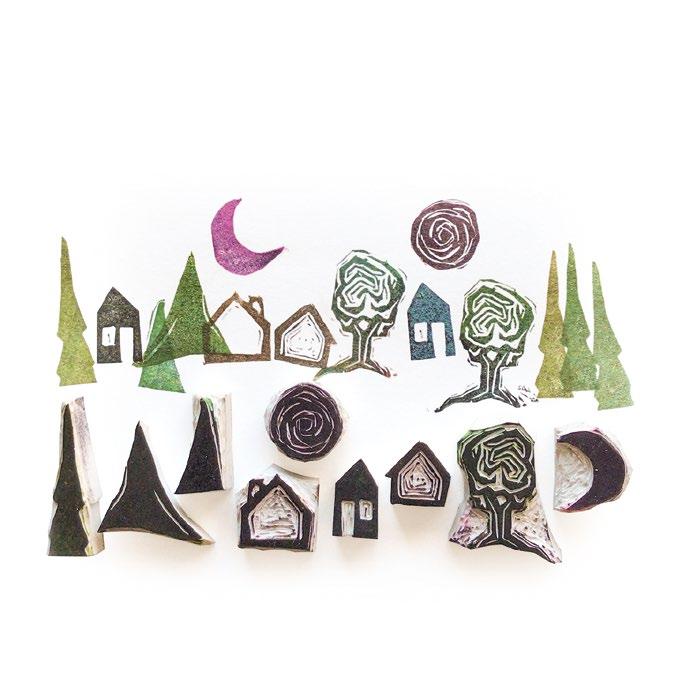
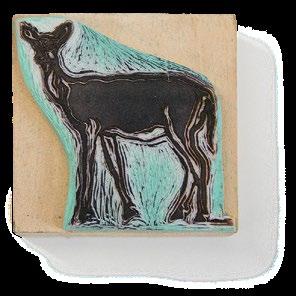
CONTINUED FROM PREVIOUS PAGE
“I usually start with a drawing in my sketchbook, or I’m inspired by a natural object – a tree, leaf, feather or flower. Sometimes I look at the wood mount the stamp will be adhered to and let the ideas flow from the shape of that piece. Stamps can also start as a digital drawing that I transfer onto the lino for carving.”
Andrea favours soft linoleum, aka lino, and often draws a light outline with a fine pencil. She then uses a fine blade – a Speedball lino cutter, to be exact – to carve. To secure the lino onto wood, she uses marine epoxy, a rubber-to-wood adhesive.

www.glamnursejenny.com
As she eliminates what she doesn’t want to appear in the stamped outline, a process she calls “removing negative space,” Andrea stays firmly in the moment. She’ll sometimes, for instance, watch a flower form from the centre outward. “It’s a lovely way to relax and lose yourself,” she says.
Andrea often repurposes materials from her surroundings. Fallen birch branches from her Adjala property provide wood for the mounts, or she may deploy vintage wooden toy blocks found at neighbouring store Blumen on Broadway. As we discuss this, she proudly holds up a bag of scraps that resemble a school of fish. She’s saving these for future designs.
Once the stamp is ready, Andrea uses inkpads from Ranger Ink for her own creations. This ink is archival, permanent and waterproof, allowing her to use watercolours to paint over the stamped images. To achieve a pleasing alchemy, she often uses at least three colours of ink for each design. Or she stamps in black and then fills in the print just as she might with a colouring book.
For Andrea the physical nature of printmaking is thrilling. “The impression into the page, almost embossed, adds a tactile quality that really resonates with me.” Her excitement is contagious as she describes the physicality of pressing ink onto a page, allowing the weight of her body, gravity, the stamp’s characteristics, and the liquidity of the ink to interact with the paper to get the print just right.
Add to that the fact that no two prints will be identical, and you’ll come close to understanding Andrea’s glee. “Humidity, atmosphere, and the steadiness of your hand all contribute to the creation of each image,” she explains. “Every time you lift the stamp, there’s a surprise. The reveal is awesome; it’s a joy to see the tiny artwork you’ve created.”
Find Andrea on Instagram at @andreatrace or on her website: andreatrace.com
ABOVE: A sample of Andrea’s stamps and the impressions she makes.
In summer 2018, artist and designer Patricia Vega started using plants from her garden in Mansfield as the star of her Bohemian in Blue silk scarf collection. She applies the botanical materials to silk scarves coated with a cyanotype emulsion and exposes them to sunlight, resulting in rich Prussian blue patterns that reflect the tranquility of her surroundings. “There’s something magical about this monochromatic effect that makes your eye wander, and find beauty and peace through the powerful colour,” she says. (Medium scarves, $80. Large scarves, $96, Patricia Vega Art + Design)

Caledon’s Becca Weston, a local journalist who has written for In The Hills, and Terra Cotta’s Nyah Lawryshyn met at Carleton University. After graduating in 2023, they started crafting delicate bracelets, naming their beaded jewelry business, Loretta Avenue, after the street where they roomed together. Nyah is of Métis heritage and enjoys beadworking as a way to explore her cultural roots. Both share Italian ancestry, which influenced the incorporation of Malocchio Evil Eye bracelets into the collection. Crystals, freshwater pearls and metal details are other hallmarks of their rings, bracelets and anklets. The pair recently added a men’s line of bracelets. (Glass-beaded bracelets and anklets, $10 to $15. Crystal or pearl bracelets, $15 to $25, Loretta Avenue)
A chance encounter on a Zoom rug-hooking course during the pandemic led Leslie Knight of Caledon and Yvonne Iten-Scott of Erin to realize they were practically neighbours – and they soon started meeting to hook rugs together. The pair opened
The Mill Fibre Art in June 2023 at the Alton Mill Arts Centre, teaching rug-hooking, punch needle, wet felting and wool appliqué, as well as offering fibre art tours. Leslie and Yvonne also sell woolbased products, from pillows to hangings, in bright colours and textures. This November the duo takes on a one-month artist residency at The Textile Museum in Iceland. They hope to hold an exhibition at the Alton Mill after they return. (Wet felted tree kit, $25, The Mill Fibre Art)

SOURCES
Loretta Avenue, Caledon and Terra Cotta. IG lorettaavenue
The Mill Fibre Art, Alton Mill Arts Centre, 1402 Queen St W, Alton. 519-941-9300. IG themillfibreart
Patricia Vega Fine Art + Design, Mansfield. patriciavega.ca
There’s no time like the present!


Helping you make the right move




We specialize in long-lasting asphalt pavement for our residential and commercial clients, with extensive experience paving and resurfacing driveways, laneways and parking lots.






A trail cam – or several – is an ideal way to delight in the diverse wildlife that visits your country property.
BY ANTHONY JENKINS • ILLUSTRATED BY RUTH ANN PEARCEYOU LIKE WILDLIFE. YOU LOVE WILDLIFE , and the fact that animals share your Headwaters property is a source of joy.
But if you want more than a fleeting glimpse of a bounding deer’s white tail, the titillating mystery of tracks in the snow, or a too-late “Oh, look!” as a retreating coyote – or was it a wolf? – slips into cover, a trail camera might be just the thing.
Originally conceived to help hunters track game, cameras are where affordable technology meets love of nature. Trail cams are portable, clock radio-sized, waterproof, battery-powered, motion-activated cameras enclosed in an earth-toned or camouflage plastic shell, mounted outdoors and aimed where animals might travel or congregate. They operate remotely, night and day, year-round.
Images, up to several thousand, or short videos are captured in a postage stamp-sized SD card, which you retrieve and plug into your computer to view the images. And some trail cams offer Wi-Fi connectivity, eliminating the need to physically harvest the card.
Your day could be terrible – the CRA badgering, dinner burned, binge TV series ending – but all will be forgotten with your first look at a curious doe’s wet nose pressed to the camera, up very close and personal.
Krystal Lomas, an aquatic restoration technician at Credit Valley Conservation, monitors trail cams to document returning wildlife. “It’s fun,” she says. “The cameras do all the work. We collect the chips. Sometimes it is long hours grinding through nothing (waving grasses), but then you find something special
(a curious heron’s eyeball right in the lens) and that makes your day!”
What kind to choose?
Online, trail cam prices range from about $40 to more than 10 times that. Some higher-end models allow you to send images and videos to your smartphone, tablet or computer via a local cellular network. Down loadable apps enable you to livestream images and even make technical adjustments remotely.
Trail cam SD cards tend to be more expensive than regular cards because they’re designed to withstand outdoor weather. They start at about $25 each, but are cheaper in bulk. And you’ll go through many batteries – four to eight AA batteries – which drain faster with night and winter use. Alkaline batteries are cheapest, rechargeables are more eco-friendly, and lithiums last longer (three to 12 months) and are best for tolerating temperature extremes.
And consider the flash. A white flash allows for nighttime photos in colour, but can startle animals. Red-glow, low-glow and no-glow infrared flashes don’t, but night pictures are black and white. And a shutter speed of half a second or faster will increase your odds of capturing animals on the move.
In the case of trail cams, a warranty may be wise. Their working life is about two to five years, operating in all elements, but they can break, malfunction (water seepage, leaking batteries) or get stolen.
Choose an accessible area with open views, free of tall grasses or leafy bushes whose motion might
trigger the shutter. Mount the cam waist-high on an adjustable metal stand planted firmly in the ground (a three-pronged model is best), or bind or screw it onto a post or tree. A tree makes better camouflage.
Set up camera sightlines through its small LED screen – a distance of 20 to 100 feet, aimed for the height of the species whose images you want to capture. Tinker with locations over time to find the ideal site – on your property only. No snooping on neighbours!
Harvest the SD cards on your own schedule and replace them with new ones. They are tiny, so keep them in a baggie, and if you’re collecting from multiple cams, label each card and its replacement so you know what animal appeared where.
Jon Clayton uses trail cams both professionally (as an aquatic ecologist with Credit Valley Conservation) and personally.
He is regularly surprised by just how many animals are actually out there. “Way more than you think.” He particularly values trail cam videos. “You get to understand patterns, get insight into behaviours, more so in a 30-second video than in a still photo.”
Creatures you might expect to see include deer and their fawns, bears, foxes, martens, weasels, fishers, skunks, raccoons, groundhogs, muskrats, porcupines, coyotes, wolves, coywolves, opossums, river otters, hares, rabbits, herons, turkeys, pheasants, owls and, much less likely, bobcats, badgers – or Elvis.

Andrea Phillips with some of the home and cottage models her secondary school students are working on.
Secondary school teacher Andrea Phillips brings design to life in an Orangeville classroom with 3D printers, design software and a passion for the built environment.
AT ORANGEVILLE DISTRICT
Secondary School today, tech education includes digital technology. But in 1964, the school’s brand-new tech wing was devoted to technical or trade-focused study. Sixty years later, the signs on the wing’s washroom doors are a reminder that these classes – often called “shop” – were once taken almost exclusively by teenage boys.
But things have changed. Today, tech study knows no limits due to gender, age or background. In the 1960s, students may have gone on to careers in the trades or in architecture, engineering or cartography. Now, they can also consider graphic or interior
BY JANICE QUIRTdesign, industrial or product design, landscape design and so on.
No one epitomizes this new wave more than Orangeville native Andrea Phillips, an energetic young teacher here. Andrea worked for a year as an interior designer as part of her joint Humber College and University of Guelph interior design degree, then went to York University for teacher training. After graduating in 2018, she attended an interview at ODSS in late August and was asked to return that afternoon for a staff meeting. A week later, the newly minted teacher was greeting students on the first day of school!
“I never thought I would combine my schooling in interior design with teaching, but the day the representative from York University visited my Humber College design class to let us know that high schools were in dire need of tech teachers was a life-changing moment. From the first day as a student teacher in a classroom, I knew this is what I wanted to do for the rest of my life.”
So this part-time tech design teacher (she also steps in as a “supply resource”) is now following a job path that didn’t exist when she was born.
7:02 A.M. Andrea’s alarm goes off in Mount Forest. Waiting is her cat,
Shadow, whom she feeds before getting dressed, making toast and starting the 45-minute drive to school.
8:30 A.M. Andrea arrives at the school for tea in the no-frills tech office that is her home base at work.
9 A.M. It’s Block A, aka period 1. This is a prep period, so Andrea is planning the day’s lessons and finishing marking. “Marking is not my favourite part of the job, but I still love it all,” she says.
10:25 A.M. Block B is Andrea’s combined Grade 10 and 12 technological design class of 27 students, working
ROSEMARY HASNER Orangeville tech design teacheron similar themes, but different projects. Design software underpins the creative process. Grade 9 students are introduced to Canva and Adobe Express as easy-to-learn graphic design programs. They use Homestyler for designing home and room layouts.
Grade 12 students use Autodesk Revitor for building information modelling software program. And students explore shapes for 3D printing with the help of Tinkercad.
It’s not all screen time – plenty of physical tools are also used. The Cricut printer uses a small knife to make precision cuts in plastic or paper. And the 3D printers use bio-based polylactic acid-type plastic that is heated and then laid out in a series of triangles to make an object.
A laser engraver or cutter is used to cut wood or metal to add detail or etch a pattern. This week, it’s being used for a project that involves creating miniature model homes.
Students find a style of house they like and create drawings of the house to establish its layout. Next they turn to AutoCAD to map out the pieces they will cut from white foam core, using the laser cutter. Students then assemble their structures with hot glue. Grade 12s are creating houses, while Grade 10s are building cottages. One student chose to design a houseboat, thinking it would be an interesting place to live.
Andrea buzzes around the classroom, visiting students at the computers lining the wall by the windows, or helping with the hands-on cutting, building and printing. She answers the numerous questions posed by inquisitive students, many of whom are interested in careers as graphic or interior designers. The Grade 10 and 12 exam requires students to present their portfolio to the teacher, good practice for the all-important interview component of applying to an art and design school.
11:40 A.M. Lunchtime. On Fridays
Andrea volunteers her time and her classroom to help the 15 to 20 students in the yearbook club.
12:30 P.M. It’s Block C and Andrea is teaching one of the Grade 9 design rotations in exploring technologies. This popular course, taken by about
90 per cent of first years, features four segments: foods, welding, woodworking and design. Andrea teaches the design segment in which four cohorts of 20 students each spend 21 days, or one-quarter of the semester, with her. One of the teens’ favourite projects is making stickers using Canva and Adobe Express. Pets and personalized quotes are popular themes. Another assignment is the “future possibility bedroom.” Students use Homestyler to design a room layout reflecting what they will be doing at a random time in the future. One student included a basketball hoop so he could practise whenever he wanted, even when it was snowing. Another designed the dorm room at the college she hoped to attend. And an auto aficionado designed a room with a window into the garage, so he could gaze at his dream car.
1:50 P.M. Andrea is a supply teacher for this period and she loves the variety this assignment provides. “From time to time the students are given the opportunity to attend a sports game or art or drama show held at the school – this is the period when these events take place. I love to go along with the class to see what the student population is doing in terms of following their passions.”
3:05 P.M. After school Andrea hits a local gym for a workout. She also avails herself of the school board’s wellness program, which offers a six-week block of yoga classes at various schools.
6 P.M. It’s time for home and dinner. Andrea shares her house with two cousins and their assorted menagerie of three dogs, two cats and a bird. They also have a horse that lives down the road.


9:30 P.M. Andrea’s Fitbit alerts her it’s time to start winding down for quiet time, reading and bed. After all, tomorrow is another day full of preparing students for the technology and design possibilities of their future worlds.
Her approach to career enjoyment?
“If you enjoy it, do it! It’s totally gratifying.” Andrea has clearly taken her own advice. “Teaching is my forever future. I absolutely love it.”























LITTLE TRACT INTERPRETIVE TRAIL

The Little Tract has special status in the Dufferin County Forest. Designated “natural,“ there is no hunting, fishing or logging permitted. Happily, the Little Tract’s trees will grow old, and the enormous white pines will continue to take our breath away. In the 1870s, when this area was logged, these pines were too small to harvest and are now over 150 years old. You can download an interpretive guide by Googling “Dufferin County Forest Little Tract.“
WHITE PINE
Eastern white pines are among the longest lived and tallest trees in Ontario. First Nations refer to our provincial tree as “The Great Tree of Peace.“
RED PINE
CANADA HEMLOCK
<
CANADA MAYFLOWER
Referred to as wild lily-of-thevalley, Canada mayflower has berries popular with chipmunks, mice and ruffed grouse. But don’t be tempted, they can make you and your dog ill.
AIRPORT
NORTHERN RED OAK
EASTERN WHITE CEDAR WHITE SPRUCE
Some 4 billion American chestnuts (different from horse chestnuts) died in the early 1900s due to a blight. These disease-resistant hybrids, now up to 30 years old, are part of a regeneration program.
HIKING ETIQUETTE
An easy 2km, 30-minute interpretive hike
Interpretive signs along the trail Map is not to scale #
AIRPORT
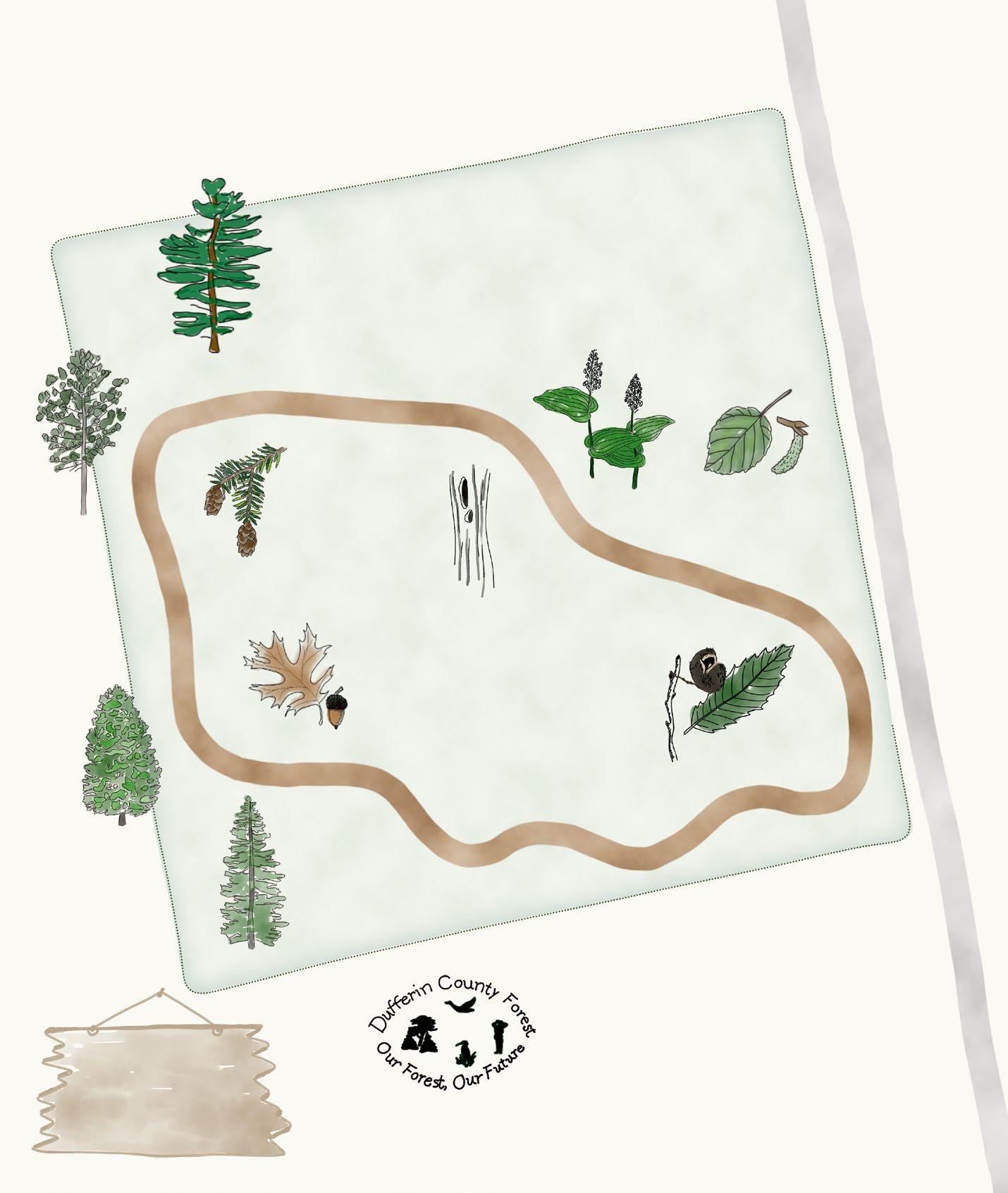 NICOLA ROSS IS THE AUTHOR OF THE BESTSELLING LOOPS & LATTES HIKING GUIDE SERIES
NICOLA ROSS IS THE AUTHOR OF THE BESTSELLING LOOPS & LATTES HIKING GUIDE SERIES

LOOKING AT THE SPARKLY RING ON MY FINGER brings a pang of pain and guilt. It’s my mom’s white gold ring with three gleaming diamonds. She had it designed about 15 years ago by Anne-Marie Warburton who works at the Alton Mill. Transforming three diamonds and a couple of small chippy ones into a modern design kept the memory of her mom and my dad’s mom with her, everywhere she went.
The ring is gorgeous and I’m happy to wear it, but on my hand it feels more hefty than its actual molecular weight.
About a month ago, my mom’s hands became so thin that her rings would no longer stay on. This was after a serious battle with Covid. She lay in her bed, feverish, delirious and unable to get up. My
husband, Derrick, and I took turns sitting on the tiny wooden chair in her room and looked in on her for a few hours a day, every day we could. We gowned up, with mask, face shield, booties.
My mom moved into long-term care in August of last year. Years before, her dementia had progressed to the point where she needed 24-hour-a-day care. My dad stoically took on the task of caring for her as her needs grew. We all became acutely aware of the burden on him and offered to help, and did help, where we could. But dementia is a peculiar disease. It’s pervasive, and the needs of the person with dementia are nuanced and change from moment to moment – leaving caregivers feeling useless a lot of the time and a burden themselves.
My dad, Jim, and my mom, Carol, had screeched into a condo in Orangeville after she broke her hip from a fall, and the weather and challenge of living in rural Everett became too much to handle day in and day out. My dad had lost his driver’s licence at the same time due to his decline in eyesight. It was not a celebratory time as we greeted people in this lovely new condo full of lively people. Covid had chewed up how people were relating, and the move felt like a shock.
Soon the critical care my mom needed could wait no longer. Working with community care folks to arrange her move felt like a puzzle, even with our awareness of “the system.” My dad, Derrick and I all have good language and advocacy skills, but still it
Calling all environmentalists
If you are a future-minded young adult, consider joining the Bruce Trail Conservancy Youth Council to share your skills and your voice in support of preserving this ribbon of Ontario wilderness. The Bruce Trail is one of Ontario’s largest land trusts and the steward of Canada’s longest marked footpath. The council is a network of conservation-
minded youth who advocate for preserving green space, give advice on youth engagement, discuss environmental matters, and participate in events. The BTCYC is seeking passionate individuals ages 18 to 25. (If you’re under 18, the BTCYC suggests you speak to a parent, review its minors volunteering policy, and get in touch). brucetrail.org
Feeling snacky?
25 cents will do it!
One of the happiest little spots to snack out in Orangeville is at … the public library? Yep, you’ve got it. The permanent home of the town’s community food vending machine is at the Mill Street branch of the Orangeville Public Library. This is a perfect pit-stop-on-the-go for hungry kids and families. Veggie sticks, salads, and fresh
wraps or sandwiches drop for just 25 cents each and are prepped by Orangeville’s food bank. That kind of easy access to good, affordable food is a win for everyone. Mill Street Library, 1 Mill Street, Orangeville
Looking for a summer job?
Get help finding a job, starting a new business or learning a skill. These are some of the opportunities the Ontario
government provides for youth seeking summer employment. Of special note: if you’re a youth who selfidentifies as Indigenous and interested in working in the natural environment, there are fantastic natural resource jobs under the Indigenous Youth Work Exchange Program. Point someone you know in the right direction to connect with these well-funded
felt like the ground was shifting under us in the swirl of balancing home care, help and next steps. I can’t imagine what this journey would feel like if a person was on their own without advocates or struggled with language. As we forged toward the day of her move, it felt a lot like we were walking into a tunnel, where the sounds are screamingly loud and muffled at the same time. We bundled up my mom and put her in my car.
Now, she’s tired and it all feels so soon. She’s been very well cared for, but her body and brain are fighting what feels like the final fight. Dementia hits people in different ways – wildly so. Some of her humour and love still come out, but only occasionally. Her moods can still seem so surprising. A lot of discomfort, anger, and complex layers of feelings surface for her as she still finds her own way to advocate for herself: “I hate how this tastes.” “These people are greedy!” “This sweater is awful; undo the zipper!”
I hate that my son, Adrian, sees her like this, and he hates it too. His Gramma has always been kind, giving, sweet and generous. She connected him to the world of animals from an early age – showing him how to groom her horse, Kiera, and how to feed the barn kitties, look after their whippet, Jet, and then their greyhound, Zara. She asked him to fix her computer or TV and he obliged. She only cooked the food he wanted, gave him as much syrup as he liked, allowed sugar cereals, and met him with a smile on vacation. We placed carrots out the front door in Florida for Santa’s reindeers when we visited at Christmastime.
We want her to live forever. And we know she can’t. She fights a fever to get up and take a walk, and this is when I see she’s still my forceful and spirited mom. I imagine her brain lining up chores to do, animal whispering to be done, a horse to tack up and take for a trail ride with me through Mono Cliffs park. She will lead the way, and then when we’re home, we’ll drink tea and discuss the weekend ahead.
This season of her life has been so unexpected, and yet it shouldn’t be, as we’ve already been on a long and relentless journey.
I move her halo of icy blonde hair that lies softly on the pillow, and twirl the twinkling, heavy ring around my finger. I carry you with me every day, Mom.
Bethany Lee is a freelance writer who lives in Mono. possibilities. ontario.ca/page/ summer-jobs-students
Pass it on
Pssst... the time to buy or renew your Family Parks Pass is now. Offered by Credit Valley Conservation in partnership with Toronto and Region Conservation Authority, it’s no secret that this is one of the best bangs for your buck. At just $144 for the
year, it provides admission for up to six people arriving in the vehicle registered to the pass. Locations include four popular CVC parks (Island Lake, Belfountain, Ken Whillans and Terra Cotta), plus nine TRCA parks! See the website for additional benefits and to purchase your pass. cvc.ca/parks-pass
















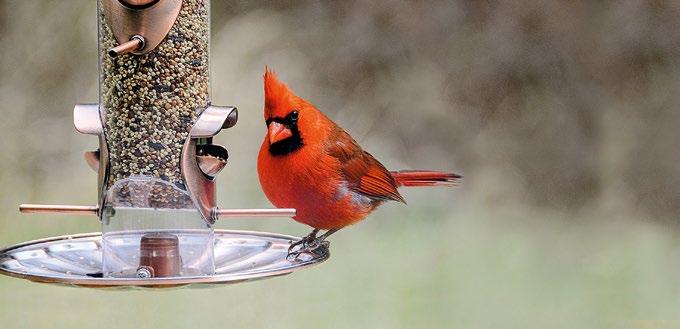


MY NEW HOBBY IS GOING TO THE DOCTOR.
It begins with an appointment with my GP, which is inevitably followed by a referral to a specialist, as well as appointments for tests or lab work, and then a trip back to my GP’s office for a report on the results.
Add to this sessions with the osteopath, massage therapist, audiologist, podiatrist and more, including a somatic therapist, who is helping me explore my mind-body connection.
As you may have guessed, I’ve hit my ninth decade running – well, strolling – and these medical rounds are my new reality.
Wasn’t it just yesterday that the rhythms of my week were determined by activities such as connecting with friends for long bike rides, usually incorporating lunch or dinner on a patio somewhere; or a game of bridge with lots of lively chatter; or hikes along the Bruce Trail; or overnight catch-ups with family or friends in the GTA?
My medical and tune-up appointments are intended to keep this aging body in good enough shape to continue living a full and generous life. But they take so much time that other activities have fallen by the wayside.
And they’re costly – not just in the financial sense, but also in time spent worrying about the next appointment and, post-appointment,

worrying about the outcome.
Times two if you live with a spouse.
I do count my blessings. And I know my challenges are minuscule compared with those of many of my peers. But it can all be somewhat exhausting, both mentally and physically.
As a result, I’ve lately become somewhat obsessed with monitoring my sleep. My Fitbit tracks each night’s statistics by producing a very cool and colourful graph that breaks out how my sleep patterns shift during the hours I spend in bed. Checking how I did the night before has become one of the first things I do every morning.
A recent graph showed I was awake for about 76 minutes, or 15 per cent of my total time in bed, which seems fairly normal for me. As I do most nights, I spent nearly five hours, or 57 per cent of the time, in a state of light sleep, which promotes mental and physical health. A 15 per cent chunk was spent in deep sleep, which helps with physical recovery and aspects of memory and learning, and the remaining 13 per cent was devoted to REM – rapid eye movement –sleep, when dreams are more vivid and the heart rate is elevated, important for memory and mood.
Combined, these statistics earned me a “good” mark from Fitbit, accompanied by a smiley face. That started my day off positively.
Current wisdom suggests adults need between seven and nine hours of sleep a night. Using a car analogy, a recent New York Times article noted the mechanics of sleeping can get a bit rusty with age. Older adults are likely to take longer to fall asleep, wake up more frequently, and spend more time napping during the day. Researchers have also found links between poor sleep and depression, loneliness, anxiety, stress and grief in older adults.
Medications commonly used by the older set, such as diuretics to control blood pressure, can lead to more nighttime bathroom trips. And gaining weight increases the risk of sleep apnea, causing snoring,
walker, 90-year-old John Ferguson currently walks an average of 10 kilometres a day over two or three outings. But “it’s not unusual for me to hike to Orton and back,” he says about the approximately 16-kilometre round trip from his Hillsburgh home. He has been tracking his daily treks since he bought his first mobile phone in 2016.
In 2018, a friend suggested he try a CN Tower Climb. For the uninitiated, there are 144 flights to conquer during the climb up Canada’s tallest landmark, which translates into 1,776 steps. Group climbs are held regularly in support of the United Way and the World Wildlife Fund.
John did the climb twice that first year, in 27:50 and in 29 minutes, and repeated the accomplishment twice again in 2019. Covid disrupted

his plans for the next few years, but he was back at it twice again in 2023. He has averaged 29:09 per climb over the six events.
Born in Oshawa, the first in a family of five boys, John worked at GM for a few years, during which time he became a licensed pilot with 30 hours’ training, the total requirement back then. (Today, commercial pilot training entails a minimum of 80 hours ground-school and 200 flight hours.)
He joined the RCAF in 1955 for an 11-year stint, married, fathered two children, Derek and Linda, and served across the country at bases in Cold Lake,
John Ferguson first climbed the CN Tower’s 1,776 steps in 2018 when he was 85. He has repeated the challenge five times since. PETE PATERSON / STOCK
gasping for air and feeling like you’re choking.
The good news is that the same habits that promote general good health – and fewer trips to the doctor –can also lead to better quality sleep. A healthy diet, exercising regularly, avoiding naps and caffeine in the afternoon, and going to bed at the same time every night are all things that can promote good sleep. Checking that your current medications remain right for you is also a good idea.
Spending time in sunlight is another way to help maintain the body’s circadian rhythms in balance. And avoid watching that last Netflix episode right before hitting the hay, likewise that last phone scroll. The blue light produced by computer screens and LED TVs interferes with the transition from wakefulness to sleep. Instead, to help prepare for sleep, create an unwind routine, such as reading a book. A friend of mine does a gentle 10-minute qigong routine before bed. She reports this ancient Chinese practice helps her sleep better and feel less stiff in the morning.
A good night’s sleep may not be the only route to good health and graceful aging, but at the very least it can help maintain the stamina we need to stay on top of our busy appointment schedules.
Gail Grant is a happily retired senior who lives in Palgrave.
North Bay, Bagotville and Gander.
In 1966 the family moved to Toronto, where he joined Air Canada as a pilot. When he retired, he and his wife relocated to Calgary, enjoying the outdoor hiking offered by the close proximity to the Rockies, and even doing some heli-hiking.
John has lived in Hillsburgh since 2014, close to both children, and intends to take on the tower climb as long as his health allows.
“Derek, who’s now 62, did it with me twice last year, and says he’s game again,” John says. They’re scheduled to participate in the WWF Climb for Nature on April 20.
John’s good health and positive attitude have allowed him to continue to challenge himself but he has no inclination to be tethered to the rail of the 553-metrehigh tower and hang over the city, an option for those who make it to the top.


A 178 year old Caledon farmhouse is a peaceful yet exuberant testament to owner Elaine Woodward’s singlemindedness and the nearly 20 years she has worked to bring her vision to life.
AS ELAINE WOODWARD AND her old English sheepdog, Prairie, lead a tour of her exquisitely renovated 1846 Caledon farmhouse, we all stop at the top of the central staircase and turn back toward the front of the house. Light from a Gothic window illuminates the entire upper hallway and is complemented by the reproduction pendant light hanging gracefully in front of it. Shiny vinyl
BY GAIL GRANT • PHOTOGRAPHY BY ERIN FITZGIBBONthat looks for all the world like vintage tin covers the ceiling, reflecting and intensifying the luminous quality of the light in the area.
When Elaine bought the house 19 years ago, it had very few windows, so adding more natural light was a priority. On the upper floor of the original house, dormers were the answer: one at the front to accommodate the Gothic window, and two at the rear.
“This space has a mystical, almost spiritual, quality,” says Elaine, a feeling she says is enhanced by the Gothic window.
During her teen years, Elaine had enjoyed owning, riding and showing quarter horses, and she vividly remembers driving the byways of Caledon – horse country – and wishing to live there one day. “I was the type of kid who insisted on stopping
to pat every horse who was hanging its head over a fence,” she says. Her love of horses continued, as did her dream of calling Caledon home.
While searching for a Caledon property, she set out one day from her Etobicoke home armed with a list of properties to view. Sidetracked by a detour, she came upon an Open House sign and, on a whim, decided to take a look.


“I got goosebumps as I turned into the driveway,” she says. “Cattle were grazing peacefully in the field next door, and while a magnificent stand of 100-foot Douglas firs hid the house from the road, I remember thinking that I would happily make whatever changes were necessary to the house itself,” she says.
The homeowner happened to be on hand while she was touring the
house and mentioned a small water course running through the property. After fighting her way through an acre of sumac, Elaine finally found a crooked brook with a captivating little waterfall. That was one of several deciding moments.

After buying the property, she spent three years clearing the eight acres around the house. An independent sales representative for five large

LISTING



TOP: A central staircase cuts through the main floor of the house. Elaine renovated the space to reveal the original log structure and pine ceiling beams.
VISIT US
154B Mill Street
Creemore, ON L0M 1G0
info@suzannelawrence.ca suzannelawrence.ca
CONTINUED FROM PREVIOUS PAGE
companies, most dealing with home decor and kitchen and garden accessories, she would travel all day for work, then drive home, hop onto a Scotts lawn tractor with a 32-inch deck, and mow sumac. She was grateful the tractor had headlights because she was often still going at it after dark.
Many of those hours on the mower were spent visualizing the updates to come.
The first major renovation in 2008 tackled the outside of the house.
The exterior plaster, wire mesh and newsprint insulation were removed –to reveal magnificent hand-hewn hemlock logs, some of them 22 inches wide. “Apparently, the look of exposed log walls was not a popular one back in the day,” says Elaine. “The removal


of the lath and plaster covering was an incredibly messy but thoroughly satisfying job.”
Unfortunately, the logs had cracked over the many, many years, inviting drafts to enter the house. So she chose to insulate the exterior and cover it with board and batten siding, a design decision that draws the eye upward to create the impression of height, a perception enhanced by the tall dormer that is now a compelling


feature of the front of the original house.
The front porch, built by a previous owner, was also given a makeover. Taller windows were added with a thought to the future, for Elaine’s vision included opening up the main floor. Eventually. When that was achieved, the wall of windows would allow light to flood in.
On the west side of the house, an addition was built to accommodate a










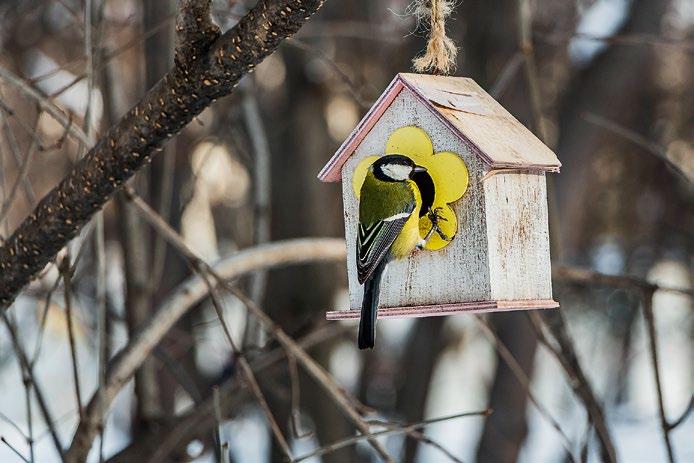




TOP: Elaine’s peaceful bedroom features a paredback, lighter palette.
FAR LEFT: A love of hockey and Formula One racing inspires a few eclectic touches in the home. The bright yellow Muskoka chair was signed by Bobby Orr.
NEAR LEFT: A sleek bathroom was added as part of an addition on the west side of the house.
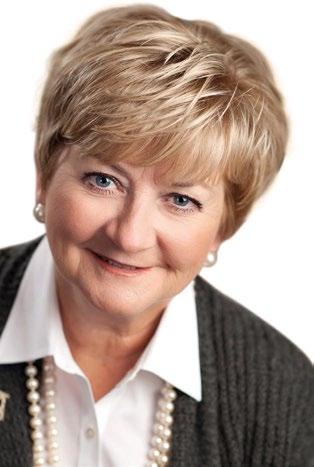



CONTINUED FROM PAGE 101
lower-level workout room and wine cellar, an office area on the main floor, and a principal suite with a walk-in closet on the upper floor.
That next major reno, which focused on the interior, came in 2015. Various coverings on the interior walls were torn off to expose the logs, and the front wall of the original house was demolished. Two blackened steel posts, resting on elegant plinths, now support the structure.
“Renaissance Fabrication Co. understood my vision and came up with a plan to keep the structure sound while opening up the space,” says Elaine.
The same company installed two more steel posts to provide structural support once the walls that enclosed the original central stairway were removed. A floating staircase, also created by Renaissance Fabrication, replaced the original stairs and now separates the living room on one side from a new kitchen and eating area on the other. The original stair treads were incorporated into the new staircase.
The 10-foot ceilings on the main floor are supported by rough pine beams, likely harvested from the property when the house was first built, and on the lower level the round support beams are still covered with bark. Where possible, the original 10-inch baseboards were salvaged and reused, and the remainder was milled to look like the original.
Not surprisingly, the renovation process has been both painstaking and full of twists. “When you’re dealing with renovating a home of this vintage, you can almost guarantee things won’t
CONTINUED ON NEXT PAGE


www.veronateskey.com

Elegant lighting inspiration in Caledon. Online shopping with free delivery in the GTA. caledonlighting.com
905 857 4442

For your electrical needs –hot tub & spa packs, PVC pipe & wire, LED lighting & lamps. boltonelectricalsupply.com
www.boltonelectricalsupply.com
905 857 4445
55 Healy Road, Units 6&7, Bolton



full service residential interior design and decor from concept and design to execution design@donatodecor.com
519.938.6931
CONTINUED FROM PREVIOUS PAGE
go according to plan,” says Elaine. “My contractor, Eric Wiedeman of Wiedeman Restoration Services, lived up to his excellent reputation and saw me through each of my major renovations.”
She adds, “While I’m always optimistic that I can improve the timeline, each renovation caused approximately one year of personal disruption.”
The pared-back canvas Elaine has created enables her to imprint her

quirky, eclectic style and personality on the house. Colourful, intriguing paintings by Toller Cranston, the iconic Canadian figure skater and artist, are featured throughout. “Toller and I were friends, and I just love his work,” she says. “I was given one of his paintings for my 40th birthday … that was the beginning of my collection. It was a very sad time for me when he passed [in 2015].”
Elaine’s Mickey Mouse memorabilia add a touch of whimsy. “I still have my first set of ears, plus my membership certificate in the Mickey Mouse Club,”
she says. “These elicit fond memories of my happy childhood.”
Elaine also calls herself a “Formula One nut.” Posters, pictures and paintings related to F1 drivers take up much of the wall space in the guest bedroom. She is also a woman of many hats – literally. An entire wall of her dressing room is devoted to her collection of about a hundred F1 ball caps and caps from rock concerts … think Bruce Springsteen, the Rolling Stones and U2. (Fun fact: Elaine once drove the entire 2,448 miles of the historic Route 66 in her own








CONTINUED FROM PAGE 104
Aston Martin DB9). In keeping with her sporty aesthetic, a bright yellow Muskoka chair signed by both Bobby Orr and Don Cherry occupies pride of place on the lower level.
During the warmer months, Elaine spends a good deal of time in the covered outdoor living space, formerly the carport, to the east of the house. A charming L-shaped seating area, equipped with a barbecue, renders the space both useful and inviting. Nearby is a huge fire pit, a
popular place to gather with friends in the early spring and fall. And thoughtfully placed plantings, both near the fire pit and around the house, create a soothing vista.
For Elaine, the long renovation process has been truly fulfilling. “To see what I envisioned when I first drove down the driveway come to life is exhilarating,” she says. “I didn’t fully appreciate what I’ve done until after my last reno in 2021. There isn’t really anything more I want to do, so now I am enjoying my home to its fullest with my beautiful dog, Prairie – and I hope to do so for many more years.”


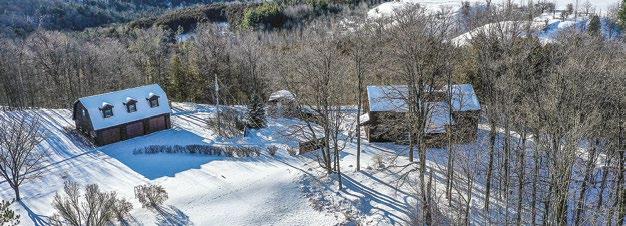















Open the private gates to a resort landscape: ponds, perennials, sitting areas, bird sanctuaries, a romantic swing all staring at the Credit River Main floor is stunning with 3 bedrooms and 2 baths Down below is a 2-bedroom modern apartment with its own laundry and entrance

Gorgeous bungalow in a sought-after executive subdivision in the Village of Hillsburgh Perfect floor plan with 3+1 bedrooms and 4 bathrooms Stunning curb appeal with stone and brick exterior, plus a fantastic lot with professional landscaping

Incredibly well maintained for
years by the same owners 3 bedrooms, 1 bathroom; this little gem packs a punch! Situated in a lovely neighbourhood right in the Village of Erin, walking distance to all the shops, cafes and services

Get ready for this spacious 4-bedroom, 4-bathroom family home! Open-concept kitchen overlooks the warm and inviting living room with a gas fireplace Large back deck has incredible views of the yard and the protected countryside behind

Lovely living/dining room with a warm woodburning fireplace opens to the bright 3-season sunroom 3 bedrooms, 3 bathrooms, main floor laundry lower-level rec room with a bar and extra unfinished rooms just waiting for you

Sensational 7-year-old custom build Gorgeous kitchen opens up to the great room with coffered ceilings Over 6,000 square feet of living space with custom cabinetry hardwood floors and marble countertops all on just over 2 acres, but with a view of 20

Multi-level families! Need an in-law suite? Room for the kids? Look no further! This turnkey investment has 2 complete units for a total of 5 bdrms, 3 baths and 2,800 square feet An ideal income generating property!

This 4+1-bedroom












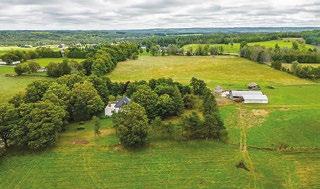







































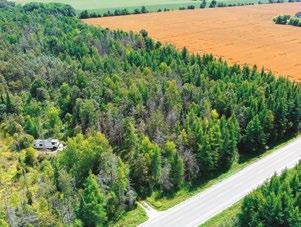



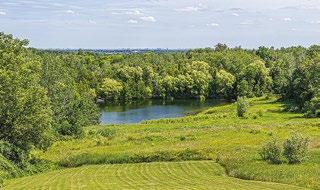















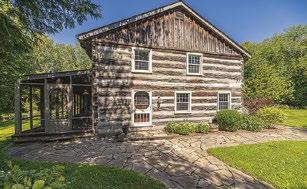

Wayne


68 acres of manicured grounds and absolute privacy Gated entry leads you up the hill to the 6-bedroom, 6-bathroom, 2-kitchen home with panoramic views 11,000 sq ft of impressive finished living space, 72’ long great hall with 34’ ceiling leading to nothing short of magnificent Large workshop, inground pool and tennis court $5,399,000 Wayne Baguley 519-941-5151


Two 1800s log cabins sculpted together & on 56 27 ac Wood beam ceilings, original wood flrs, 3+1 bdrms & 3+1 baths Enjoy tranquility of a private pond, trails & embrace the outdoors from the wrap-around deck Perfect retreat with timeless appeal, combining classic architecture with modern comfort 2 driveway entrances from two paved roads $2,399,000 Wayne Baguley 519-941-5151

Hockley estate with river running through 6 7 acres with pool, stone outdoor fireplace with cooking abilities, large gazebo, workshop, bunkie and log guest house for entertaining Walking trail/pond with island 6 bedrooms 5 bathrooms including separate in-law suite $2,899,000 Wayne Baguley







C U S T O M R I V E R F R O N T H O M E I N C H E L T E N H A M
Welcome to The Riverbrook House A rewarding escape peacefully situated on 1 2 acres backing onto the Credit River A tranquil 3 plus 1 bedroom 4-bathroom home that is situated in a sought-after area of southwest Caledon Upgraded kitchen and baths, a 30ft vaulted ceiling in the great room and a finished walkout basement Wrap-around deck with picture perfect views of the river This property exemplifies country living while still being a short drive to the city 95 Credit Rd, Cheltenham $1,999,000


w/ two deeds!


112 / IN THE HILLS





Page 1






















Private



























& Trafalgar Rd are nearby when the city calls but you'll never want to leave home
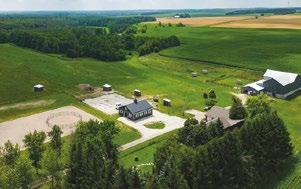

Two homes! Two barns! Situated on 28 private acres, this fabulous property offers flexibility of a personal stable and/or income Restored 4-bdrm main home with large principle rooms including large kitchen, finished bsmt & pool 2-bdrm second home with great room/kitchen & family room New HFH barn with 100x200 sand ring, 8 paddocks with waterers Second barn
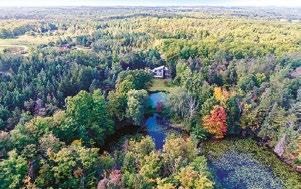

COMPILED BY JANET
KERRMAR 19, APR 16, MAY 21 & JUN 18 :
ORANGE THREADS Conversations on reading and all things fibre arts. 1-2:30pm. Orangeville Library, 1 Mill St, Orangeville. 519-941-0610; orangevillelibrary.ca,
MAR 19, APR 2, 16 & 30, MAY 14 & 28,
JUN 11 & 25 : AFTER HOURS WRITE CLUB Writing workshop with local author Anthony Carnovale. 7pm. Free, register. Orangeville Library, 1 Mill St, Orangeville. orangevillelibrary.ca
MAR 20 – APR 21 : REJUVENATION A vibrant exhibition of 30+ works of art by 20+ artists celebrating spring. Wed-Sun 10am-5pm. Free. Alton Mill Arts Centre, 1402 Queen St, Alton. Headwaters Arts Gallery, 519-943-1149; headwatersarts.org
MAR 26, APR 23 & MAY 28 : ROSE’S BOOK CLUB Discussions and recommendations of noteworthy books. No required reading. 2-3pm. Free. Shelburne Library, 201 Owen Sound St, Shelburne. 519-9252168; shelburnelibrary.ca
APR 6 & 7 : STUDIO TOUR KING Local artists from King City, Nobleton and
• ILLUSTRATIONS BY JIM STEWART
Schomberg, and guest artists from neighbouring communities. 10am-4pm. Free. King Heritage and Cultural Centre, 2920 King Rd, King City. Arts Society King, 905-833-2331; artssocietyking.ca
APR 11 : AUTHORS ON STAGE –ROMÉO DALLAIRE A discussion with Roméo Dallaire about his new book, The Peace: A Warrior’s Journey, moderated by former CBC host Carol Off. Proceeds to Theatre Orangeville’s New Play Development Fund. 7-9pm. $35, at BookLore, Theatre Orangeville or online. Town Hall Opera House, 87 Broadway, Orangeville. 519-9423423; theatreorangeville.ca
APR 12 : RUPI KAUR Celebrate Sikh Heritage Month with Brampton’s own internationally acclaimed poet and artist. 8pm. The Rose Theatre, 1 Theatre Ln, Brampton. Brampton On Stage, 905-874-2800; tickets.brampton.ca
APR 18 : FLOWER CITY SLAM A poetry and spoken word competition with $500 in prizes and a spot on the slam stage. 8pm. The Rose Studio, 1 Theatre Ln, Brampton. Brampton On Stage, 905-874-2800; tickets.brampton.ca
APR 24 – MAY 26 : CHOICE & CHANCE Patrice Baker and Nancy McNabb present abstract pieces exploring creativity. WedSun 10am-5pm. Free. Alton Mill Arts Centre, 1402 Queen St, Alton. Headwaters Arts Gallery, 519-943-1149; headwatersarts.org
MAY 1 – 31 : FORMS, FACES & SPACES, FIGURATIVELY SPEAKING! Part of the Scotiabank CONTACT Festival, the “world’s largest photography event.” Special weekend events, music and more. See website for locations and events. Wed-Sun 10am-5pm. Alton Mill Arts Centre, 1402 Queen St, Alton and Melville White Church, Caledon. Studio By Design, 647-466-1896; studiobydesign.ca
MAY 4 : STARTS – SPIRIT TOUCHES ART TOUCHES SPIRIT Celebrate painting, sculpting, woodworking, pottery, dance, music, singing, recitations and more! 10am-3pm. Free. Trinity Primrose United Church, 200 Owen Sound St, Shelburne. shelburneprimrose.com
MAY 25 : ARTS BY THE POND Interactive art, music and culinary delights. 10am-4pm. Donations accepted. Hillsburgh Library, 9 Station St. Over Here Community Arts Adventure, overhere.ca
MAY 25 : TAPESTRY OF ART & MUSIC Art show and sale fundraiser for Headwaters Arts. Music by the Achill Choral Society. 1-5pm. Free. Alton Mill Arts Centre, 1402 Queen St, Alton. Headwaters Arts Gallery, 519-943-1149; headwatersarts.org
MAY 25 – SEP 3 : OH MY DOG! Historical and contemporary works focusing on the dog. PAMA, 9 Wellington St E, Brampton. 905791-4055; pama.peelregion.ca
MAY 26 : LIBRARY LITERARY EVENT FEATURING IAN HAMILTON Ian speaks about his new book, The Fury of Beijing. 2-3pm. Free. Shelburne Library, 201 Owen Sound St. 519925-2168; shelburnelibrary.ca
MAY 29 – JUL 1 : WHERE THE WILD THINGS ARE Works in a variety of mediums harnessing the untamed side of your imagination! Wed-Sun 10am-5pm. Free. Alton Mill Arts Centre, 1402 Queen St, Alton. Headwaters Arts Gallery, 519-943-1149; headwatersarts.org
JUN 22 : MARY SCATTERGOOD OPEN HOUSE & SALE Join Mary, local folk artist, at her studio and gallery. Noon5pm. 20451 Porterfield Rd, Caledon. 416-998-2008; maryscattergood.com
ORANGEVILLE WINTER FARMERS MARKET NOW – APR 20: Saturdays, 9am-1pm. Orangeville Town Hall, 87 Broadway. orangevillefarmersmarket.ca
CREEMORE SPRING FARMERS’ AND CRAFT MARKET MAR 30 & APR 13: 9am-1pm. Creemore Station on the Green, 10 Caroline St E. creemorefarmersmarket.ca
CONTINUED ON PAGE 118


WORLD PREMIERE
WORLD PREMIERE
CONTINUED FROM PAGE 116
SUMMER MARKETS: OPENING DAYS
MAY 4: ORANGEVILLE Saturdays, 8am1pm. Orangeville Town Hall, 87 Broadway. orangevillefarmersmarket.ca
MAY 18: CREEMORE Saturdays, 9am1pm. Creemore Station on the Green, 10 Caroline St E. creemorefarmersmarket.ca
JUN 20: ERIN Thursdays, 3-6:30pm. Erin Fairgrounds, 184 Main St. villageoferin.com
JUN 26, JUL 24, AUG 28, SEP 25, OCT 9: GRAND VALLEY Wednesdays, 3-7pm. Elizabeth Taylor Pavilion, 32 Water Street. grandvalleyfarmersmarket@gmail.com
NOW – ONGOING : THE SUITCASE
PROJECT Over 80 4th- and 5thgeneration Japanese Canadians and Americans share what they would pack if forcibly removed from their homes today. PAMA, 9 Wellington St E, Brampton. 905-791-4055; pama.peelregion.ca
NOW – ONGOING : LII BUFLO: A MÉTIS
WAY OF LIFE Buffalo are an integral part of Western Métis culture, heritage and kin. PAMA, 9 Wellington St E, Brampton. 905-791-4055; pama.peelregion.ca
MAR 16 : CALEDON SENIORS’ CENTRE ST. PATRICK’S DAY LUNCH & EUCHRE Corned beef dinner. Prize for best costume. Lunch and tournament $20; lunch only $16; tournament only $15, register. 11am-5pm. 7 Rotarian Way, Bolton. 905-951-6114; caledonseniors.ca
MAR 17 : THE COVID GAMBIT FUNDRAISING CHESS TOURNAMENT
Real-life chess drama, seven rounds of rapid chess time control (ten minutes). Rated and unrated. Proceeds to mental health programs. 11:30am-4pm. $20. Brampton Civic Hospital, 2100 Bovaird Dr E. William Osler, 905-4946556; support.oslerfoundation.org
MAR 20, APR 17 & MAY 15 : CREEMORE HORTICULTURAL SOCIETY MEETINGS
Mar 20: Growing Succulents. Apr 17: Where Have All the Flowers Gone? May 15: Bring a Friend Night. Plants that Changed the World. 7-9pm. Creemore Station on the Green, 10 Caroline St E. 705-466-3170; creemorehort.com
MAR 21, APR 18 & MAY 16 : FREE HEARING WELLNESS CLINIC
Hearing test, hearing aid cleanings and checks. 10am-noon. Free, register at 905-857-4327. Caledon Specialist Clinic, 18 King St, Bolton. CCS, 905-584-2300 x230; ccs4u.org
MAR 21, APR 18 & MAY 16 : ALZHEIMER
SOCIETY OF PEEL – DEMENTIA
DAY Drop in for free information and resources. 10am-2pm. Free. Caledon Specialist Clinic, 18 King St, Bolton. CCS, 905-584-2300 x230; ccs4u.org
MAR 21, APR 18 & MAY 16 : LADIES’ AUXILIARY LUNCHEON SHELBURNE
LEGION BRANCH 22 Meet new friends and enjoy a full meal.
11:30am-1pm. $12. Shelburne Legion, 203 William St, Shelburne
MAR 22, APR 26 & MAY 31 : CALEDON
SENIORS’ CENTRE MONTHLY DINNERS
Mar 22: Guinness stew. Entertainment by the Sentimental Journey Band. $25. Apr 26: Baked pasta and sausage. $16. May 31: TBD. $16. Call to register. Pickup, dinein or delivery. 7:30pm. 7 Rotarian Way, Bolton. 905-951-6114; caledonseniors.ca
MAR 25, APR 29 & MAY 27 : STIR THE
POT Join friends to prepare soup for the food bank and shelters. No experience necessary. $60, includes wine, dinner and ingredients. Lavender Blue Catering and Café, 125 Broadway, Orangeville. 519939-3663; lavenderbluecatering.com
MAR 26 & MAY 28: ARCHIVIST
ON THE ROAD MoD’s archivist extraordinaire, Laura Camilleri, answers research questions. 10am. Free. Shelburne Library, 201 Owen Sound St. 519-925-2168; shelburnelibrary.ca
MAR 27 : CALEDON SENIORS’ CENTRE
SPECIAL EASTER LUNCHEON
Shepherd’s pie and dessert. Call by Mar 25 to register for dine-in, pick up or delivery. 11:30am-1pm. 7 Rotarian Way, Bolton. 905-951-6114; caledonseniors.ca
MAR 30 : TEEN RANCH EASTER
ROUNDUP Egg hunts, petting zoo, pony and trail rides, giant swing, indoor ice skating, hayrides and more! 1-5pm. $50. 20682 Hurontario St, Caledon. 519-941-4501; teenranch.com
MAR 30 : WINDRUSH DANCES
AROUND THE WORLD Young? Old? Trained or not, one-hour class before the event, one hour of open dancing. $25, includes drink. Proceeds to underserved kids through youthLEADarts.com.
3-5pm. Chateau Windrush, 3030 Conc Rd 3 Adjala. Dance Orangeville, 416763-6565; danceorangeville.com
APR 5 – 7 : ORANGEVILLE HOME & GARDEN SHOW Home improvement, gardening and landscaping, artisans,
CCS
Caledon Community Services
CPCC
Caledon Parent-Child Centre
CVC
Credit Valley Conservation
CPL
Caledon Public Library
DCAFS
Dufferin Child and Family Services
DPSN
Dufferin Parent Support Network
EWCS
East Wellington Community Services
MOD
Museum of Dufferin
NVCA
Nottawasaga Valley Conservation Authority
PAMA
Peel Art Gallery, Museum and Archives
SBEC
Orangeville & District Small Business Enterprise Centre
APR 11 : MINI MOD MoD’s archivist extraordinaire, Laura Camilleri, highlights objects in the collection. 6-7pm. Free. Shelburne Library, 201 Owen Sound St. 519-925-2168; shelburnelibrary.ca
APR 11, MAY 9 & JUN 13 : ORANGE
VILLE & DISTRICT PROBUS MEETINGS Club for socially-engaged men and women, retired or semiretired. Apr 11: Sara McCrae from Climate Action, Dufferin County. May 9: Jane Lightle, Island Lake programs. Jun 13: Nicola Ross, Walks and Hikes in the Orangeville area. 10am-noon. New Hope Community Church, 690 Riddell Rd, Orangeville. 519-938-8934; probusorangeville.club
APR 13 : SPRING EQUESTRIAN
TRADE SHOW All disciplines, all breeds. Vendors, information and seminars. Table $35. Admission: donation to food bank (personal hygiene items). 10am-3pm. Alliston Legion, 111 Dufferin St S, Alliston. Trail Ride for Breast Cancer, 416-407-6695; trailrideforbreastcancer.weebly.com
APR 13 : CALEDON SENIOR’S CENTRE
LUNCHEON & EUCHRE Mild Italian sausage, fried onions. $20; lunch only $16; tournament only $15, call to register. 11:15am-5pm. 7 Rotarian Way, Bolton. 905-951-6114; caledonseniors.ca
APR 18 : HFFA WINTER HARVEST
DINNER Save the date! Tickets available soon. Join our mailing list to get notified first. 6pm. Mrs. Mitchell’s Restaurant, 887395 Mono-Mulmur Townline, Violet Hill. Headwaters Food and Farming Alliance, hffa.ca
pet treats, retirement info and more. Fri 5-9pm. Sat 9am-5pm. Sun 10am-4pm. Free entrance and parking. Orangeville Fairgrounds, 247090 5 Sdrd, Mono. Orangeville Lions Club, orangevillelions.org
APR 9, MAY 14 & JUN 11 : ORANGEVILLE & DISTRICT HORTICULTURAL SOCIETY MEETINGS Apr 9: Summer Bulbs. May 14: Know Your Limit. Garden Within It. Jun 11: Proud of My Pruning. Guests welcome, bring a mug, prize draw. 6:30-8:30pm. Orangeville Senior Centre, 26 Bythia St. orangevillehort.com
APR 10 & MAY 22 : CALEDON
SENIORS’ CENTRE SPECIAL LUNCHES
Apr 10: Grilled cheese, pasta salad and dessert. $11; local delivery $2. Call to register by two days before. 11:30am-1pm. 7 Rotarian Way, Bolton. 905-951-6114; caledonseniors.ca
APR 20 : CALEDON HORSE TACK
SWAP Two buildings of new and used horse equipment for sale. Free entry for shoppers, vendor fees apply. 10am-3pm. Caledon Fairgrounds, 18297 Hurontario St, Caledon Village. 519-925-3461; caledonfair.ca
APR 20 : HOUSE HISTORY WORKSHOP
Learn about researching historic buildings. 10am-noon. $15. Museum of Dufferin, Airport Rd & Hwy 89, Mulmur. 1-877-941-7787; dufferinmuseum.com
APR 27 : KNOX SPRING MARKET & BAKE SALE Early Mother’s Day shopping with 15 vendors! 9am-2pm. Knox United Church, 2976 Charleston Sdrd, Caledon Village. 519-9273320; knox-united-church.org

WRITTEN AND DIRECTED BY CRAIG FRANCIS AND RICK MILLER
A KIDOONS AND WYRD PRODUCTION IN ASSOCIATION WITH THE 20K COLLECTIVE
APRIL 11, 2024
A DAZZLINGLY ORIGINAL STAGE ADAPTATION OF THE WORKS OF RUDYARD KIPLING.
BHANGRA & BEYOND: TORONTO SYMPHONY ORCHESTRA
APRIL 13, 2024
EXPLORE NEW SOUNDS INFLUENCED BY THE MUSIC OF SOUTHEAST ASIA AND THE INDIAN SUBCONTINENT.
360 ALL STARS
APRIL 24, 2024
A SUPERCHARGED URBAN CIRCUS, BOASTING A CAST OF WORLD CHAMPION ATHLETES AND ARTISTS.


CONTINUED WHAT’S ON
FROM
118
APR 27 : SPRING LITERARY TEA: HARRY POTTER EDITION The finest teas and delightful treats inspired by the wizarding world. 10:30am, noon, 1:30 & 3pm. Each tea time limited to one hour. $30, email springliterarytea@ gmail.com. King’s College School, Caledon East. eventbrite.com
APR 27 : CAR RALLY, SCAVENGER
HUNT & DINNER Create a fun team name and have a blast. $25; children 10 & under $15, at Butcher Furniture in Hillsburgh, or the church Sun, Tue-Thu mornings. St. Andrew’s Presbyterian Church Hillsburgh, 519-855-6216; pccweb.ca/standrews-hillsburgh
APR 28 : BIODIVERSITY & OUR HEALTH: AN INDIGENOUS
PERSPECTIVE Dr. Andrew Judge from Algoma University shares how this worldview affects our connection to the environment. 2-4pm. Free. Monora Park Pavilion, 500 Monora Park Dr, Mono. Mono Mulmur Citizens’ Coalition, monomulmur.com
MAY 3 & 4 : CALEDON DUFFERIN
WOMEN’S SHOW Celebrate women with a sip-and-shop Mommy Market, workshops, baby products, entertainment and more. Monora Park Pavilion, 500 Monora Park Dr, Mono. sparkleandsass.ca
MAY 4 : HOME & HEALTH SHOW
Visit local businesses offering products and services for a healthy home. $5 or two non-perishable food items for the food bank. 10am-4pm. Brampton Fairgrounds, 12942 Heart Lake Rd, Caledon. bramptonfair.com
MAY 4 & 5 : ORANGEVILLE MYSTIC
MARKET Visit 40+ vendors showcasing Gothic wedding décor, tarot readers, healers and more. Sat 11am-7pm. Sun Noon-5pm. Orangeville Curling Club, 76 Fifth Ave, Orangeville. Canadian Coven Jewelry, 519-5011581; canadiancovenjewelry.com
MAY 6 : CALEDON SENIORS’ CENTRE
AGM Sandwich and dessert at noon if attending the meeting. AGM 1pm. Free, call to register for lunch. Noon3:30pm. 7 Rotarian Way, Bolton. 905-951-6114; caledonseniors.ca
MAY 11 : CALEDON SENIORS’ CENTRE FUNDRAISING MOTHER’S DAY AFTERNOON TEA Fancy sandwiches, scones, clotted cream and jam, desserts. Everyone welcome! 1:30-2pm. Sit-
in 2-4pm. $30; local delivery $2, call to register. 7 Rotarian Way, Bolton. 905-951-6114; caledonseniors.ca
MAY 11 : MOTHER’S DAY TEA
LUNCHEON Wear your prettiest hat and enjoy teas, fancy sandwiches, soup and sweets. 2-4pm. $5. Royal Shelburne Legion, 203 William St. Ladies Auxiliary Branch 220, 519-9253800; dawn.young719@gmail.com
MAY 18 : HILLSBURGH GARDEN
CLUB SPRING PLANT SALE
Annuals, perennials, hanging baskets, herbs, vegetables, heirloom tomato plants. Cash or e-transfer. Bring your own containers. 8:30am-1pm. 9042 Wellington Rd 22, Hillsburgh. 519-855-4390; gardenontario.org
MAY 25 : FRIENDS OF THE LIBRARY
PLANT & BOOK SALE Perennials at reasonable prices. Book sale by donation. Bring a bag to fill and then make a donation. Cash only, proceeds to the library. 8am-1pm. Train Station, 49 Townline, Orangeville. 519-9410610; orangevillelibrary.ca
MAY 25 : ALBION HILLS
COMMUNITY FARM SPRING
FESTIVAL & PLANT SALE Native and vegetable plants for sale. 10am1pm. Free. 16555 Humber Station Rd, Caledon. albionhillscommunityfarm.org
MAY 25 : FRIENDSHIP GARDENS
PERENNIAL PLANT SALE – HEADWATERS HEALTH CARE CENTRE
A variety of potted plants at great prices. Experts on site. Cash or debit. Free parking. Plant donations are welcome up to May 17, contact 519-9426341 or info@friendshipgardens.ca. 8:30-11am. 140 Rolling Hills Dr, Orangeville. friendshipgardens.ca
MAY 25 : GRAND VALLEY LIONS
DUCK RACE Community breakfast 9-11am (donation). Music, kids’ activities, fire truck and Orangeville Hydro bucket rides, all free. Duck tickets $10, on sale late March, at Orangeville Lions Home & Garden Show or 519-9435471. Noon-4pm. Hereward Park, 200 Main St S. grandvalleylions.com
MAY 26 : MINDFULNESS MEET
WITH STACY ANN BUCHANAN
MAY 26 & JUN 23 : TEEN RANCH HUNTER/JUMPER SHOWS
Professional courses and divisions for first-time competitors to those schooling before their A Shows. 8am. $100. 20682 Hurontario St, Caledon. 519-941-4501; teenranch.com
MAY 31 : MULMUR SPRING MARKET
Handcrafted goods, pastries, artisanal cheeses and gourmet delights. 4-7pm. Superburger Parking Lot, Hwy 89 & 10, Mulmur. 705-466-3341; mulmur.ca
JUN 1 : BOOK/PUZZLE & LOCAL VENDOR MARKETPLACE Summer reading or puzzles for the cottage. 10am-1pm. St. Andrew’s Presbyterian Church Hillsburgh, 519-855-6216; pccweb.ca/standrews-hillsburgh
2-10pm. Free. Caledon East Community Complex, 6215 Old Church Rd, Caledon East. 905-584-2272 x4376; caledon.ca
JUN 15 : MONO POLLINATOR GARDEN
FESTIVAL In The Hills nature writer Don Scallen on trees and shrubs in the Headwaters area, and master gardener Sean James on pollinator-friendly gardening. Under the tent at Avalon Lavender Farm; tour the fields. 2pm. Free, register online after May 1. 347036 Mono Centre Rd, Mono. townofmono.com
JUN 16 : CREEMORE INDIGENOUS MARKET Indigenous crafters, artisans, performers and demonstrations. Applications online. 10am-2pm. Indigenous Tourism Ontario, Creemore Farmers’ and Craft Market, Creemore Station on the Green, 10 Caroline St E. creemorefarmersmarket.ca
JUN 20 : AN EVENING UNDER THE STARS A glittering cocktail reception, live entertainment, dinner and live auction. Proceeds to Dufferin Community Foundation. 5:30-10pm. $225. Private country property in Mono. 519-938-0780; dufferincommunityfoundation.ca
JUN 5 : COMMUNITY HARVEST DAYS AT EVERDALE FARM Harvest food for community members in need. Wear weather-appropriate clothing, bring water bottle. No experience needed. Work gloves, hot drinks and light snacks provided. Sponsored by Emerald Foundation, City of Guelph Community Grant, Dufferin County Community Fund. 5812 6th Ln, Hillsburgh. 519-855-4859; everdale.org
JUN 7 – 9 : CALEDON FAIR Enjoy horse and cattle shows, live entertainment, BBQ, demo derby, truck and tractor pull and more! Caledon Fairgrounds, 18297 Hurontario St, Caledon Village. 519-925-3461; caledonfair.ca
JUN 15 : CALEDON SENIORS’ CENTRE FUNDRAISING TRUNK SALE Books, odds and ends and lots more! Book your space (two parking spots) $30. Caledon Seniors’ homemade preserves, baked goods and BBQ. 8am-1pm. 7 Rotarian Way, Bolton. 905-951-6114; caledonseniors.ca
JUN 15 : CALEDON DAY Kids’ activities, vendors, music with Sam Roberts Band, Velocity Ride, fireworks and more.
CHECK OUT OUR KIDS CAMPS IN THE HILLS ON PAGE 60 AND AT INTHEHILLS.CA FOR SUMMER CAMP INFORMATION
NOW – MAY 25 : RUMBLE, HONK, CHOO CHOO! Discover transportation history in Dufferin! Tue-Sat 11am4pm. Museum of Dufferin, Airport Rd & Hwy 89, Mulmur. 1-877-9417787; dufferinmuseum.com
MAR 15 : FAMILY FLOETRY FITNESS Groove through beginner to moderate dance fitness. 11am-noon. PAMA, 9 Wellington St E, Brampton. 905791-4055; pama.peelregion.ca
MAR 20 – ONGOING (WEDNESDAYS) : JAM SPACE MUSIC THERAPY DROPIN Improve your child’s well-being. Open to children, youth, families and caregivers. No musical experience necessary. Instruments provided. 3-4:30pm. Free. DCAFS, 655 Riddell Rd, Orangeville. 519941-1530; behavioursolutions.dcafs.on.ca


















CONTINUED FROM PAGE 120
MAR 22, APR 26 & MAY 24 : TEEN
CHRONICLES Share latest reads and themes. Lead a book chat to earn community service hours. 4-5pm. Orangeville Library, 275 Alder St. 519-941-0610; orangevillelibrary.ca
MAR 25, APR 29 & MAY 27 : AFTER
SCHOOL CLUB – AGES 712 Different activity each month. No registration required. 4:30-5:30pm. Free. Orangeville Library, 1 Mill St, Orangeville. 519941-0610; orangevillelibrary.ca
APR 1 : HIT THAT NOTE EASTER
MONDAY CAMP Activities include decorating eggs, fun crafts, movie screening and more. 9am-4pm.
$75, call to register. Hit That Note Music Studio, 12612 Hwy 50, Bolton. 905-488-3287; hitthatnote.ca
APR 8 & 18 : THEATRE ORANGEVILLE
PD DAY CAMP – GRADES 2 6 Unleash your creativity and imagination!
$50, register. Nancy & Doc Gillies Rehearsal Hall, 065371 Dufferin Cty Rd 3, west of Orangeville. 519942-3423; theatreorangeville.ca
APR 11 : JUNGLE BOOK Immersive video, shadow play and original music transport you to Mowgli’s childhood home. 7pm. The Rose Theatre, 1 Theatre Ln, Brampton. Brampton On Stage, 905-874-2800; tickets.brampton.ca
APR 12, MAY 10 & JUN 14 : TEEN
ADVISORY GROUP Youth share ideas on library teen programs, services and collection. Earn high school community service hours. 4-5:30pm. Orangeville Library, 275 Alder St. 519-941-0610, orangevillelibrary.ca
APR 13 : SUGARBUSH WAGON RIDES –AGES 12 & UNDER Try taffy, maple syrup samples, hot drinks and make s’mores over a campfire. All children with an adult. 4:30-9pm. $20. Terra Cotta Conservation Area. CVC, 1-800-668-5557; cvc.ca
APR 13 : BUILD YOUR OWN BOARD
GAME Learn the basics of board game design. 1-2pm. $20 per group/ family. Museum of Dufferin, Airport Rd & Hwy 89, Mulmur. 1-877-9417787; dufferinmuseum.com
APR 19, 26 & JUN 7 : PD DAY
CAMPS Explore the woods, play games, make crafts, have a campfire. Fee includes a home-cooked lunch and two snacks. 8:30am-4pm. $60, register online. Mansfield Outdoor
Centre, 937365 Airport Rd, Mulmur. 705-435-4479; mansfieldoutdoorcentre.ca
MAY 3 – 5, 10 – 12 : ANNIE
JR A performance featuring 38 Dufferin County youth. Annie escapes her orphanage to find her parents. Adapted from the Tony Award-winning Best Musical, by Thomas Meehan, Charles Strouse and Martin Charnin. Presented by LP Stage Productions. Fri Sat 7:30pm. Sun 2pm. $18. Grace Tipling Hall, 203 Main St E, Shelburne. 519-9399038; lpstageproductionsinc.com
MAY 10 – 12 : MOTHER/DAUGHTER
EQUINE ESCAPE Beautiful accommodations, delicious food, inspirational speakers, a horse-riding lesson before scenic trail rides. $430. Teen Ranch, 20682 Hurontario St, Caledon. 519-941-4501; teenranch.com
MAY 11 : WATERCOLOUR PAINTING
FOR KIDS! – AGES 9 15 Two watercolour painting workshops led by local talent Ricky Schaede. Dragon: 10am-noon. Octopus: 1:30-3:30pm. $20 per child, per class. 10am-3:30pm. Museum of Dufferin, Airport Rd & Hwy 89, Mulmur. 1-877-941-7787; dufferinmuseum.com
MAR JUN: LIVE MUSIC AT ROSE
THEATRE All performances at 8pm unless noted. Rose Theatre, 1 Theatre Ln, Brampton. 905-8742800; tickets.brampton.ca
MAR 15 : CLASSIC ALBUMS LIVE: FLEETWOOD MAC’S RUMOURS Heartache, love and vibe of a generation, note for note, cut for cut.
MAR 21 : BIG SUGAR Celebrate their ground-breaking Five Hundred Pounds deluxe vinyl release.
MAR 22 : TEGAN AND SARA An intimate evening of contoured acoustic storytelling. 7pm
MAR 23 : CRATE CLASH CURATED BY JOSEPH KHARGIE The ultimate DJ battle showcasing young DJs and DJ crews. 7pm
RASCALS of Mozart, Verdi and more! 7:30pm
MAR 28 : BLUEBIRD BRAMPTON CURATED BY JOHNNY RIVEX acoustic country music night of bands, ballads, dance songs and duos.
MAR 30 : UP ON THE ROOF: AN EVENING WITH FORMER NYLON MICAH BARNES journey through the hit songs of the ‘60s! Cyril Clark Theatre, 20 Loafers Lake Ln, Brampton.
APR 11 : HYPE featuring local singers and dancers.
APR 13 : BHANGRA AND BEYOND: TORONTO SYMPHONY ORCHESTRA Composers, influenced by the music of Southeast Asia and the Indian subcontinent, create new sounds. 2pm
APR 14 : THE JAZZ MECHANICS AND THE BRAMPTON CONCERT BAND WITH SPECIAL GUEST LIBERTY SILVER American songbook. 7:30pm
APR 16 : B-JAZZED
Q&A conversations with some of the best jazz musicians in Canada!
APR 21 : RE-IMAGINED: A THEATRE CONCERT stories from the road and heartfelt performances. Lester B. Pearson Theatre, 150 Central Park Dr, Brampton. 7pm
APR 25 : COLIN JAMES TRIO Saskatchewan to sharing the stage with the most influential guitarists of all time.
APR 27 : THE ROSE ORCHESTRA: STROLLING INTO SUMMER the Rose and Rosebud orchestras in a glorious completion of our 2023-24 season! 7:30pm
MAR – MAY: LIVE MUSIC AT THE BUSHOLME call to reserve. The Busholme Restaurant and Bar, 156 Main St, Erin. 519-315-0315; thebusholme.ca



Explore artifacts and images of historic cars, trains, and tractors in this new exhibition. With fun interactives and displays for kids and adults alike, discover transportation
Included with regular admission.

In this workshop, your family or group will create your own board game! You will be guided through the basics of board game design and provided with historical examples from our collection for inspiration.
Saturday, April 13th
$20.00 + HST per group/family

This workshop is for owners of historic rural and urban properties throughout Dufferin County, or anyone interested in learning more about researching historic buildings.
Saturday, April 20th
$15 + HST per person



Back by popular demand, the MoD is offering TWO watercolour painting workshops led by local talent Ricky Schaede this spring!
Recommended for kids aged 9 - 15.
Saturday, May 11th
Dragon Painting: 10am-12pm
Octopus Painting: 1:30pm-3:30pm
$20.00 + HST per kid, per class


Next Open House and Sale
Saturday June 22, 2024 · Noon–5pm
Studio and Gallery
20451 Porterfield Road, Caledon
To view the work anytime, please call Mary 416-998-2008 maryscattergood.com
www.maryscattergood.com




3rd Annual

‘where diversities are celebrated and commonalities unite’
May 1–31, 2024
CONTINUED FROM PAGE 122
APR 13 : BRIGHTEST & BEST ON BROADWAY A true variety show featuring local artists and talents. Proceeds to The Kitchen Table. 7-9pm. $25. Westminster United Church, 247 Broadway, Orangeville. 519-9410381; westminsterorangeville.ca
APR 13 : CALEDON CHAMBER CONCERTS PRESENTS THE VENUTI STRING QUARTET This highly versatile group performs in several genres. 7:30-9:30pm. $40 by etransfer to gordonkmorton@gmail.com; 16 & under free. St. James Anglican Church Caledon East, 6025 Old Church Rd. 905-8380888; caledonchamberconcerts.com
APR 19 : ROSE CHAMBER ORCHESTRA PRESENTS SCHEHERAZADE A performance of Rimsky-Korsakov’s classic along with David Warrack’s Ocean Voyage. $40; 18 & under free with ticketholder. Cash at the door or etransfer to gordonkmorton@gmail. com, subject ROSE. 7:30-8:30pm. St. James Anglican Church Caledon East, 6025 Old Church Rd. 905-8380888; stjamescaledoneast.ca
APR 28 : ACHILL SPRING CONCERT Illuminare by Elaine Hagenberg along with a delightful collection of cleverly arranged folk songs. 4-5:30pm. $30; youth $15. Westminster United Church, 247 Broadway, Orangeville. Achill Choral Society, achill.ca
APR 29 – MAY 1 & MAY 13 : ORANGEVILLE & DISTRICT MUSIC FESTIVAL Performance opportunities for all ages and disciplines with adjudication in a non-competitive forum. May 13: Gala Concert, 7pm. Westminster United Church, 247 Broadway, Orangeville. 519-941-4334; odmf.ca
$20, from Eventbrite.ca. Humber River Centre, 28 Ann St, Bolton. boltoncommunitycrew.ca
JUN 25 – 27 : LEISA WAY’S OPRY GOLD: HITS OF THE KINGS & QUEENS OF COUNTRY A toe-tappin’, roofraisin’ salute to the greatest music in the history of country music! Tue Thu 7:30. Wed 2 & 7:30. Town Hall Opera House, 87 Broadway, Orangeville. 519-942-3423; theatreorangeville.ca
MAR 9 – APR 7 (WEEKENDS) : MAPLE MAKERS WORKSHOP Make your own syrup. Learn the whole process and go home with 250ml of the good stuff. 10am and 2:30pm. Dress for the weather. 10am-5pm. Alabaster Acres, 18692 Hurontario St, Caledon Village. 416-720-3656; alabasteracres.com
MAR 15 – APR 7 (WEEKENDS):
ELLIOTT TREE FARM MAPLE SYRUP
EXPERIENCE Maple Syrup Museum of Ontario, breakfast, trail walk to the sugar shack. 9:30am-2pm. 13+ $36.50; youth 6-12 $19.50; 5 & under free. 9467 Erin-East Garafraxa Townline. elliotttreefarm.ca
Featured Exhibit of the Inaugural Festival of ARTFUL Communities
Take part in a month-long extravaganza of free arts and cultural activities at multiple galleries and sites in Caledon and Halton Hills. The 3rd annual exhibit will hang concurrently at the Pond Gallery at the Alton Mill Arts Centre in Caledon and the Upper Sisnett Lobby at the Halton Hills Cultural Centre in Georgetown. Featuring live music, painting demos, speakers, presentations and Cameo Mini-Displays in the galleries and at Melville White Church, between Alton and Georgetown on Mississauga Road.
Make May Memorable – Do a Passport Tour of Galleries & Festival Events!
EXPLORE, EXPERIENCE, ENJOY ... rural and small town charm. Free Events, Weekly Gift Bag Draws with Stamped Visitor Passport.
SCHEDULE OF EVENTS
ellie73m@gmail.com
Organized and hosted by Studio By Design’s E. Connie Munson and the Ad Hoc Advisory Group: Judy Daley, Paul Llew-Williams and Chuck Scott –passionate about all things arts, culture and community building.
For more info contact ellie73m@gmail.com, E. Connie Munson
MAY 3 : CROSSCURRENTS CAFÉ: THE TRIO KINGS International music on accordion, sax and vocals. 8pm. $20, from Eventbrite.ca. Humber River Centre, 28 Ann St, Bolton. boltoncommunitycrew.ca
MAY 31 – JUN 2 : ORANGEVILLE BLUES AND JAZZ FESTIVAL A communitywide celebration featuring 75+ local and international acts on multiple stages. Friday Night Blues Cruise, Saturday Broadway Ramble, Sunday Blues & Bikes and more. Downtown Orangeville, orangevillebluesandjazz.ca
JUN 7 : CROSSCURRENTS CAFÉ: SYLVIA KAY Pop/country singer/ songwriter from Caledon East. 8pm.
MAR 16, 17, 23 & 24 : MAPLE VIP TOURS Gourmet breakfast, guided sugarbush tour, tastings and demonstrations. Free access to Maple Syrup in the Park. 9:30am to 12:30pm. $45, register. Terra Cotta Conservation Area. CVC, 1-800-668-5557; cvc.ca
MAR 17, 23 & 24: MAPLE SYRUP IN THE PARK Interactive demonstrations or historic and modern syrup making and kids’ activities, Indigenous storytelling, blacksmith demo. Pancake breakfast with real maple syrup. 9:30am-5pm. Terra Cotta Conservation Area. CVC, 1-800-668-5557; cvc.ca
APR 6 : LAMPLIGHT: MAPLE SYRUP AFTER DARK – AGES 19+ Wagon ride, maple-themed tasting menu, and
APRIL SHOWERSSubmit your event
To submit your community, arts or nonprofit event:
Select “What’s On” from the menu bar at www.inthehills.ca.
That will take you to the listings page. Select “Add Your Community Event” and complete the easy form.
Submit by Friday, May 10, 2024 for the summer (June) issue.
For up-to-date listings between issues, go to inthehills.ca/events.
We reserve the right to edit submissions for print and web.
www.inthehills.ca
a cocktail or mocktail in a souvenir glass. Campfire with live music. 7:3010:30pm. $65. Terra Cotta Conservation Area. CVC, 1-800-668-5557; cvc.ca
APR 6, 7, 13 & 14 : SAP TO SYRUP:
A MAPLE SYRUP MAKING
EXPERIENCE – AGES 16+ Hands-on experience in the sugar shack. 8am4pm. $45. Terra Cotta Conservation Area. CVC, 1-800-668-5557; cvc.ca
MAY 5 : SPRING GUIDED FOREST
THERAPY WALK – AGES 16+ Embrace nature’s tranquility. Meet at the Cedar Grove picnic shelter in Albion Hills Conservation Park. Park admittance included in ticket price. 1-3:30pm. $45. Albion Hills Conservation Park, Caledon. trca.ca
MAY 5 : HIKE FOR BETHELL
HOSPICE Hike in person or virtually. Donations accepted until May 31. Free, register online as an individual, hike captain or team member. 8amnoon. Lloyd Wilson Centennial Arena, Inglewood. hikeforbethellhospice.ca
MAY 5 : HIKE FOR HOSPICE
DUFFERIN Enjoy a walk in Monora Park. Lunch provided. Noon-2:30pm. $20. Monora Park Pavilion, 500 Monora Park Dr, Mono. radeana@ hotmail.com; hospicedufferin.com
MAY 11 : CREEMORE SPRINGS TURAS
MOR Cycling event celebrates our
community and great beer! 8:30am4pm. Creemore Springs Brewery, 139 Mill St, Creemore. Creemore Springs, 705-466-2240; creemoresprings.com
MAY 11 : BRUCE TRAIL PREDICTION
HIKE CHALLENGE Choose one of two hikes – 4.5km or 15km. Moderate terrain. Provide a to-the-second prediction of your completion time. Light refreshments at checkpoints and finish. Badges and prizes. Proceeds to the 60th Anniversary Accessible Trail Project. Registration opens Mar 30. 8:30am-2pm. $10–$30. Riverside Woods Nature Reserve, 713403 1st Ln (West Parking Lot), Mono. Caledon Hills Bruce Trail Club, caledonbrucetrail.org
MAY 11 & 12 : DUFFERIN HI LAND
BRUCE TRAIL CLUB TWO DAY ENDTO END HIKE Earn the distinguished Red Trillium Badge. Approximately 28km per day with checkpoints, refreshments and assistance. Participants transported by bus each day. 7am-5pm. Register online. dufferinbrucetrailclub.org
MAY 25 : JACK RIDE – CANADA’S RIDE FOR YOUTH MENTAL HEALTH
Road 25, 50, 75 & 100km, and gravel 40 & 80km routes in beautiful Caledon. Ride solo, team, virtually or on an exercise bike. 7am-2pm. Register online. Caledon Ski Club, 17431 Mississauga Rd, Caledon. 416-425-2494; jack.org
JUN 6 : SHELBURNE EDC/ ROTARY GOLF TOURNAMENT
Proceeds to Shelburne park features. Prizes, silent auction. Sponsorship opportunities. Noon-10pm. $175. Shelburne Golf & Country Club, 516423 Cty Rd 124, Melancthon. Shelburne Economic Development Committee, 519-925-2600; shelburne.ca
JUN 8 : COME & TRY ROWING
DAY – AGES 11+ Tour the boathouse and enjoy a mini-lesson on the water. 8am-1pm. Free, register online. Island Lake Rowing Club, 673178 Hurontario St, Mono. islandlakerowing.com
JUN 15 : VELOCITY – RIDE YOUR BIKE TO SUPPORT CALEDON SENIORS
Lunch and rest stops, prizes, swag, T-shirt and more as we raise funds to support our seniors. 7am-1pm. $25.
Caledon East Park, 6101 Old Church Rd. CCS, 905-584-2300 x230; ccs4u.org


CONTINUED ON NEXT PAGE
MAR 15 – 17 : AN ACT OF THE
A gripping British whodone-it by Bernard Slade. Fri & Sat 8pm. Sun 2:30pm. Century Church Theatre, 72 Trafalgar Rd, Hillsburgh. 519-8554586; centurychurchtheatre.com
MAR 15 – 17, 20 – 24 : BY THE LIGHT OF A STORY A young widow struggles at a new crossroads after losing her novelist husband. By Kristen Da Silva. Thur-Sat 7:30pm. Wed Sun 2pm. Orangeville Town Hall Opera House, 87 Broadway,
Orangeville. Theatre Orangeville, 519-942-3423; theatreorangeville.ca
MAR 22 & 23, APR 6, 7, 12 & 13 :
R.S.V.P.– A COMEDY A neighbourhood party with one uninvited guest who might disrupt the harmony. By Stephen Condor. Fri, Sat 8pm. Sun 2pm. $25. Mar 23: Dinner theatre, 6pm, $50. Tickets at Lost Bear Market, Riverdale Fitness Mill or inglewoodperformers@ hotmail.com. Inglewood Community Centre, 15825 McLaughlin Rd. Inglewood Schoolhouse Performers, 905-8382874; inglewoodperformers.com
MAR 25 : MONDAY NIGHT AT THE MOVIES: CAFÉ DAUGHTER
Fictionalized account of Canadian physician and senator Lillian Dyck. Young girl of Cree-Chinese ancestry grows up in 1960s Saskatchewan determined to be a doctor. Directed by Shelley Niro. 4:30, 7 and 9pm. $10 cash, at BookLore; at cinema on film night. Galaxy Cinemas Orangeville, 85 5th Ave. mondaynightmovies.ca
MAR 27 : THE LONG RIDER FILM: ERIN AGRICULTURAL SOCIETY HORSE HERITAGE FUNDRAISER
This award-winning documentary is Caledon’s Filipe Leite’s epic horse ride from the Calgary to southern Brazil. Written and coproduced by Leite and local filmmaker Sean Cisterna.
6-9:30pm. $12. Centre 2000, 14 Boland Dr, Erin. 519-833-2808; erinfair.com
APR 3, 5 – 7, 12 – 14, 19 – 21 : SUBURBAN STANDOFF A home invasion goes awry when the homeowners know more about guns than the criminals. Comedy by Michael Grant. Wed, Fri Sat 8:15pm. Sun 2:15pm. Tickets online or at the door, cash only concession.
75 Mrs. Mitchell’s Restaurant
43 Peter Cellars Pub
77 Peter Cellars Pub
77 Pia’s on Broadway
75 Rustik Local Bistro
75 Spirit Tree Estate Cidery
55 The Busholme Gastro Pub
75
91
77
70
121
83
47
Blackhorse Village Players Theatre, 17272 Mt Wolfe Rd at Hwy 9, Caledon. 905-880-5002; blackhorsetheatre.ca
APR 4 – 7 : RENT A year in the lives of impoverished young artists and musicians, by Jonathan Larson. Presented by Brampton Music Theatre. Thu Fri 7:30pm. Sat 1 & 7:30pm. Sun 1pm. Rose Theatre, 1 Theatre Ln, Brampton. Brampton On Stage, 905874-2800; tickets.brampton.ca
APR 12 : IMMIGRANTS WITH ATTITUDE Hilarious stories with Vishal Ramesh, Sunny Chahal and the best new Brampton comics. 7:30pm in English, 10pm in Punjabi. The Rose Studio, 1 Theatre Ln, Brampton. Brampton On Stage, 905-874-2800; tickets.brampton.ca
APR 15 – MONDAY NIGHT AT THE MOVIES: PERFECT DAYS A public toilet cleaner in Tokyo dedicates his free time to his passion for rock music, books and photographing trees. Directed by Wim Wenders. $10 cash, at BookLore;at cinema on film night. Galaxy Cinemas Orangeville, 85 5th Ave. mondaynightmovies.ca
APR 19 – 21 : ART A dark comedy about an all-white canvas that triggers debates and revelations about the nature of art and friendship, by Yasmina Reza. presented by The Hive. Fri 8pm. Sat 2 & 8pm. Sun 2pm. Cyril Clark Theatre, 20 Loafers Lake Ln, Brampton. Brampton On Stage, 905874-2800; tickets.brampton.ca
APR 24 : 360 ALLSTARS BMX, basketball, breakdancing, acrobatics, drumming and more! 7pm. The Rose Theatre, 1 Theatre Ln, Brampton. Brampton On Stage, 905-8742800; tickets.brampton.ca
APR 25 : QUEERIAHCITY
Multidisciplinary and cabaret-style show, creating space for 2SLGBTQ+ communities, artists and supporters. 8pm. The Rose Studio II, 1 Theatre Ln,
Brampton. Brampton On Stage, 905874-2800; tickets.brampton.ca
APR 25 – 28, MAY 1 – 5, 8 – 12 : THE DARKTOWN STRUTTERS’ BALL
Return to the early days of music halls and vaudeville. By Leslie McCurdy and Cassel Miles. Sun Wed 2pm. Thu-Sat 7:30pm. May 9: 11am & 7:30pm. Town Hall Opera House, 87 Broadway, Orangeville. 519-942-3423; theatreorangeville.ca
APR 29: MONDAY NIGHT AT THE MOVIES: A DIFFICULT YEAR French comedy about two friends who fake environmental activism to secure free food and beer. Directed by Eric Toledano and Olivier Nakache. $10 cash, at BookLore; at cinema on film night. Galaxy Cinemas Orangeville, 85 5th Ave. mondaynightmovies.ca
MAY 4 & 5, 10 & 11 : HARRIS CASHES
OUT A comedy by Londos D’Arrigo. Composer/lyricist Harris Welborn is struggling when life takes a surprising turn. Fri 8:15pm. Sat 2:15 & 8:15pm (dinner theatre). Sun 2:15pm. Caledon Townhall Players, 18365 Hurontario St, Caledon Village. 519-927-5460; caledontownhallplayers.com
MAY 11 : THE JAY MARTIN MOTHER’S DAY COMEDY CLASH A celebration of all mothers, especially ones from Africa and the Caribbean. 7pm. The Rose Theatre, 1 Theatre Ln, Brampton. Brampton On Stage, 905874-2800; tickets.brampton.ca
MAY 19, 25 & 26, 31, JUN 1 & 2 : SANDY TOES & SALTY KISSES A farce about Uncle Bubba, hotel manager, operating “extracurricular activities,” all illegal, by Michael and Susan Parker. Fri Sat 8pm. Sun 2:30pm. 72 Trafalgar Rd, Hillsburgh. 519-855-4586; centurychurchtheatre.com
JUN 5, 7 – 9, 14 – 16, 21 – 23 : SEQUENCE
A mind-blowing, award-winning, edge-of-your-seat science thriller by Arun Lakra. Wed Fri Sat 8:15pm. Sun 2:15pm. Tickets online or at the door, cash only concession. Blackhorse Village Players Theatre, 17272 Mt Wolfe Rd & Hwy 9, Caledon. 905-8805002; blackhorsetheatre.ca

Star t off Caledon Day with a ride the whole family will enjoy! With routes for all skill levels, there's something for ever yone.

CC SVE















111
Gary
Moffat
14
114
113
115






For renowned movie director and producer Norman Jewison, who died in January at the age of 97, a farm near Caledon East offered beauty, peace and, perhaps most of all, a renewed sense of place: a return to the filmmaker’s cherished Canadian roots.
Purchased in 1978, the 200-acre property was named Putney Heath Farms, after the London, England, neighbourhood where the filmmaker and his family had previously lived. Under Jewison’s stewardship and that of farm manager Jim Pipher, Putney Heath blossomed into a showplace for prizewinning polled Herefords, with maple syrup production as a sideline. The filmmaker was clearly as serious about farming as he was about making movies.
Though Jewison’s professional career was based largely in Los Angeles, where he worked his magic on a string of memorable, award-winning movies such

as Moonstruck and the groundbreaking In the Heat of the Night, he also set about ensuring that the fledgling Canadian film industry grew and thrived. At every opportunity, he used Canadian locations in his films, and in 1986, he founded the Canadian Film Centre to nurture the development of filmmakers in this country.
As the turn of the millennium approached in 1999, Caledon honoured Jewison by making him the first inductee into the town’s Walk of Fame.
In 1998, when photographer Pete Paterson snapped this picture for an In The Hills profile of Jewison, the auteur – sporting one of the many ball caps in his extensive collection – told writer Jack Batten, “This is where I’ll be for the rest of my life. I love Caledon. Everything I was looking for turned out to be right here.”
— DYANNE RIVERS PETE PATERSON











